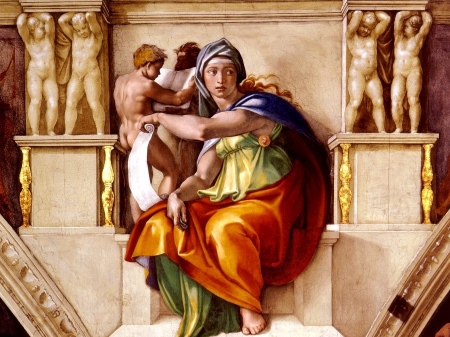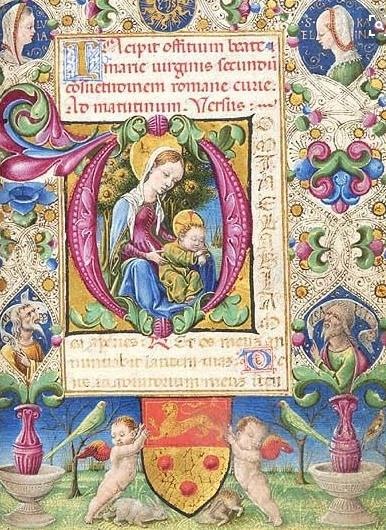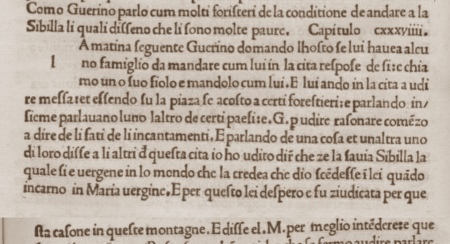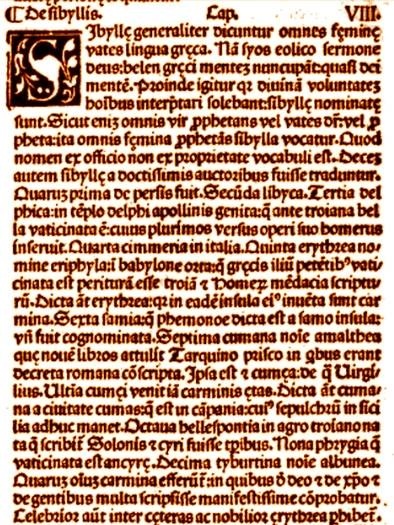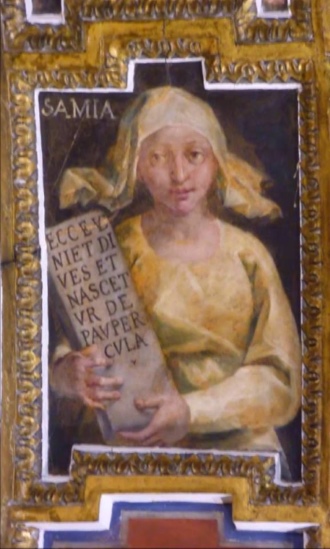16 Jul 2018
A Sibyl called Cimmerian: exploring the potential link to the Apennine Sibyl - 12. The path towards the true origin of the sibilline myth
We made a long journey throughout the centuries in search of the fourth Sibyl, the Cimmerian. We started from Francesco Maurolico, a sixteenth-century Sicilian abbot, and we went as far back as Lucius Caecilius Firmianus Lactantius and other classical Latin and Greek authors including Silius Italicus, Sextus Pompeius Festus, Pliny the Elder, Lycophrone of Chalcis, Sextus Aurelius Victor, Publius Vergilius Maro, St. Justin Martyr and Strabo. We have perused the works of Andrea da Barberino, Filippo Barbieri, the Muslim astronomer Albumazar, the fifteenth-century “Oracula Sibyllina”, and excerpts from later authors such as Juan Luis Vives, Michel Antoine Baudrand and Cesare Orlandi.
We have demonstrated that all the clues which refer to the Cimmerian Sibyl lead to Cumae, in the Italian province of Campania. Only abbot Francesco Maurolico seems to depart from this unanimous view, as he alone asserts that the fourth Sibyl, the Cimmerian, is in truth the Apennine Sibyl of Norcia.
At the present stage of our search, we do not have any clue as to why Maurolico (and apparently only Maurolico) holds such a belief. We could not retrieve any other earlier literary source conveying the same idea.
However, some pattern begins to appear amid the literary works, excerpts, passages, and mentions providing references to the world of the sibilline oracles: the Apennine Sibyl seems to present some kind of veiled, undeciphered connection to the Cumaean / Cimmerian Sibyl, as assumed by Andrea da Barberino in his fifteenth-century romance “Guerrino the Wretch” and Francesco Maurolico in his “Topographia”.
That is, some cryptic link is apparently arising between the Apennines, set in the vicinity of Norcia, and Cumae.
We still don't know what this relation might be. Better than that, we already hold a specific idea on this highly fascinating subject, but this idea is still untold. An obscure surmise which “The Apennine Sibyl - A Mystery and a Legend” will reconsider and develop in future articles, not yet published.
For the time being, we are leaving the reader with the suggestions connected to the ancient, long-vanished town of the Cimmerians, with all its mysterious spell that has bewitched men of letters of all times. A mystery we have tried to shed light upon, by walking the narrow paths traced by many authors of essays, romances and poems throughout many centuries.
An arcane travel which we want to conclude with the words written by the greatest poet of all, Homer, in his epic poem “Odyssey”. There, in Book 11, he speaks of the gloomy mystery of the Cimmerians:
«She [Odysseus' ship] came to deep-flowing Oceanus, that bounds the Earth, where is the land and city of the Cimmerians, wrapped in mist and cloud. Never does the bright sun look down on them with his rays either when he mounts the starry heaven or when he turns again to earth from heaven, but baneful night is spread over wretched mortals».
Odysseus lands «to the place of which Circe had told us»: «the house of Hades», where he performs the most frightful of all rites, the summoning of the dead from the Underworld, a gloomy ritual known as 'nekya'.
The Apennine Sibyl, the Cumaean Sibyl, the Cimmerian Sibyl, the Underworld. A legendary mystery that appears to be rooted in the deepest recesses of time, and human mind.
Una Sibilla chiamata Cimmeria: un'investigazione sulla possibile relazione con la Sibilla Appenninica - 12. Il cammino verso la vera origine del mito sibillino
Abbiamo compiuto un lungo viaggio attraverso i secoli alla ricerca della quarta Sibilla, la Cimmeria. Siamo risaliti da Francesco Maurolico, un abate siciliano vissuto nel sedicesimo secolo, fino a Lucio Cecilio Firmiano Lattanzio e ad altri autori latini e greci della classicità, tra i quali Silio Italico, Sesto Pompeo Festo, Plinio il Vecchio, Licofrone di Calcide, Sesto Aurelio Vittore, Publio Virgilio Marone, San Giustino Martire e Strabone. Abbiamo consultato i volumi di Andrea da Barberino, di Filippo Barbieri e dell'astronomo islamico Albumazar, e poi i quattrocenteschi "Oracula Sibillina" e brani tratti da autori più recenti quali Juan Luis Vives, Michel Antoine Baudrand e Cesare Orlandi.
Abbiamo dimostrato come tutti gli indizi connessi alla Sibilla Cimmeria conducano a Cuma, nella regione italiana della Campania. Solamente l'abate Francesco Maurolico pare distaccarsi da questa visione del tutto unanime, in quanto egli solo asserisce come la quarta Sibilla, la Cimmeria, sia in realtà la Sibilla Appenninica di Norcia.
Allo stadio attuale della nostra ricerca, non possiamo stabilire per quale motivo Maurolico (e, in tutta apparenza, solamente Maurolico) attesti questa posizione. Non è stato per noi possibile rintracciare alcuna ulteriore, e precedente, fonte letteraria che sostenga questa medesima idea.
Eppure, una flebile traccia sembra apparire tra le opere, i brani, i passaggi e le citazioni che si riferiscono al mondo degli oracoli sibillini: la Sibilla Appenninica pare presentare un qualche tipo di velato, indecifrabile collegamento con la Sibilla Cumana / Cimmeria, così come attestato da Andrea da Barberino nel romanzo quattrocentesco "Guerrin Meschino" e da Francesco Maurolico nella propria "Topographia".
In altre parole, una qualche sorta di nesso indistinto, enigmatico si starebbe delineando tra gli Appennini, che si ergono in prossimità di Norcia, e Cuma.
Ancora non sappiamo in cosa possa consistere esattamente questa relazione. O, meglio, abbiamo già una specifica idea in merito a questa tematica così altamente affascinante, ma questa idea è ancora inespressa. Un'ipotesi oscura, che "Sibilla Appenninica - Il Mistero e la Leggenda" ha intenzione di approfondire e sviluppare in futuri articoli, non ancora pubblicati.
Per il momento, vogliamo lasciare il lettore con le suggestioni legate all'antica città, da lungo tempo perduta, dei Cimmèri, con tutto il suo fascino misterioso e arcano, in grado di avvincere poeti e letterati di ogni epoca. Un mistero sul quale abbiamo tentato di gettare luce, percorrendo gli stretti sentieri tracciati da una pluralità di autori di saggi, romanzi e poemi nel corso di molti secoli.
Un viaggio arcano che vogliamo concludere con le parole scritte dal più grande poeta di ogni tempo, Omero, nella sua "Odissea". Qui, nel Libro 11, egli così ci racconta del tenebroso mistero dei Cimmèri:
«Essa [la nave di Ulisse] ai confini arrivò dell'Oceano corrente profonda, là dei Cimmèri è il popolo e la città, di nebbia e nube avvolti. Mai su di loro il sole splendente guarda coi raggi, né quando sale verso il cielo stellato, né quando verso la terra ridiscende dal cielo, ma notte tremenda grava sui mortali infelici».
Ulisse approda «al luogo che indicò Circe»: «la casa dell'Ade», presso cui egli effettua il più spaventoso dei riti, l'evocazione dei morti dall'Oltretomba, la cosiddetta 'nekya'.
Sibilla Appenninica, Sibilla Cumana, Sibilla Cimmeria, il mondo sotterraneo dei morti. Un mistero leggendario che pare trovare le proprie origini nei più nascosti recessi del tempo, e della mente umana.
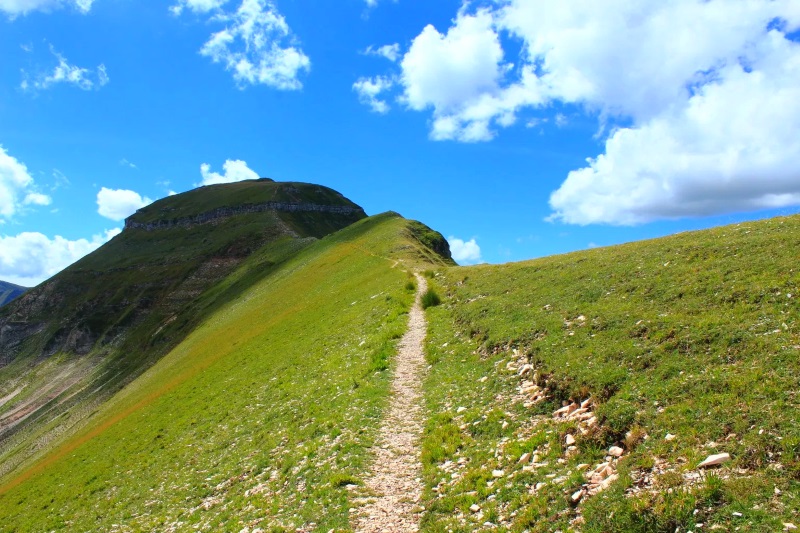

15 Jul 2018
A Sibyl called Cimmerian: exploring the potential link to the Apennine Sibyl - 11. It's a long way from the Cimerian Sibyl to the Apennines
When we began our investigation into the myth of the Cimmerian and Cumaean Sibyl, we started by considering a number of excerpts written by Francesco Maurolico in 1568.
In his “Topographia Sanctorum Christi Martyrum”, Maurolico states the following:
«The fourth Sibyl is the Cumaeam, whom Naevius mentions in his books about the Punic war, and Piso in his annals as well; from the Cimeriam castle, also known as the Cave of Norcia, which some call by the corrupted name of 'Cymea' or 'Cymica' [...] Cumae, a town of Campania lying by the gulf of Baiae. Here was the Cumaean Sibyl, who was also called Deiphobe, and by some named as Cimmeria or Cymica, but in truth the latter is a different one in the cavern of Norcia [....] Ameria, an Italian town set in the Sabine region. From this town the author names the 'Emerian Sibyl', who others call the 'Cimeriam' owing to the uncertainty of the place; she lives in the caverns of Norcia, and is different from both the Cumaean and the Tiburtine Sibyls».
When we started our exploration, we sensed that some kind of confusion affected Maurolico's words, with all his manifest efforts to corroborate the idea that the Apennine Sibyl, whose legend pertains to a cavern located in the mountains raising in the vicinity of Norcia, in central Italy, should be identified with the fourth Sibyl in Lactantius' list, the Cimmerian.
Is Maurolico right?
The right answer is no. And possibly, from a certain point of view, yes.
Maurolico is right when he says that the Cimmerian or Cumeam or Chemical Sibyl, the fourth Sibyl (see Fig .1), belongs to Cumae, as we ourselves have fully shown by our investigation. However, he is inconsistent when he says that the Cumaean is truly the Cimmerian, while in another passage he writes that the Cimmerian «is different from [...] the Cumaean»:
In addition to that, he is wrong when he expresses all his confidence in the unfounded assumption that the Sibyl of Norcia is Lactantius' Cimmerian Sibyl, the fourth sibilline oracle in the list, basing his surmise on the name of a village allegedly set by the Cave of Norcia, whose name is - according to Maurolico - 'Cimerian' or “Ameria'.
However, Maurolico's assumption is totally wrong. Because we have fully demonstrated that, in the antique tradition, the town of the Cimmerians was consistently situated by all ancient writers in Cumae, in the Italian province of Campania. Thus, Cimmerians had nothing to do with the Apennines, and equally they had nothing to do with Norcia. And the fourth Sibyl, the Cimmerian oracle, is not a Sibyl from Norcia, but a Sibyl from Cumae, as positively stated by all available classical authors.
Why did Maurolico incur this error?
His misleading statements appear to be the more perplexing when we consider that the identification of Cumae as the original place in which the fourth Cimmerian Sibyl vaticinated was not an unknown feature in Maurolico's times. Scholars of both his and later ages read the classical authors as we do today, and they found out the same pieces of information as we were able to retrieve in our present days: the Cimmerians lived by Cumae, and they had their prophesying Sibyl, who was called 'Cimmerian' after their own name.
Let's take, for instance, a commentary written in 1523 by Juan Luis Vives, a great sixteenth-century Spanish scholar, a book published in Antwerp in 1576 (Fig. 2). In commenting a famous excerpt drawn from Augustine of Hippo's “The City of God” (Book XVIII, Chapter XXIII), in which Augustine enlists the Sibyls as pagan heralds of the Salvation, Juan Luis Vives reports the famous list of ten Sibyls originally contained in Lactantius' “Divinae Institutiones”.
But, when he gets to the fourth Sibyl, he quotes the words by Lactantius with the addition of a highly remarkable sentence:
«The fourth [Sibyl is] Cumaean in Italy, whom Naevius mentions in his book on the Punic war, and Piso in his annals. Some call her Italian, from the Cimmerian town which is not far from Cumae in the Campania province».
[In the original Latin text: «Quarta [Sibylla est] Cumaea in Italia, quam Naevius in libris belli Punici, Piso in annalibus nominat. Hanc alij Italicam nuncupant, ex Cimerio Campaniae vicino Cumis oppido»].
Juan Luis Vives could not have been clearer than that: the fourth Sibyl is an Italian oracle from a small town near Cumae. And the town's name - as we know from antique authors - is Cimmerian.
And let's consider another work released a century later, the “Lexicon Geographicum” (“Geographical Dictionary”) published by a French scholar, Michel Antoine Baudrand, in 1652 (Fig. 3). Under letter 'C', we find another clear reference to the town of the Cimmerians:
«Cimmerians, population of Campania, in the vicinity of Baiae and the lake of Avernus, whose town was called Cimmerian, where the Sibyl's cave is, 'la grotta della Sibilla' [in Italian], 1 mile from Baiae and 3 miles from Pozzuoli».
[In the original Latin text: «Cimmerij item, pop. Campaniae, apud Baias et lacum Avernum, quorum opp. Cimmerium fuit, ubi antrum Sibyllae, 'la grotta della Sibilla', a Baiis 1 a Puteolis 3 milia passuum»].
Again, in the seventeenth century too the Cimmerians were placed in the vicinity of Lake Avernus, very far from central Apennines, where Norcia lies.
And here is another interesting example coming to us from a century later. In 1767, an Italian nobleman and scholar, Cesare Orlandi, who was born in an Umbrian town and whose family originated from the province of Marche, published an updated edition of a famous work, the “Iconologia”, originally edited by Cesare Ripa in 1593 (Fig. 4). In his own revised edition, Cesare Orlandi included a whole section on Sibyls, and the following is what he wrote on the Cimmerian:
«Cumean Sibyl, or Cimmerian: [...] she was born in Cumae, or in a Cimmerian village in the surroundings of Cumae, in the countryside of Naples. Many call her Italic, and it is reputed that she was vaticinating in Italy after the great fire of Troy; and of her, with full reason, we can reckon that she is the same as the Cumaean. Actually many authors report that this Sibyl was the Cumaean, to whom Vergilius pretends his characters turned for advice in Book 6 of his "Aeneid"».
[In the original Italian text: «Sibilla Cumea, ovvero Cimmeria: [...] Sibilla Cumea, ovvero Cimmeria: [...] Costei nacque in Cuma, o in Cimmerio paese vicino a Cuma nella Campagna di Napoli. Da molti è chiamata Italica, e si crede che abbia vaticinato in Italia poco dopo l'incendio di Troia; e di questa con tutta ragione si può pensare che fosse la stessa che la Cumana. Di più, non pochi riferiscono, che fosse Costei quella Sibilla, alla quale finge Virgilio nel lib. 6 'Eneid.' di esser ricorso per consiglio»].
Does Cesare Orlandi write that the Cimmerian Sibyl has any connection with a Sibyl in Norcia? Not at all. And this fact is of remarkable significance: because Cesare Orlandi was born in Città della Pieve, an Umbrian town, and his family came from Fermo, in the Marche region; if any relation had really existed between the Cimmerian and a Sibyl from Norcia - a town sitting between Umbria and Marche - Orlandi would certainly know, and would certainly tell. But he does not.
Thus, no doubt can still remain as to whether late-Renaissance scholars and later men of letters were fully informed about the true origin of the Cimmerian Sibyl: they knew that she had vaticinated in the area of Cumae, and no relation to the Apennines could be established in any way.
Definitely, Maurolico proves to be on the wrong side. But why was he so confident in his belief that the Apennine Sibyl was Lactantius' fourth Sibyl?
Though we have no conclusive information on that specific aspect, we will try to end our search with a few final consideration, which we will state in the next (and last) article.
Una Sibilla chiamata Cimmeria: un'investigazione sulla possibile relazione con la Sibilla Appenninica - 11. Lunga è la strada dalla Sibilla Cimmeria agli Appennini
Quando abbiamo cominciato la nostra investigazione attraverso il mito delle Sibille Cimmeria e Cumana, abbiamo preso le mosse da una serie di brani scritti da Francesco Maurolico nel 1568.
Nella sua “Topographia Sanctorum Christi Martyrum”, Maurolico si esprimeva nel seguente modo:
«La quarta Sibilla è la Cumea, di cui parla Nevio nei suoi libri dedicati alla Guerra Punica, a anche Pisone nei propri annali; dal castello Cimerio, conosciuto anche con il nome di Antro nursino, che alcuni chiamano con il nome corrotto di 'Cymea' o 'Cymica' [...] Cuma, città della Campania nel golfo di Baia. Qui fu la Sibilla Cumana, chiamata anche Deifobe, che alcuni indicano come Cimmeria o Cymica, se questa non fosse un diverso oracolo posto nella caverna di Norcia [...] Ameria, città dell'Italia posta nella regione Sabina. Da questa città l'autore denomina la 'Sibilla Emeria', che altri chiamano 'Cimeria' a causa dell'incertezza sul luogo; essa vive nell'antro di Norcia, ed è diversa sia dalla Cumana che dalla Tiburtina [...]».
Quando la nostra ricerca ha avuto inizio, non abbiamo potuto evitare di pensare che le parole di Maurolico fossero affette da un qualche genere di confusione, essendo evidente il suo palese tentativo di avallare l'idea che la Sibilla Appenninica, la cui leggenda riguarda una grotta collocata tra le montagne che si innalzano in prossimità di Norcia, nell'Italia centrale, dovesse essere identificata con la quarta Sibilla elencata nella lista di Lattanzio, la Cimmeria.
Ma Maurolico era veramente nel giusto?
La risposta corretta è no. E, forse, da un certo punto di vista, anche sì.
Maurolico, infatti, ha ragione quando afferma che la Sibilla Cimmeria o Cumea o Chimica, la quarta Sibilla (Fig. 1), appartiene a Cuma, come noi stessi abbiamo potuto dimostrare per mezzo della nostra investigazione. Invece, egli risulta essere in tutta evidenza inconsistente quando dichiara che la Cimmeria «è diversa [...] dalla Cumana».
Inoltre, egli prende un abbaglio quando manifesta di voler riporre ogni sua certezza nell'infondata ipotesi che la Sibilla di Norcia possa essere la Sibilla Cimmeria di Lattanzio, il quarto oracolo sibillino contenuto nell'enumerazione classica, basando la propria convinzione sul nome di un villaggio che esisterebbe nelle vicinanze della Grotta di Norcia, e il cui nome sarebbe - secondo Maurolico - 'Cimerio' o 'Amerio'.
Questa affermazione di Maurolico è totalmente errata. Abbiamo infatti pienamente dimostrato come, nella tradizione antica, la città dei Cimmèri fosse unanimemente collocata, da tutti gli autori classici, presso Cuma, nella provincia italica della Campania. Dunque, i Cimmèri non avevano nulla a che fare con gli Appennini, e parimenti nulla avevano a che fare con Norcia. E la quarta Sibilla, la Cimmeria, non è affatto una Sibilla di Norcia, ma una Sibilla di Cuma, come positivamente e indubitabilmente affermato da tutti i riferimenti testuali classici oggi disponibili.
Ma perché Maurolico cadde in questo errore?
Le sue fuorvianti affermazioni appaiono suscitare ancor maggiore perplessità quando si consideri che l'identificazione di Cuma come luogo originale presso il quale la quarta Sibilla, Cimmeria, vaticinava non costituiva affatto informazione ignota ai contemporanei di Maurolico. Gli studiosi del suo tempo e dei secoli successivi, infatti, erano in grado di leggere i testi degli antichi autori esattamente come noi facciamo oggi, e potevano reperire gli stessi elementi informativi che anche noi abbiamo potuto ritrovare ai nostri giorni: i Cimmèri vivevano a Cuma, e disponevano di una propria Sibilla oracolare, che era chiamata 'Cimmeria', traendo il proprio nome dall'appellativo stesso di quel popolo.
Prendiamo, ad esempio, un'opera scritta nel 1523 da Juan Luis Vives, un noto erudito spagnolo del sedicesimo secolo, un libro pubblicato in Anversa nel 1576 (Fig. 2). Nel commentare un famoso brano tratto da "La Città di Dio" di Agostino di Ippona (Libro XVIII, Capitolo XXIII), nel quale Agostino arruola le Sibille tra gli araldi pagani della Salvezza, Juan Luis Vives cita la famosa lista di dieci Sibille originariamente contenuta nelle "Divinae Institutiones" di Lattanzio.
Ma, quando egli arriva alla quarta Sibilla, Vives riferisce le parole di Lattanzio aggiungendo ad esse una frase ben significativa:
«La quarta [Sibilla è] la Cumea in Italia, di cui parla Nevio nei libri dedicati alla Guerra Punica, e anche Pisone nei propri annali. Alcuni la chiamano Italica, dalla città dei Cimmèri posta in prossimità di Cuma in Campania».
[Nel testo originale latino: «Quarta [Sibylla est] Cumaea in Italia, quam Naevius in libris belli Punici, Piso in annalibus nominat. Hanc alij Italicam nuncupant, ex Cimerio Campaniae vicino Cumis oppido»].
Juan Luis Vives non avrebbe potuto essere più chiaro: la quarta Sibilla è un oracolo italiano attivo in una piccola città posta presso Cuma. E l'appellativo della città - come già sappiamo dalle fonti antiche - è Cimmeria.
E proviamo a considerare un'altra opera diffusa nel secolo successivo, il “Lexicon Geographicum”, pubblicato da uno studioso francese, Michel Antoine Baudrand, nel 1652 (Fig. 3). Sotto la lettera 'C', troviamo un ulteriore, chiarissimo riferimento alla città dei Cimmèri:
«Cimmèri, popolazione della Campania, nell'area di Baia e del Lago d'Averno, la cui città fu chiamata Cimmeria, presso cui si trova l'antro della Sibilla, 'la grotta della Sibilla', 1 miglio da Baia e 3 miglia da Pozzuoli».
[Nel testo originale latino: «Cimmerij item, pop. Campaniae, apud Baias et lacum Avernum, quorum opp. Cimmerium fuit, ubi antrum Sibyllae, 'la grotta della Sibilla', a Baiis 1 a Puteolis 3 milia passuum»].
Ed ecco che, di nuovo, anche nel diciassettesimo secolo i Cimmèri venivano posizionati presso il Lago d'Averno, quindi molto lontano dall'Appennino umbro-marchigiano, dove si trova Norcia.
Ed ecco un ulteriore interessantissimo esempio, a noi proveniente dal secolo ancora successivo. Nel 1767, un aristocratico ed erudito italiano, Cesare Orlandi, nato in una città dell'Umbria e la cui famiglia era originaria delle Marche, pubblicò una edizione aggiornata di un'opera molto rinomata, il cui titolo era "Iconologia", originariamente data alle stampe da Cesare Ripa nel 1593 (Fig. 4). Nella propria edizione riveduta e ampliata, Cesare Orlandi inserì anche un'intera sezione dedicata alle Sibille, ed ecco ciò che egli scrisse a proposito della Cimmeria:
«Sibilla Cumea, ovvero Cimmeria: [...] Costei nacque in Cuma, o in Cimmerio paese vicino a Cuma nella Campagna di Napoli. Da molti è chiamata Italica, e si crede che abbia vaticinato in Italia poco dopo l'incendio di Troia; e di questa con tutta ragione si può pensare che fosse la stessa che la Cumana. Di più, non pochi riferiscono, che fosse Costei quella Sibilla, alla quale finge Virgilio nel lib. 6 'Eneid.' di esser ricorso per consiglio».
Cesare Orlandi ha forse scritto che la Sibilla Cimmeria presenta una qualsivoglia connessione con una Sibilla degli Appennini? Niente affatto. E, in effetti, questo elemento appare essere estremamente significativo: perché Cesare Orlandi era nato a Città della Pieve, città dell'Umbria, e la sua famiglia proveniva da Fermo, nelle Marche: se una qualsiasi relazione fosse realmente esistita tra la Cimmeria e una Sibilla di Norcia - città posta esattamente tra l'Umbria e le Marche - Orlandi lo avrebbe certamente saputo, e lo avrebbe sicuramente riferito e scritto. Ma egli non lo fa.
Dunque, nessun dubbio può ancora sussistere in merito al fatto che gli eruditi e gli studiosi del tardo Rinascimento, nonché i letterati dei secoli successivi, avessero piena cognizione della reale origine della Sibilla Cimmeria: essi sapevano che quell'oracolo aveva reso i propri vaticini nell'area di Cuma, e che non esisteva alcun motivo o ragione per collegare in alcun modo quella Sibilla con la catena degli Appennini.
È quindi un dato di fatto che Maurolico risulta trovarsi dal lato del torto. Ma come è possibile che egli si dichiari così sicuro della propria convinzione a proposito dell'identificazione tra Sibilla Appenninica e quarta Sibilla di Lattanzio?
Benché non disponiamo attualmente di alcuna informazione decisiva in merito a questa specifica questione, tenteremo comunque di concludere la nostra ricerca con alcune considerazioni finali, che andremo a esplicitare nel prossimo (e ultimo) articolo.
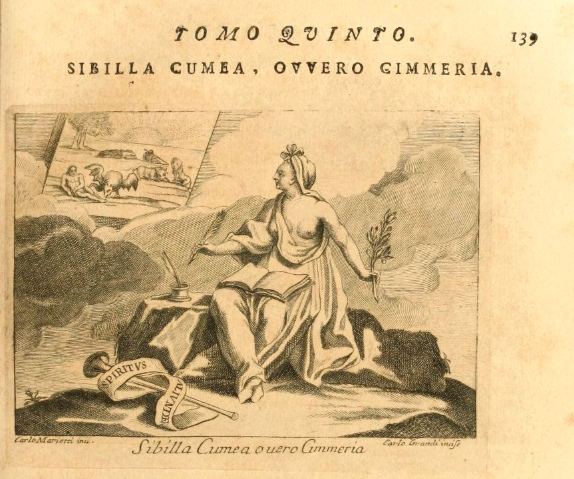

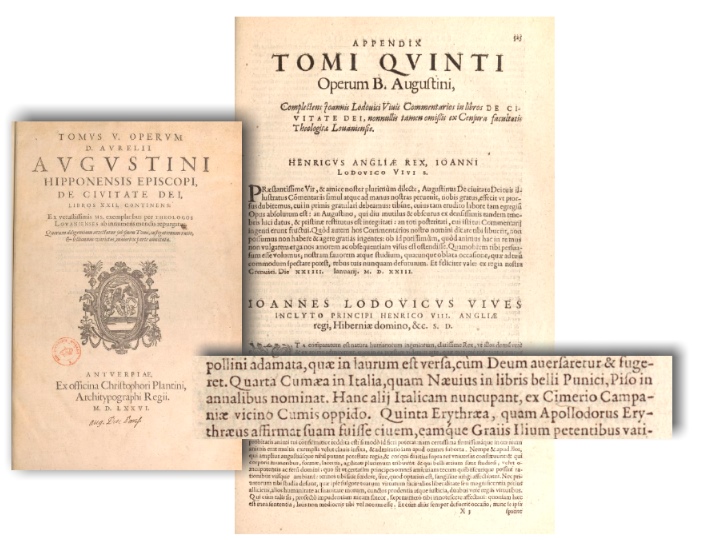

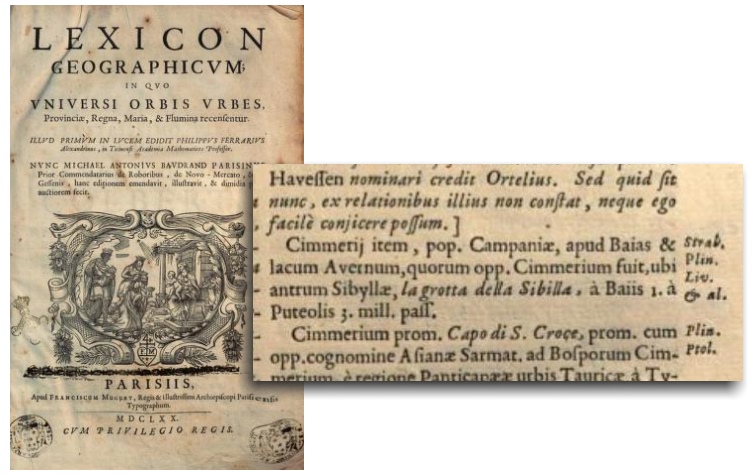

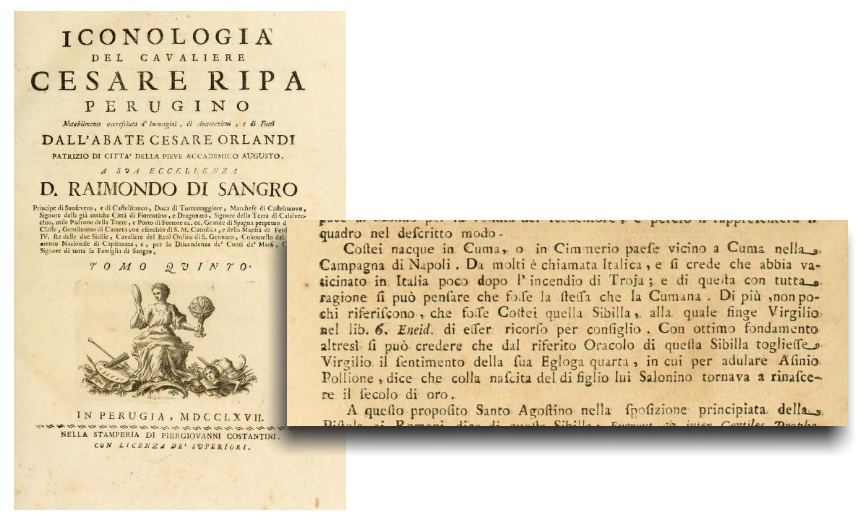

12 Jul 2018
A Sibyl called Cimmerian: exploring the potential link to the Apennine Sibyl - 10. The Cimmerian Sibyl as an earlier Cumaean
When the Roman Empire was flourishing, the Cimmerians too had already become a legendary population long vanished from the sight of history, just like the Cumaean Sibyl who had disappeared centuries earlier. For the Romans themselves, Cimmerians were but a faint recollection: a legendary population whose subterranean abode once concealed by the Lake Avernus was extant nomore already in the early Roman age. Not the least remnant of their subterranean dwellings and tunnels is to be found in our present days, and the more so if we consider the destructive earthquakes that have repeatedly been striking the area of Lake Avernus and the Phlegraean Fields across the centuries (for instance, let's consider the 1538 earthquake when a small volcano, Monte Nuovo, was generated in a handful of days).
Despite all that, Strabo, who writes in the first century, reports an additional, remarkable detail (Fig. 2):
«Later on the Cimmerians were destroyed by a certain king, because the response of the oracle did not turn out in his favour; the seat of the oracle, however, still endures, although it has been removed to another place».
[In the Latin translation from the original Greek text: «postea temporis Cimmerios fuisse deletos a rege quodam, cuius eventa oraculum non comprobassent, sedem oraculi alio translatam etiamnun durare»].
According to Strabo, at his age Cimmerians had already been wiped out centuries earlier. In another passage we already quoted, it's Strabo himself who adds that «Ephorus maintained that this site was of the Cimmerians, about whom he says that they dwell in underground premises» [«Ephorus vero Cimmeriis locum illum dicans, hos abitare ait in subterraneis aedificiis» in Latin]. And Ephorus was a local historian, who lived in Cumae during the fourth century B.C. (his books no longer exist).
This means that Cimmerians vanished from Lake Avernus centuries and centuries before the arrival of the Romans in Cumae, but «the seat of the oracle, however, still endures, although it has been removed to another place».
Could it be that the Cimmerian Sibyl, who provided her responses in an underground site in Cumae by querying the dead through necromantic practices, had subsequently moved to another shrine, again situated in the town of Cumae, following the destruction of her original site, and that the Sibyl at the new site had taken the name of 'Cumaean'?
Could it be that the original, antique Cimmerian Sibyl had taken on the final name of 'Cumaean Sibyl', after having abandoned her former subterranean site, following its obliteration?
According to many scholars, the answer is positive. Jacques Hergon, a renowned French latinist, and other researchers (Luca Antonelli) consider the Cimmerian Sibyl as an early prophetess providing responses in the area of Cumae, by querying the dead through necromancy. Later on, after the destruction of her original underground shrine, the oracle moved to another temple in downtown Cumae, assuming the name of 'Cumaean Sibyl', providing her prophecies by writing them on a multiplicity of oak leaves, and then letting the leaves whirl freely in the whiffs of the wind («volent rapidis ludibria ventis», as Vergilius says), so as to render the oracular response almost incomprehensible.
So, the Cimmerian Sibyl and the Cumaean Sibyl would actually be the same prophetess, the former being only an earlier name for the latter.
This identity would provide a full explanation for the suspicious confusion in the names attributed to the fourth Sibyl which arises in different versions of the list stated by Lactantius: 'Cimmeriam' in some of them, and 'Cumeam' in other manuscripts. In the suggested theory, the fourth Sibyl would be just identical to the seventh, the Cumaeam, but called by her original, more ancient name.
And another peculiar literary intricacy, connected to the description of the Cumaean Sibyl provided by Vergilius in his “Aeneid”, would find its correct solution.
In Book VI, Vergilius says that, after arriving in Cumae, «Aeneas the pious ascends the citadel which is ruled by glorious Apollo and heads to the ghastly, secret recesses, the huge cavern of the Sibyl» («pius Aeneas arces, quibus altus Apollo presidet horrendaque procul secreta Sibyllae antrum immane petit» in Latin). He is visiting what is to be identified with the Cumaean Sibyl, who provides her responses acting as the voice of Greek deity Apollo:
«Such reins Apollo shakes in the body of the frenzied prophetess, and such spurs he urges in her heart».
[In the original Latin text: «ea frena furenti concutit et stimolos sub pectore vertit Apollo»].
But then, later in the same Book, the Sibyl commands Aeneas to make an offering to Hecate, the Greek goddess associated to witchcraft and necromancy, and the rite is carried out at a cave by the Lake Avernus. Now, the Sibyl has taken on the full attributes of the older Cimmerian prophetess:
«A deep cave was there, with a huge, frighful opening, hard to reach, protected by the gloomy lake and the darkness of the woods [... Aeneas] put the offerings on the sacred fire, a prominent donation, appealing to Hecate by his voice, calling to the heaven and to vast Erebus».
[In the original Latin text: «Spelunca alta fuit vastoque inmanis hiatu, scrupea, tuta lacu nigro nemoremque tenebris [...] ignibus imponit sacris, libamina prima, voce vocans Hecaten caeloque Ereboque potentem»].
In the above excerpts, Vergilius would be just portraying the two aspects of the Cimmerian / Cumaean Sibyl: the necromantic prophetess (Cimmerian) and the oracle of Apollo (Cumaean). Two different aspects for the same Sibyl: the Sibyl of Cumae.
A Sibyl who re-emerges from the mists of a lost, almost forgotten past, as portrayed in a most precious illuminated manuscript (Vat. Lat. 3225) preserved at the Vatican Apostolic Library in Rome: one of the most ancient manuscripted relics coming to us from the classical Roman world, dating back to the fourth century and featuring a stunning picture of Aeneas and his comrade Achates as they stand before the Cumaean Sibyl and her shrine dedicated to Apollo (Fig. 1).
We are getting closer and closer to the end of our amazing journey into myth and sibilline lore. Time has come now to provide an answer to the initial question we had posed at the very beginning of our travel: is the Apennine Sibyl, the Sibyl of Norcia, connected in any way to the Cimmerian Sibyl, as alleged by a sixteenth-century abbot from Sicily, Francesco Maurolico, in his “Topographia Sanctorum Christi Martyrum”?
The answer seems now to be clear. And we will detail it in the next article.
Una Sibilla chiamata Cimmeria: un'investigazione sulla possibile relazione con la Sibilla Appenninica - 10. La Sibilla Cimmeria, antecedente della Cumana
Quando l'Impero Romano giungeva all'apice della propria potenza, anche i Cimmèri erano già divenuti un popolo leggendario, svanito da tempo dal teatro della storia, proprio come accaduto anche alla Sibilla Cumana, scomparsa già da molti secoli. Per gli stessi Romani, i Cimmèri non costituivano altro che un flebile ricordo: una popolazione leggendaria, le cui dimore sotterranee, un tempo celate in prossimità del Lago d'Averno, non esistevano già più sin dall'epoca in cui Roma era ancora giovane. Ai nostri giorni, nemmeno le più insignificanti vestigia di quelle residenze occultate nella terra, né di quei tunnel, possono essere più rintracciate in alcun modo, e questa impossibilità risulta essere tanto più evidente quando si considerino i terremoti e gli eventi catastrofici che hanno ripetutamente colpito il Lago d'Averno e i Campi Flegrei nel corso dei secoli (pensiamo, ad esempio, al sisma del 1538, in concomitanza del quale un piccolo vulcano, il Monte Nuovo, si innalzò dalla terra nel corso di una manciata di giorni).
Malgrado ciò, Strabone, che scrive nel primo secolo, ci rende disponibile un dettaglio aggiuntivo di grande rilevanza (Fig. 2):
«Successivamente i Cimmèri furono distrutti da un certo re, al quale i responsi oracolari non risultarono graditi; ma la sede dell'oracolo esiste ancora oggi, benché essa sia stata trasferita in altro luogo».
[Nella traduzione latina dall'originale greco: «postea temporis Cimmerios fuisse deletos a rege quodam, cuius eventa oraculum non comprobassent, sedem oraculi alio translatam etiamnun durare»].
È possibile ipotizzare che la Sibilla Cimmeria, la quale forniva responsi oracolari presso un sito sotterraneo nell'area di Cuma, interrogando i morti tramite pratiche negromantiche, abbia subìto un trasferimento presso un altro e diverso santuario, situato nella medesima area cumana, a seguito della distruzione della propria sede originale, e che il nome assunto dalla Sibilla nel nuovo sito sia proprio 'Cumana'?
È possibile che l'antica, originale Sibilla Cimmeria abbia acquisito il nome finale di 'Sibilla Cumana', dopo l'abbandono del proprio precedente sito sotterraneo, a causa dell'obliterazione dello stesso?
Secondo molti studiosi, la risposta a queste domande sarebbe positiva. Jacques Hergon, un celebre latinista francese, e altri ricercatori (Luca Antonelli) considerano la Sibilla Cimmeria come la più antica profetessa attiva nell'area cumana, operante con tecniche di tipo negromantico. In seguito, dopo la distruzione del tempio sotterraneo originale, l'oracolo si sarebbe trasferito in un diverso sito posto nell'area centrale di Cuma, assumendo il nome di 'Sibilla Cumana' e rendendo le proprie profezie mediante scrittura di vaticini eseguita su di una pluralità di foglie di quercia, abbandonate poi al libero gioco del vento («volent rapidis ludibria ventis», come racconta Virgilio), in modo tale da rendere il responso oracolare sostanzialmente incomprensibile.
Dunque, la Sibilla Cimmeria e la Sibilla Cumana non sarebbero altro che la medesima profetessa, la prima rappresentando semplicemente il nome più antico della seconda.
Questa identificazione sarebbe in grado di spiegare in modo del tutto esaustivo quella sospetta confusione tra i vari appellativi attribuiti alla quarta Sibilla, così come indicati nelle differenti versioni dell'antica enumerazione delineata da Lattanzio: 'Cimmeria', secondo alcune di esse, e 'Cumana' in altri manoscritti. Secondo questa ipotesi, la quarta Sibilla sarebbe fondamentalmente identica alla settima, la Cumana, ma ad essa sarebbe attribuito il nome originale e più antico.
E anche un altro peculiare enigma letterario, connesso alla descrizione della Sibilla Cumana così come proposta da Virgilio nella sua "Eneide", potrebbe trovare, in questo modo, la propria corretta soluzione.
Nel libro VI, Virgilio racconta di come, dopo il suo arrivo a Cuma, «il pio Enea ascenda la cittadella, retta dal glorioso Apollo, recandosi all'antro profondo, orrendo e appartato della Sibilla» («pius Aeneas arces, quibus altus Apollo presidet horrendaque procul secreta Sibyllae antrum immane petit» in latino). Egli sta per visitare quella che deve essere identificata come la Sibilla Cumana, la quale fornisce i propri responsi esprimendo la voce e la volontà del dio greco Apollo:
«Tali sono le redini che Apollo scuote nella furente profetessa, e tali gli speroni che il dio le urge nel petto».
[Nel testo originale latino: «ea frena furenti concutit et stimolos sub pectore vertit Apollo»].
Ma poi, successivamente, nel medesimo libro, la Sibilla ordina a Enea di presentare un'offerta a Ecate, la dea greca associata alla stregoneria e alla negromanzia, e il rituale viene posto in atto in una grotta posta presso il Lago d'Averno. Ora, la Sibilla ha assunto tutti gli attributi della più antica profetessa Cimmeria:
«Una profonda spelonca era lì, una vasta, immensa fenditura, difficile da penetrare, protetta dal lago nero e dalla tenebra delle selve [... Enea] pone l'offerta sul fuoco sacro, dono copioso, evocando Ecate con la propria voce, invocando i cieli e il vasto Erebo».
[Nel testo originale latino: «Spelunca alta fuit vastoque inmanis hiatu, scrupea, tuta lacu nigro nemoremque tenebris [...] ignibus imponit sacris, libamina prima, voce vocans Hecaten caeloque Ereboque potentem»].
Nei brani qui citati, Virgilio non starebbe facendo altro che porre in scena i due differenti aspetti della Sibilla Cimmeria / Cumana: la profetessa che si avvale di arti negromantiche (Cimmeria) e l'oracolo di Apollo (Cumana). Due diverse rappresentazioni della stessa Sibilla: la Sibilla di Cuma.
Una Sibilla che riemerge dalle nebbie di un passato perduto e quasi dimenticato, così come rappresentata nel preziosissimo manoscritto miniato dell''Eneide' (Vat Lat 3225) conservato presso la Biblioteca Apostolica Vaticana: uno dei reperti manoscritti più antichi dell'intero mondo classico romano, risalente addirittura al quarto secolo, con una stupenda immagine di Enea e del suo compagno Acate raffigurati mentre si presentano innanzi alla Sibilla Cumana e al suo tempio apollineo (Fig. 1).
Ci stiamo avvicinando sempre di più al termine del nostro incredibile viaggio attraverso il mito e le tradizioni sibilline. È giunto ora il momento di rispondere alla domanda iniziale, quella che ci eravamo posti quando abbiamo cominciato il nostro percorso: la Sibilla Appenninica, la Sibilla di Norcia, è forse collegata in qualche modo con la Sibilla Cimmeria, così come sostenuto da un abate siciliano vissuto nel sedicesimo secolo, Francesco Maurolico, nella sua “Topographia Sanctorum Christi Martyrum”?
La risposta, adesso, ci appare assolutamente chiara. E andremo ad esplicitarla nel prossimo articolo.
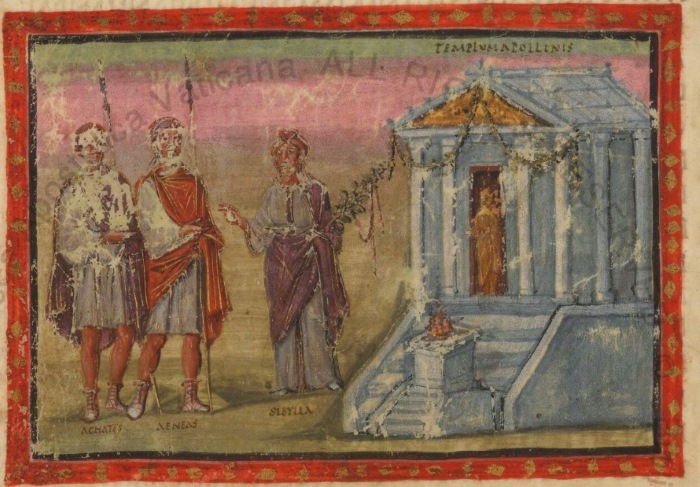



9 Jul 2018
A Sibyl called Cimmerian: exploring the potential link to the Apennine Sibyl - 9. Cumaen and Cimmerian, a single Sibyl for Cumae
Cumae, one of the most ancient Greek colonies in southern Italy, established at the mid of the eighth century B.C., a town that was regarded as sacred to ctonian deities owing to its highly peculiar volcanic nature.
As we saw already, according to the available documents describing the traditions of ancient Rome, two sibilline oracles were to be found in Cumae: the Cumaean Sibyl and the Cimmerian Sibyl (both portrayed in Fig. 1 as they appear in a most precious Book of Hours dating to year 1427, preserved at the Bibliothèque Nationale de France in manuscript Latin 920).
Were they different Sibyls? Did they have any relationship one another? And are there any visible remnants of their shrines? What do contemporary archeology and modern history research have to tell us about them?
Let's consider the most famous prophetess, the Cumaean Sibyl: the seventh oracle in Lucius Caecilius Firmianus Lactantius' classical list. She was also celebrated by Vergilius in Book 6 of “Aeneid” with masterful verses: «terrific riddles she yells, as she sings in her cave, the truth enshrouded in darkness» [«Cumaea Sibylla - horrendas canit ambages antroque remugit - obscuris vera involvens» in Latin]. And we cannot forget the amazing portrait of a withered, ever-ageing Sibyl subject to a doom of immortality, as provided to us by Publius Ovidius Naso in his “Metamorphoses”, with a final stroke being painted by Gaius Petronius Arbiter, in his “Satyricon”, in which a shrunken Cumaean Sibyl, confined in a flask, asks visitors for a merciful death.
The literary tradition on the Cumaean Sibyl seems unmistakable, and it appears to depict some sort of oracle that really existed in ancient times.
However, the topic is not so easily managed. The Sibyl's Cave discovered in Cumae by an Italian archeologist, Amedeo Maiuri, in 1932 and shown to visitors in our present days is not recognised by scholars as the veritable site where the Cumaean Siby vaticinated. No archeological evidence of such an attribution has ever been found at the place. No positive, glaring oracular site has yet been identified in the existing area of ancient Cumae.
The actual problem is that, already in antique times, the Cumaean Sibyl was not active anymore. When Vergilius, Ovidius, Petronius and Lactantius wrote their works, the Sibyl had long transfomed herself into a remote legend, lost in the mists of the past. Romans never knew nor saw this Sibyl in her actual reality, for she belonged to the long-gone Greek past of Cumae, a town which the Romans conquered in year 338 B.C., four hundred years after its foundation. Rieuwerd Buitenwerf, a Dutch scholar, says with an incisive remark on the Cumaean oracle that «its location had already been forgotten by the time Virgil visited Cumae».
In the fourth century of the Christian era, Cumae had become a celebrated attraction for turists who - just as today - wanted to see the site of the legendary Sibyl chanted by Vergilius. And sure enough the locals did not restrain themselves from telling paying visitors what they wanted to hear, as narrated in the “Exhortation to the Greeks” (Chapter 39 - see Fig. 2), a Greek text once attributed to St. Justin Martyr:
«Easily you will learn the right religion from the ancient Sibyl, who used to teach through some kind of amazing inspiration by means of oracular predictions. [...] She, they say, rendered her prophecies in a city called Cumae, six miles from Baiae (where the hot springs of Campania are found). When we arrived in this city, we saw a certain place where we discerned a huge basilica, hewn out of one rock [...] People who had received the local tradition from their own ancestors, told us that this was the very place where the prophetess used to utter her oracles. [...] When we were in the city, we learned this things ourselves from the ones who use to guide the visitors around to see the remarkable places in the area. They showed us also [...] a small artifact, made of bronze, in which they said her remains were kept».
[In the Latin translation from the original text in Greek: «Perfacile autem vobis erit rectam religionem [...] a veteri Sibylla ex afflatu quodam mirifico per sortes ac responsa vos docente percipere. [...] Eam in Campaniae [...] in urbe quadam cui Cumae nomen est, sexto a Baiis (qui locus thermas Campanas habet) lapide, oracula edidisse. Vidimus nos ea in urbe cum essemus, locum quendam, in quo ingentem basilicam, uno fabrefactam saxo contemplati sumus [...] ubi responsa eam dedisse affirmabant illi, qui res patrias a majoribus suis traditas acceperint. [...] Quin ipsi quoque, cum in ube ea essemus, indicibus, qui hospites ad ea, quae visenda sunt, ducere solent, ostendentibus [...] vidimus loculum quendam ex aere elaboratum ubi reliquias ejus servari dicebant»].
So the actual, physical reality of the Cumaean Sibyl and her shrine appears to be lost forever, and that loss had already taken place at the time when Romans won Cumae for themselves.
And now, what about the Cimmerian Sibyl? If we start considering the Sibyl of the Cimmerians, the mist of history turns out to be even thicker. Let's try to dispel it, at least partially, in the next article.
Una Sibilla chiamata Cimmeria: un'investigazione sulla possibile relazione con la Sibilla Appenninica - 9. Cumana e Cimmeria, una sola Sibilla per Cuma
Cuma, una delle più antiche colonie greche nell'Italia meridionale, fondata a metà dell'VIII secolo a.C., una città che fu considerata come sacra alle divinità ctonie a causa della peculiarissima natura vulcanica di quel territorio.
Come abbiamo avuto modo di vedere, sulla base della documentazione disponibile relativamente alle tradizioni di Roma antica, Cuma ospitava due specifici oracoli sibillini: la Sibilla Cumana e la Sibilla Cimmeria (entrambe rappresentate in Fig. 1 così come appaiono in un preziosissimo Libro delle Ore risalente all'anno 1427, conservato presso la Bibliothèque Nationale de France all'interno del manoscritto Latin 920).
Si trattava veramente di oracoli differenti? Esisteva una relazione tra di essi? Esistono ancora resti visibili dei relativi luoghi di culto? Cosa possono raccontarci oggi, di esse, l'archeologia e le moderne ricerche storiche?
Prendiamo in esame la profetessa di maggior fama, la Sibilla Cumana: il settimo oracolo, nell'elencazione classica di Lucio Cecilio Firmiano Lattanzio. Essa fu anche celebrata da Virgilio nel sesto libro dell'"Eneide", con versi immortali: «enigmi paurosi essa canta mugghiando nell’antro, la verità avvolgendo di tenebra» [«Cumaea Sibylla - horrendas canit ambages antroque remugit - obscuris vera involvens» in latino]. E non possiamo nemmeno dimenticare l'impressionante immagine di una Sibilla decrepita e soggetta ad un invecchiamento senza fine, tramandataci da Publio Ovidio Nasone nelle sue "Metamorfosi", con un tocco finale dipinto per noi da Gaio Petronio Arbitro, nel suo "Satyricon", nel quale una Sibilla Cumana ormai avvizzita e ridotta ad un essere minuscolo, confinata in un'ampolla, implora i suoi visitatori affinché le sia finalmente concessa una morte misericordiosa.
La tradizione letteraria concernente la Sibilla Cumana appare dunque indubitabile, e pare effettivamente che essa descriva una qualche tipologia di oracolo realmente esistente in tempi molto antichi.
Eppure, l'intera materia non pare affatto presentarsi come definitivamente consolidata. L'Antro della Sibilla scoperto a Cuma nel 1932 da un archeologo italiano, Amedeo Maiuri, e mostrato oggi ai turisti non è affatto riconosciuto dagli studiosi come l'autentico sito presso il quale la Sibilla Cumana rendeva i propri vaticini. Nessuna evidenza archeologica in grado di confermare questa attribuzione è stata mai reperita nei locali sotterranei. E nessun sito manifestamente, indubitabilmente oracolare è stato mai identificato nell'attuale area dell'antica Cuma.
Il vero problema, infatti, è che già nell'antichità la Sibilla Cumana non era più attiva da lungo tempo. Quando Virgilio, Ovidio, Petronio e Lattanzio scrivono le rispettive opere, la Sibilla ha già compiuto la propria trasformazione da oracolo a leggenda nebulosa e remota, perduta tra le nebbie del passato. I Romani non conobbero né videro mai questa Sibilla nella sua tangibile realtà, in quanto essa già apparteneva, ormai, al lontano passato della Cuma greca, che fu conquistata dai Romani nell'anno 338 a.C., quattrocento anni dopo la fondazione dell'insediamento. Rieuwerd Buitenwerf, uno studioso olandese, afferma con un'incisiva osservazione a proposito dell'oracolo cumano che «la sua esatta localizzazione era stata già da tempo dimenticata all'epoca in cui Virgilio visitò Cuma».
Nel quarto secolo dell'era cristiana, Cuma si era già trasformata in una rinomata attrazione per i turisti dell'epoca, i quali - esattamente come accade anche oggi - volevano visitare il luogo dove aveva profetato la leggendaria Sibilla cantata da Virgilio. E la gente del luogo non si tirava certamente indietro nel narrare ai visitatori paganti ciò che essi volevano sentirsi dire, come ci viene raccontato nell'"Esortazione ai Greci" (Capitolo 39 - vedere Fig. 2), testo in lingua greca attribuito a S. Giustino Martire:
«Facilmente apprenderai la retta religione [...] dall'antica Sibilla, che insegnò attraverso una sorta di mirabile ispirazione per mezzo di responsi oracolari [...] Si racconta di come essa rendesse le proprie profezie in una certa città chiamata Cuma, a sei miglia da Baia (dove si trovano le acque calde della Campania). Quando giungemmo in città, visitammo un certo luogo nel quale si poteva vedere una grande basilica, tagliata all'interno di una grande roccia [...] La gente, alla quale era stata tramandata questa tradizione locale dai propri avi, ci raccontò che questo era il luogo in cui la profetessa era solita pronunciare i propri oracoli. [...] Quando fummo in città, potemmo apprendere queste cose da coloro che erano soliti fare da guida ai visitatori, per mostrare loro i luoghi notevoli. [...] Ci mostrarono anche [...] un piccolo contenitore, fatto di bronzo, all'interno del quale essi affermavano che fossero ancora custoditi i suoi resti».
[Nella traduzione latina dal testo greco originale: «Perfacile autem vobis erit rectam religionem [...] a veteri Sibylla ex afflatu quodam mirifico per sortes ac responsa vos docente percipere. [...] Eam in Campaniae [...] in urbe quadam cui Cumae nomen est, sexto a Baiis (qui locus thermas Campanas habet) lapide, oracula edidisse. Vidimus nos ea in urbe cum essemus, locum quendam, in quo ingentem basilicam, uno fabrefactam saxo contemplati sumus [...] ubi responsa eam dedisse affirmabant illi, qui res patrias a majoribus suis traditas acceperint. [...] Quin ipsi quoque, cum in ube ea essemus, indicibus, qui hospites ad ea, quae visenda sunt, ducere solent, ostendentibus [...] vidimus loculum quendam ex aere elaboratum ubi reliquias ejus servari dicebant»].
E così la presenza reale, attuale della Sibilla Cumana e del suo tempio oracolare pare ormai essere andata perduta per sempre, e questa perdita aveva già avuto luogo quando i Romani conquistarono Cuma per se stessi.
E la Sibilla Cimmeria? Se adesso cominciamo a prendere in considerazione la Sibilla dei Cimmèri, le nebbie della storia non possono che apparire ancor più fitte di fronte ai nostri occhi. Proviamo a disperderle, almeno in parte, nel prossimo articolo.
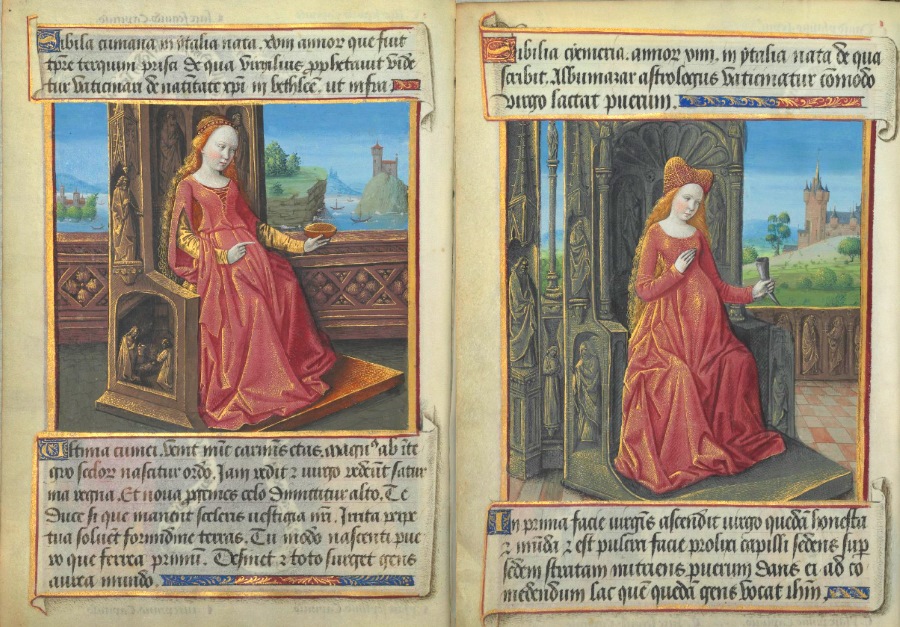

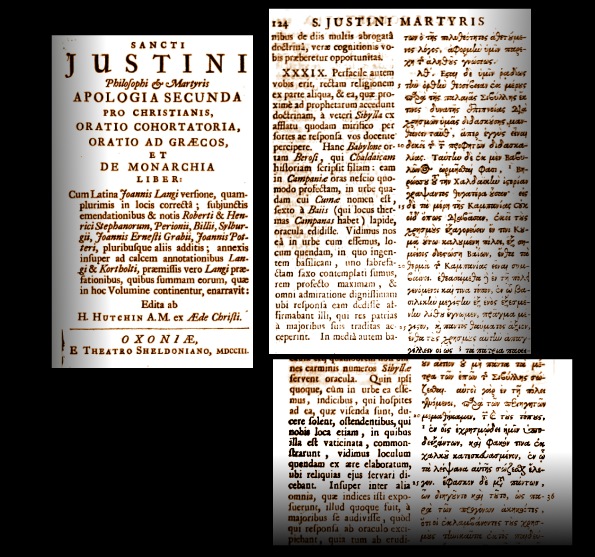

3 Jul 2018
A Sibyl called Cimmerian: exploring the potential link to the Apennine Sibyl - 8. Cumae, a land of netherworld gods
After a close scrutiny of a number of ancient literary sources, we found out that the Cimmerian Sibyl belongs to the area of the Lake Avernus, in the Italian region of Campania: only a mile away from the traditional site where the Cumaean Sibyl is said to have rendered her oracular responses by the ancient town of Cumae.
This result - which is already well known by scholars - should not be considered as unexpected. When we started our investigation, we noted, as many scholars did in the past, that in the classical enumeration of ten oracles set down by Lactantius the seventh Sibyl was the Cumaean («Cumana» in Latin), and the fourth the Cimmerian; however, in some versions of Lactantius' “De Divinis Institutionibus” the fourth oracle appears with the attribute “Cumean”: a name that cannot but remind us of the antique town of Cumae, and an attribute providing a strong clue as to where to direct our research efforts.
And finally we caught the Cimmerian Sibyl in very region of Cumae. But why should there be two different Sibyls in the same area, a Cumaen and a Cimmerian?
First, we have to bear in mind the utterly peculiar nature of this portion of Italian land.
Let's fly over this corner of Campania, in southern Italy, by considering the attached map: we are hovering on a territory which is heavily, permanently marked by the mightiest subterranean powers in Europe. A land blessed - and doomed - by the Gods of the Netherworld.
Eastward of Cumae and Cape Misenus, since time immemorial, the ground has been ravaged by the fury of volcanoes. We are in the most renowned Phlegraean Fields, a large volcanic area hiding one of the most dangerous, and still active today, subterranean magmatic chambers in the world.
The Lake Avernus itself, at the center of the image, is a volcanic crater lake, once encircled by gloomy hills covered with mysterious woods. Strabo says that «the birds that cross the lake fall down into the waters, being killed by the vapours that rise from it, as it happens for places which are linked to the Netherworld» («aves quae supervolarent in aquam decidere, exanimatas aeris exhalatione, quemadmodum i Plutonijs locis fit» in Latin). A number of additional volcanic calderas (Mount Barbaro, the large Astroni crater, and many others) are present in the top side of the picture, including the small yet impressive Monte Nuovo ('The New Mountain'), a tiny volcano which was created from nothing by a sudden eruption which took place between September, 29 and October, 6 1538. Earthquakes, emission of volcanic gases and measurable displacements of the ground (a phenomenon known as 'bradyseism') have always happened there.
No wonder that this land has always been considered as sacred to subterranean, divine powers. In Book 6 of his “Aeneid”, Publius Vergilius Maro sends Aeneas to the shore of Cumae, in search of the entryway to the underworld, «protected by the gloomy lake and the darkness of the woods» («tuta lacu nigro nemorumque tenebris» in Latin). And, according to many scholars, Lake Avernus was actually seen by ancient Romans as the entrance to Hades.
In this highly evocative context were rooted two different sibilline tradition: the Cumaean oracle and the Cimmerian oracle. However, both traditions, though documented through many literary passages drawn from a number of Latin and Greek authors, are not so easy to pinpoint from a storical and archeological points of view, as we will see in the next article.
Una Sibilla chiamata Cimmeria: un'investigazione sulla possibile relazione con la Sibilla Appenninica - 8. Cuma, terra di dèi inferi
Dopo avere attentamente esaminato una pluralità di fonti letterarie antiche, abbiamo scoperto come la Sibilla Cimmeria sia appartenuta all'area del Lago di Averno, situata nella regione chiamata Campania: ad un solo miglio di distanza dal sito tradizionale presso il quale si ritiene che la Sibilla Cumana rendesse i propri responsi oracolari, nell'antica città di Cuma.
Questo risultato - già ben noto agli studiosi - non dovrebbe essere considerato come del tutto inatteso. Quando abbiamo dato inizio alla nostra investigazione, abbiamo potuto osservare, come già notato in passato da molti ricercatori, come nella classica enumerazione redatta da Lattanzio e concernente dieci oracoli la settima Sibilla fosse la Cumana, e la quarta la Cimmeria; eppure, in alcune versioni del "De Divinis Institutionibus" di Lattanzio, la quarta Sibilla appare con l'attributo di "Cumaea": un appellativo che non può non riportare alla nostra mente l'antico nome di Cuma, fornendoci così un potente indizio utile ad identificare verso quale direzione volgere la nostra ricerca.
E, finalmente, siamo riusciti a rintracciare la Sibilla Cimmeria esattamente nell'area di Cuma. Ma come è possibile che vi fossero due differenti Sibille nella medesima area, una Cumana e una Cimmeria?
Come prima cosa, dobbiamo fissare bene in mente quale sia la peculiarissima natura di questa porzione della terra d'Italia.
Proviamo a volare insieme su questo angolo di Campania, nell'Italia meridionale, prendendo in considerazione la mappa qui allegata: stiamo sorvolando un territorio che è pesantemente e permanentemente marcato dalle più maestose potenze sotterranee dell'intera Europa. Una terra benedetta - e maledetta - dagli Dèi Inferi.
Ad est di Cuma e Capo Miseno, sin da tempo immemorabile, la terra è stata devastata dalla furia dei vulcani. Ci troviamo nei celeberrimi Campi Flegrei, una vasta regione vulcanica che nasconde una delle più pericolose, e del tutto attive ai nostri giorni, camere magmatiche sotterranee dell'intero globo.
Lo stesso Lago di Averno, al centro dell'immagine, è un lago formatosi all'interno di un cratere vulcanico, un tempo circondato da tenebrose colline ricoperte da boschi spaventevoli. Strabone racconta di come «gli uccelli che lo sorvolavano piombassero nell'acqua, uccisi dalle esalazioni di quei vapori, così come accade nei luoghi consacrati a Plutone» («aves quae supervolarent in aquam decidere, exanimatas aeris exhalatione, quemadmodum i Plutonijs locis fit» in Latino). E ulteriori, numerose caldere vulcaniche (Monte Barbaro, il grande cratere degli Astroni, e molti altri) sono inoltre presenti nella porzione superiore dell'immagine, compreso il piccolo ma impressionante Monte Nuovo, un minuscolo vulcano formatosi dal nulla in conseguenza di un'improvvisa eruzione che ebbe luogo tra il 29 settembre e il 6 ottobre 1538. Terremoti, emissione di gas vulcanici e sensibili spostamenti verticali del terreno (un fenomeno denominato 'bradisismo') hanno avuto luogo in questa zona da sempre.
Non c'è dunque da meravigliarsi se questa terra sia stata da sempre considerata come sacra alle divine potenze del sottosuolo. Nel Libro 6 dell'"Eneide", Publio Virgilio Marone invia Enea fino alle spiagge di Cuma, in cerca dell'ingresso al mondo sotterraneo dei morti, «guardato dal nero lago e dall'oscurità delle selve» («tuta lacu nigro nemorumque tenebris» in Latino). E, secondo molti studiosi, il Lago Averno era effettivamente considerato dagli antichi Romani come il punto di ingresso all'Ade.
In questo contesto così altamente evocativo hanno avuto modo di radicarsi ben due differenti tradizioni sibilline: l'oracolo Cumano e quello Cimmerio. Eppure, nessuna delle due tradizioni - benché entrambe risultino essere menzionate in vari brani letterari tratti da diversi autori sia greci che latini - sembra essere facilmente documentabile dal punto di vista storico e archeologico, come avremo modo di vedere nel prossimo articolo.
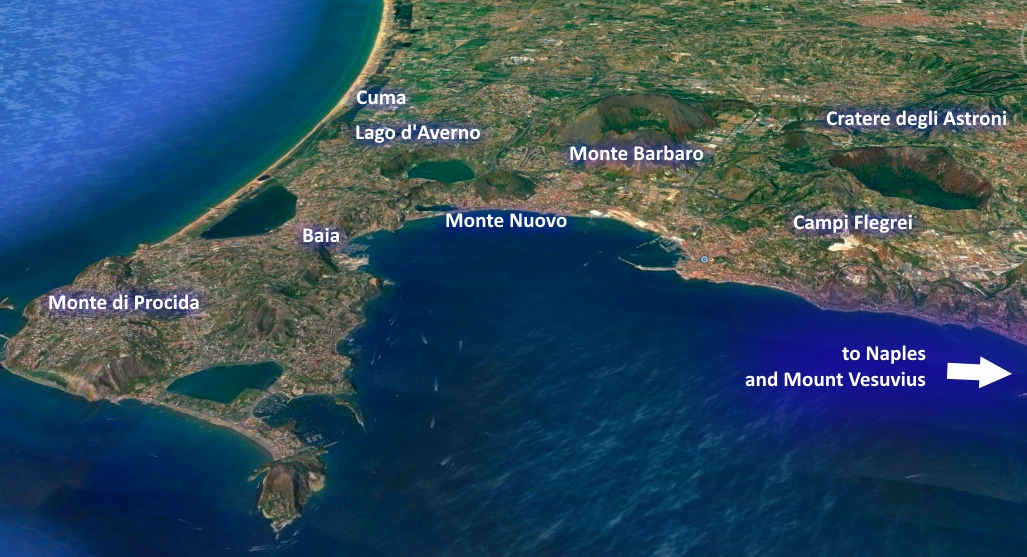

1 Jul 2018
A Sibyl called Cimmerian: exploring the potential link to the Apennine Sibyl - 7. A subterranean Sibyl at the Lake Avernus
By following the footprints left by the Cimmerian Sibyl throughout the centuries, we have come back to the classical age, when southern Italy was the magical scenario for colonies established by settlers moving from Greece.
In the seaside region set between Cumae, Mount Procida with Cape Misenus, Baiae and Pozzuoli, lay an area which was the realm of mighty subterranean powers: a volcanic area, fully active at that times as it is today, and where the gloomy Lake Avernus stood (see Fig. 1), surrounded by looming hills and protected by an impenetrable forest. There, an antique population had their abode, the Cimmerians, who lived in subterranean dwellings.
And they served an oracle, hidden from view and set under the ground. An oracle which vaticinated by querying the dead, as Strabo recounts in his “Geographica”:
«Those who lived prior to our age applied to Lake Avernus the fairy tale about necromancy which is found in Homer, and so much so that they thought here was the oracle where the dead uttered prophecies as if they were alive: the oracle to which Ulysses came».
[In the Latin translation from the original Greek text: «Qui nos aetate antecesserunt, Necyae Homericae fabulas Averno applicaverunt, atque adeo narrant fuisse ibi oraculum ubi vita defuncti responsa darent, eoque Ulissem advenisse»].
But who provided a bridge between the world of the dead and the living men who asked for responses?
It was a Sibyl.
Let's read from a remarkable excerpt taken from “Origo Gentis Romanae” (“The Origin of Roman People”), a fourth-century work attributed to Latin author Sextus Aurelius Victor. The passage depicts Aeneas after his arrival to Italy following the destruction of Troy:
«Aeneas buried on the shore the mother of Euxinus, one of his comrades, who had been carried off by old age, around the marsh which is between Misenus and Avernus, and that, thence, the name was assigned to the spot. And when he had discovered that in that very place a Sibyl chanted future events to mortals in the city which is called Cimbarionis, [they add that] he came to it, having inquired about the state of his own fortunes, and having been forbidden to bury in Italy his relative Prochyta, related to him by blood, whom he had left in good health. And afterwards he returned to the fleet and found she was dead in actual truth...».
[In the original Latin text: «Aeneam in eo litore Euxini cuiusdam comitis matrem ultime aetatis affectam circa stagnum, quod est inter Misenon Avernumque, extulisse atque inde loco nomen inditum; cumque comperisset ibidem Sibyllani mortalibus futura praecinere in oppido, quod vocatur Cimbarionis, venisse eo sciscitatum de statu fortunarum suarum aditisque fatis vetitum, ne is cognatam in Italia sepeliret Prochytam, cognatione sibi coniunctam, quam incolumem reliquerat. Et postquam ad classem rediit repperitque mortuam...»].
In the town of Cimmerians («Cimbarionis» in Strabo), hidden beneath the ground and set between Cape Misenus and the Lake of Alvernus, there was a Sibyl, who vaticinated through the responses given by the dead.
At last, we have found the Cimmerian Sibyl: she was another Italian Sibyl, included in the classical list set down by Lucius Caecilius Firmianus Lactantius, also including two other Sibyls from Italy, namely the Cumaean and the Tiburtine. And her abode was under the hills of Lake Avernus, not far from Cumae and Naples.
But what about the Cumaean Sibyl, whose shrine was also present in the very same area? And what about the alleged relationship - as stated by Francesco Maurolico in the sixteenth century - between the Cimmerian and the Apennine Sibyl, who was set in an utterly different region of Italy? Now, it seems to us that the pieces of the jigsaw puzzle are all coming together, and they indicate that no relation can be highlighted between the two Sibyls.
We will try to disentagle the above remaining questions in the next article.
Una Sibilla chiamata Cimmeria: un'investigazione sulla possibile relazione con la Sibilla Appenninica - 7. Una Sibilla nel sottosuolo presso il Lago d'Averno
Seguendo le orme lasciate dalla Sibilla Cimmeria nel corso dei secoli, siamo tornati indietro nel tempo sino all'età classica, quando l'Italia meridionale era un territorio dai magici scenari per i molteplici insediamenti ivi stabiliti dai coloni provenienti dalla Grecia.
Nella zona costiera posta tra Cuma, il Monte Procida e il Capo Miseno, Baia e Pozzuoli, si trovava una regione che era il regno misterioso abitato da immani potenze sotterranee: un'area vulcanica, viva e attiva oggi come allora, dove si trovava il tenebroso Lago d'Averno (Fig. 1), circondato da incombenti colline e protetto da una foresta impenetrabile. Proprio lì aveva la propria dimora un popolo antico, i Cimmèri, i quali vivevano nel sottosuolo.
E questo popolo serviva un oracolo, nascosto alla vista e posto nel sottosuolo. Un oracolo che vaticinava interrogando i morti, così come ci racconta Strabone nella sua opera “Geographica”:
«Coloro che vissero prima di noi, considerarono il Lago d'Averno come il luogo in cui si svolge il leggendario episodio della negromanzia raccontato da Omero, tanto da narrare come si trovasse proprio lì l'oracolo che otteneva responsi dai morti come se essi fossero vivi: lo stesso oracolo al quale si rivolse Ulisse».
[Nella traduzione latina dall'originale Greco: «Qui nos aetate antecesserunt, Necyae Homericae fabulas Averno applicaverunt, atque adeo narrant fuisse ibi oraculum ubi vita defuncti responsa darent, eoque Ulissem advenisse»].
Ma chi era a stabilire la comunicazione tra il mondo dei morti e quello dei vivi, uomini mortali in cerca di oracolari responsi?
Si trattava di una Sibilla.
Andiamo infatti a leggere un significativo passaggio tratto dall'“Origo Gentis Romanae”, un'opera del quarto secolo attribuita all'autore latino Sesto Aurelio Vittore. Il brano racconta di Enea, l'eroe troiano appena giunto in Italia dopo la distruzione della sua città e della sua gente:
«Enea seppellì su quella spiaggia la madre di Eusino, uno dei suoi compagni, deceduta a causa dell'età avanzata; la seppellì vicino alla palude che si trova tra Miseno e l'Averno, ed ecco da dove quel luogo trasse il proprio nome. E quando venne a sapere che nel villaggio, chiamato Cimbarione, una Sibilla cantava ai mortali il futuro, egli vi si recò e, avendo chiesto un responso a proposito del suo stesso destino, ed essendogli stato proibito di seppellire in Italia la sua congiunta Prochyta, a lui consanguinea, che egli aveva lasciato in buona salute, si affrettò a tornare presso la flotta, e trovò che veramente ella era morta...».
[Nel testo originale latino: «Aeneam in eo litore Euxini cuiusdam comitis matrem ultime aetatis affectam circa stagnum, quod est inter Misenon Avernumque, extulisse atque inde loco nomen inditum; cumque comperisset ibidem Sibyllani mortalibus futura praecinere in oppido, quod vocatur Cimbarionis, venisse eo sciscitatum de statu fortunarum suarum aditisque fatis vetitum, ne is cognatam in Italia sepeliret Prochytam, cognatione sibi coniunctam, quam incolumem reliquerat. Et postquam ad classem rediit repperitque mortuam...»].
Nella città dei Cimmèri («Cimbarionis» in Strabone), nascosta nel sottosuolo e posta tra Capo Miseno e il Lago d'Averno, operava una Sibilla, che profetava per mezzo di responsi ottenuti interrogando le anime dei morti.
Siamo riusciti dunque, finalmente, ad arrivare fino alla Sibilla Cimmeria: essa era un'ulteriore Sibilla italica, inclusa nell'elencazione classica definita da Lucio Cecilio Firmiano Lattanzio, che comprendeva anche due ulteriori Sibille originarie dell'Italia, la Cumana e la Tiburtina. E la sua dimora si trovava al di sotto delle colline che circondavano il Lago d'Averno, non lontano da Cuma e Napoli.
E la Sibilla Cumana? Cosa possiamo dire a proposito di questa Sibilla, il cui tempio oracolare era anch'esso presente proprio nella medesima area? E cosa possiamo ora affermare in merito alla supposta connessione - così come rivendicata da Francesco Maurolico nel sedicesimo secolo - tra la Sibilla Cimmeria e quella Appenninica, la cui dimora si trova invece in una regione d'Italia totalmente differente? Sembrerebbe proprio, adesso, che tutti i pezzi del rompicapo comincino ad incastrarsi tra loro, e ciò i vari elementi reperiti cominciano ad indicare non pare che vadano a stabilire alcuna relazione tra le due Sibille.
Proveremo a rispondere a queste intricate questioni nel prossimo articolo.
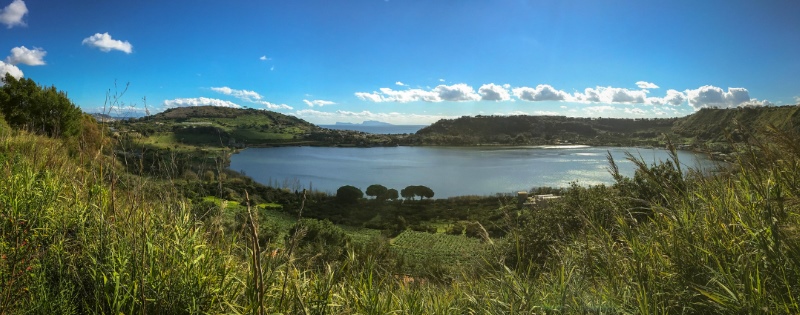

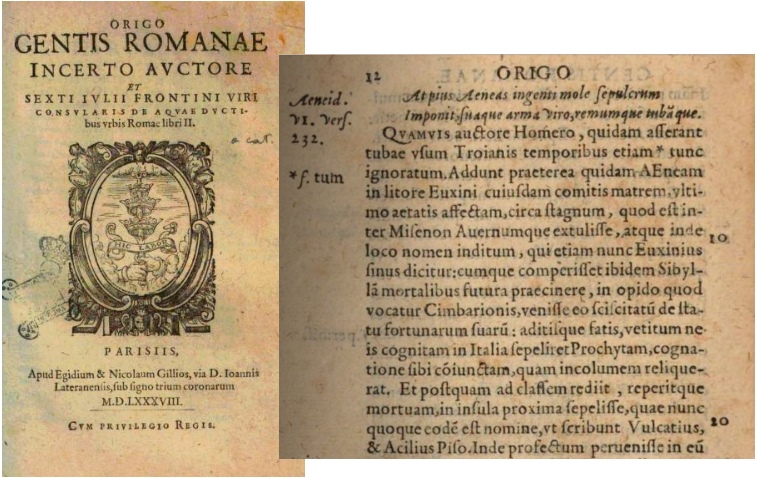

29 Jun 2018
A Sibyl called Cimmerian: exploring the potential link to the Apennine Sibyl - 6. The Cimmerians and their oracle
We are still on the footsteps of the Cimmerian Sibyl, the fourth oracle mentioned in the classical enumeration provided by Lucius Caecilius Firmianus Lactantius in the fourth century. A Sibyl that in some versions of Lactantius “De Divinis Institutionibus” is presented as “Cumean”, a word that brings to the mind of the reader the word 'Cumae', the Campanian town of the Cumaean Sibyl, who in turn is listed under number seven in Lactantius' list.
So the main question now is: where is the Cimmerian Sibyl from? According to Francesco Maurolico, a sixteenth-century Sicilian author, she would reside by a town called «Ameria» or a village named «Cimerio» lying by the caves of Norcia, so the Cimmerian Sibyl and the Apennine Sibyl would actually be the very same oracle.
But only Maurolico (and a Father Fortunato Ciucci from Norcia, who quotes from Maurolico in the seventeenth century) supports this assumption.
No other similar identification is retrieved in other authors or works, either in the main sources used by Maurolico (the “Mappemonde Spirituelle” by Jean Germain, which we saw in a previous paper) or the “Oracula Sibyllina” and Filippo Barbieri's “Opuscula”.
So, if we want to find the truth, we have no choice left: we have to turn back and return to classical authors.
The key to all that is the nature and identity of the people known as 'Cimmerians'. Today, many people think that Cimmerians were an ancient tribal population who lived in the Caucasus. In fact they are mentioned by the Greek historian Herodotus, and have become part of a wider, contemporary popular culture through the fictional tales of Conan the Cimmerian, written by American author Robert E. Howard, in which Cimmerians are depicted as an offspring of a Celtic, northern-European culture.
But this is only a minor tradition, though the most widely known, concerning the Cimmerians.
Because if we look for Cimmerians in classical literature, we find no Celts and no Caucasus at all: instead, we are transported back to a place we already know. We know it well, owing to a most famous Sibyl.
And this place is Cumae.
Because, if the works by ancient writers such as Gnaeus Naevius and Lucius Calpurnius Piso Frugi - who mentioned the Cimmerian Sibyl as Lactantius indicates- are unfortunately lost to us, nonetheless there are still other ancient authors whose works survive. And they all tell unanimously the same story: Cimmerians lived in southern Italy, namely near Cumae (Fig. 1 - Ancient Cumae in a map detail taken from the Tabula Peutingeriana, a thirteenth-century copy on parchment of an original Roman road map - Österreichische Nationalbibliothek, Codex Vindobonensis 324).
Let's listen to the ancient voices which narrate this amazing tale. And we are about to start with the war cry sent out long ago by Hannibal, the great Carthaginian general:
«Soldiers [...] I implore you to make yourselves once more worthy of the reputation you trail after you; and remember the battle of Cannae!»
[In the original Latin text: «Miles [...] obtestor, dignos iam vosmet reddite vestra quam trahitis fama et revocate in pectore Cannas»].
Such are the words reported to us by Silius Italicus, a Roman consul and poet, who wrote his “Punica” at the end of the first century. In his work, Silius describes the anguish and sense of powerlessness that seized Hannibal's heart after the victorious battle of Cannae, followed by a long, idle stay of his army in the Campanian town of Capua. Hannibal fails in capitalizing on his winning moves against the Romans, as his soldiers lose their strength amid banquets and pleasures.
In this occurrence, Hannibal is led by local aristocrats into a visit of the surrounding region, which contains many wonders and notable places, most of them connected to the volcanic nature of the area. The Carthaginian general is shown Baiae, a fashionable resort lying by the Tyrrhenian sea, and the Lake Lucrinus, also known under the name of 'Cocytus' (just like the river flowing in the Otherworld of ancient Greece), and then Lake Avernus, or 'Styx' (another Greek river of the underworld), and the nearby swamps, loaded with dark legends connected to the realm of deads.
Finally, Hannibal listens to the following words (“Punica”, Chapter XII, v. 130-133, as they appear in an antique 1483 edition printed in Venice):
«Close at hand, wrapped in gloom and sunk for long ages in subterranean mists, the city of the Cimmerians lay deep in earth under a pall of shade; and tales are told about the unfathomed night of that Tartarean city».
[In the original Latin text: «Ac iuxta caligante situ longumque per aevum infernis pressas nebulis pallente sub umbra Cymmerias iacuisse domos noctemque profundam Tartareae narrant urbis»].
The subterranean houses of the Cimmerians. A place of mystery and darkness, which lay in the vicinity of Lake Lucrinus, Lake Avernus, and Baiae.
That is, near Cumae.
The Cimmerians are no Celts. In antiquity, it was in the region of Cumae that was located the Cimmerian town, a place of gloominess and absence of light. Here is how Sextus Pompeius Festus - a second-century writer who wrote a “De Verborum Significatione” (“On the meaning of words”), subsequently integrated by the benedictine monk Paul the Deacon - portrays the mysterious Cimmerians (Fig. 3 - Bibliothèque Nationale de France, Latin 7662):
«The Cimmerians are a population inhabiting lands which are subject to the cold of death, and lie between Baiae and Cumae, in the region where a low, large valley is encircled by a huge ridge; the place is never reached by the sun, neither in the morning nor in the evening».
[In the original Latin text: «Cimeri dicuntur homines, qui frigoribus occupatas terras incolunt, quales fuerunt inter Baias et Cumas in ea regione, in qua convallis satis eminenti iugo circumdata est, quae neque matutino, neque vespertino tempore sole contingitur»].
There is no surviving doubt: Herodotus' Cimmerians might have actually lived in the Caucasus, but they are different 'Cimmerians'. There existed, in ancient Italy, an Italic population that was based in the Campania province, in a region where the land itself was enshrouded in magic, which originated from the volcanic nature of the soil. And many authors report about them.
Pliny the Elder, in his first-century “Naturalis Historia”, says in Book III (Fig. 4) that «on the coast [we find] Cumae, a Chalcidian colony, Misenum, the port of Baiae, Bacoli, Lake Lucrinus and Lake Avernus, which is near to where once stood the Cimmerian town. We then come to Puteoli, formerly called the colony of Dicaearchia, then the Phlegraean Plains, and the Marsh of Acherusia in the vicinity of Cumae [...] and then Erculaneum, Pompeii...».
[In the original Latin text: «in ora [...] cumae chalcidesium, misenum, portus baianus, bauli, lacus lucrinus et avernus cimmerium iuxta quem oppidum quondam; deinde puteoli colonia dicerachea dicti, postquem phlegei campi. Acherusia palus Cumis vicina [...] herculaneum, pompeii...»].
And in the third century, Lycophrone of Chalcis, in his poem “Alexandra” (v. 695 - Fig. 5), will write of Odysseus, who «pushes himself beyond the burial place of his helmsman Baius [modern Baiae] and the abode of Cimmerians and the Acherusian plain...», again locating the Cimmerians in the surroundings of Cumae.
But it is Strabo, the Greek geographer and historian, who provides a most comprehensive reference about the Cimmerians in his most renowned “Geographica”, a work written in the first century. In Book V, he describes Cumae, Cape Miseno, the swamps called 'Acherontia' (another name for a river flowing in the Otherworld of ancient Greece), Baiae, the Lake Lucrinus, and the shadowy, blood-curdling Lake Avernus (Fig. 6):
«Avernus, entirely encircled by ridges above, looming on it from every side but a single point; it is now cultivated, however in old times it was enshrouded by an inaccessible wood made of huge trees, which covered with gloomy, superstitious shade the whole lake».
[In a 1571 Latin translation of the original text in Greek: «Avernus superciliis recta sursum enatis et undique praterquam in aditu imminentibus, ac nunc quidem cultura elaboratis; olim enim sylva inaccessa magnarum arborum obsita, ob superstitionem ipsum sinum obumbrabant»].
There, according to Strabo, was the abode of Cimmerians, and their oracle:
«People considered Avernum as a place sacred to Pluto, and that Cimmerians lived there [...] Ephorus maintained that this site was of the Cimmerians, about whom he says that they dwell in underground premises, which they call 'clay-made'; and they come to and fro through subterranean tunnels, and by the same way they allow visitors to the oracle which is deeply dug into the ground; they live on the metal ore they mine, and on those who consult the oracle. [...] And in addition to that, there is an ancient custom that those who live by the oracle must never see the sun, as they can only go outside through the crevices in the ground when the night comes».
[In the Latin translation: «Nam et Avernum p loco Plutoni dicato deputabat, et Cimmerios ibi fuisse indicatu habitare [...] Ephorus vero Cimmeriis locum illum dicans, hos abitare ait in subterraneis aedificiis, quas argillas vocent, ac per fossas quasdam inter se comeare, hospitesque eadem via in oraculum adducere alte infra terram conditum, victum eos metallis effodiendis quarere, et ab ii accipere qui oraculum consulunt [...]. Porro qui apud oraculum illud degunt, eos more a maioribus accepto nunquam videre solem sed noctu ex hiatibus terrae prodire»].
We are getting closer and closer to the true origin of the Cimmerian Sibyl. We have come to Cumae and by the shore of Lake Avernus, in the Italian region of Campania. And we know that the mysterious, almost mythical Cimmerians lived in underground dwellings, and controlled an oracle, deeply set in a subterranean shrine.
Was that oracle a Sibyl?
Yes it was. It was a Cimmerian Sibyl. As we will discover in the next article.
Una Sibilla chiamata Cimmeria: un'investigazione sulla possibile relazione con la Sibilla Appenninica - 6. L'oracolo dei Cimmeri
Ci troviamo ancora sulle tracce della Sibilla Cimmeria, il quarto oracolo menzionato nella classica lista delineata da Lucio Cecilio Firmiano Lattanzio nel quarto secolo. Una Sibilla che, in alcune versioni delle "De Divinis Institutionibus" di Lattanzio viene indicata come "Cumea", un appellativo che riporta alla mente del lettore la parola 'Cuma', la città della Campania nella quale profetava la Sibilla Cumana, la quale, a propria volta, è presente nella lista di Lattanzio con il numero sette.
Ma dove si troverebbe la Sibilla Cimmeria? Secondo Francesco Maurolico, autore siciliano del sedicesimo secolo, essa sarebbe originaria di una città chiamata «Ameria», oppure di un villaggio il cui nome è «Cimerio», situato in prossimità delle grotte di Norcia, in modo tale da far corrispondere la Sibilla Cimmeria con la Sibilla Appenninica, che dunque non sarebbero altro che il medesimo oracolo.
Eppure, a sostenere questa identità è solamente Maurolico (e Padre Fortunato Ciucci da Norcia, che nel diciassettesimo secolo, citerà brani tratti da Maurolico).
Nessun altro autore od opera riferisce di una simile identificazione, né le fonti primarie di Maurolico (il "Mappemonde Spirituelle" di Jean Germain, che abbiamo avuto occasione di considerare in un precedente articolo), né altre fonti quali gli "Oracula Sibyllina" o gli "Opuscula" di Filippo Barbieri.
Se vogliamo arrivare alla verità, non abbiamo allora altra scelta: dobbiamo volgerci verso il passato e tornare agli autori della classicità.
La chiave di tutto questo problema si trova nella vera natura e identità del popolo conosciuto con il nome di 'Cimmèri'. Oggi, molti sono convinti che i Cimmèri siano stati un'antica popolazione tribale vissuta nella regione del Caucaso. In effetti, il loro nome è mezionato dallo storico greco Erodoto, ed essi sono inoltre divenuti parte di una più diffusa cultura popolare contemporanea grazie ai racconti fantasy di Conan il Cimmero, ideati dal narratore americano Robert E. Howard, in cui i Cimmèri sono rappresentati come appartenenti ad una cultura di origine celtica e nordeuropea.
Ma si tratta solamente di una tradizione secondaria, benché certamente la più nota tra il grande pubblico, riguardante il popolo dei Cimmeri.
Perché se andiamo a ricercare i Cimmèri nella letteratura della classicità, non troviamo né Celti né tantomeno il Caucaso: ci troviamo, invece, ad essere riportati verso un luogo che già conosciamo. E lo conosciamo bene, grazie ad una famosa, notissima Sibilla.
E questo luogo è Cuma.
Perché, se è vero che le opere di antichi autori quali Gneo Nevio e Lucio Calpurnio Pisone Frugi - che parlarono della Sibilla Cimmeria, come ci racconta Lattanzio - sono andate sfortunatamente perdute, nondimeno esistono altri e diversi autori i cui testi sono giunti fino a noi. E tutti loro, tutti insieme, ci raccontano la stessa identica storia: i Cimmèri vivevano nell'Italia meridionale, e precisamente in prossimità della città di Cuma (Fig 1 - l'antica Cuma così come appare in un dettaglio tratto dalla Tabula Peutingeriana, copia del tredicesimo secolo su pergamena di mappa stradale romana originale - Österreichische Nationalbibliothek, Codex Vindobonensis 324).
Ascoltiamo allora le antiche voci che ci raccontano questa incredibile storia. E cominciamo con il grido di battaglia innalzato secoli fa da Annibale, il grande generale cartaginese:
«Soldati [...] io vi imploro, siate ancora una volta degni della fama che segue il vostro nome, e richiamate nei cuori la gloriosa battaglia di Canne!»
[Nel testo originale latino: «Miles [...] obtestor, dignos iam vosmet reddite vestra quam trahitis fama et revocate in pectore Cannas»].
Sono queste le parole riferiteci da Silio Italico, console e poeta dell'antica Roma, il quale scrisse il suo poema "Punica" alla fine del primo secolo. In quest'opera, Silio descrive l'angoscioso senso di impotenza che si era impossessato dell'animo di Annibale dopo la vittoriosa battaglia di Canne, seguita da una lunga, oziosa permanenza del suo esercito nella città campana di Capua. Annibale non riesce a rendere produttive le vittoriose azioni da lui condotte contro i Romani, mentre i suoi soldati perdono progressivamente la propria bellicosa determinazione tra banchetti e piaceri d'ogni genere.
In questo contesto, Annibale viene accompagnato dai notabili del luogo in una visita della circostante regione, che contiene molte meraviglie e paesaggi rimarchevoli, molti dei quali connessi alla natura vulcanica dell'intera zona. Al generale cartaginese viene mostrata Baia, luogo di villeggiatura alla moda posto sulle rive del Mar Tirreno, e il Lago Lucrino, conosciuto anche con il nome di Cocito (proprio come il fiume che scorre nell'Ade dell'antica Grecia), e poi il Lago d'Averno, detto anche Stige (come un altro dei fiumi appartenenti al mondo greco dell'oltretomba), e infine le vicine paludi, ricolme di tenebrose leggende collegate al mondo dei morti.
È a questo punto che ad Annibale vengono rivolte le seguenti parole (“Punica”, Capitolo XII, v. 130-133, così come appaiono in un'antica edizione a stampa pubblicata a Venezia nel 1483):
«Non lontano da quei luoghi, avvolti nella tenebra e sprofondati per lunghe ere nelle nebbie infere, le dimore dei Cimmèri giacquero nell'ombra livida; e molto si racconta della notte profonda di quella città sotterranea».
[Nel testo originale latino: «Ac iuxta caligante situ longumque per aevum infernis pressas nebulis pallente sub umbra Cymmerias iacuisse domos noctemque profundam Tartareae narrant urbis»].
Le dimore sotterranee dei Cimmèri. Un luogo di mistero e di tenebra, che giace in prossimità del Lago Lucrino, del Lago d'Averno, e di Baia.
E cioè, nelle vicinanze di Cuma.
I Cimmèri non sono Celti. Nell'antichità, era proprio nella regione di Cuma che era situata la città Cimmeria, un luogo di tenebra e assenza di luce. Ecco come Sesto Pompeo Festo - autore del secondo secolo che scrisse un'opera dal titolo "De Verborum Significatione" ("Sul significato delle parole"), in seguito integrata dal monaco benedettino Paolo Diacono - ci presenta i misteriosi Cimmèri (Fig. 3 - Bibliothèque Nationale de France, Latin 7662):
«Cimmèri sono detti quegli uomini che abitano le terre soggette al rigore del freddo, quali furono situate tra Baia e Cuma, in quella regione dove una vasta, profonda valle è circondata da un'alta cresta; lì mai riesce a giungere né il sole del mattino, né quello della sera».
[Nel testo originale latino: «Cimeri dicuntur homines, qui frigoribus occupatas terras incolunt, quales fuerunt inter Baias et Cumas in ea regione, in qua convallis satis eminenti iugo circumdata est, quae neque matutino, neque vespertino tempore sole contingitur»].
Non c'è alcun dubbio. Forse i Cimmèri di Erodoto hanno realmente percorso le steppe del Caucaso, ma si tratta di altri e diversi 'Cimmèri'. Esisteva invece, nell'Italia antica, una popolazione che dimorava nella provincia della Campania, in quella regione dove la terra stessa era avvolta nella magia, che trovava origine nella natura vulcanica del suolo. E molti autori ci raccontano questa storia.
Plinio il Vecchio, nella sua "Naturalis Historia", risalente al primo secolo, afferma nel Libro III (Fig. 4) che «sulla costa [troviamo] Cuma, colonia calcidica, Miseno, il porto di Baia, Bacoli, il Lago Lucrino e quello d'Averno, che si trova vicino al luogo dove un tempo sorgeva la città dei Cimmèri; e poi Pozzuoli, una volta chiamata colonia della Dicaearchia, poi i Campi Flegrei, la palude Acherusia in prossimità di Cuma [...] e inoltre Ercolano, Pompei...».
[Nel testo originale latino: «in ora [...] cumae chalcidesium, misenum, portus baianus, bauli, lacus lucrinus et avernus cimmerium iuxta quem oppidum quondam; deinde puteoli colonia dicerachea dicti, postquem phlegei campi. Acherusia palus Cumis vicina [...] herculaneum, pompeii...»].
E nel terzo secolo, Licofrone di Calcide, nel poema "Alexandra" (v. 695 - Fig. 5), scriverà di Ulisse e di come l'eroe si fosse «spinto oltre il luogo di sepoltura del suo timoniere Baio [la moderna Baia] e la dimora dei Cimmèri e la pianura Acherusia...», nuovamente collocando i Cimmèri nelle immediate vicinanze di Cuma.
Ma è Strabone, lo storico e geografo greco, a fornirci il riferimento più completo a proposito dei Cimmèri all'interno della sua notissima opera "Geographica", risalente al primo secolo. Nel Libro V, Strabone descrive Cuma, Capo Miseno, le paludi chiamate con il nome 'Acherontia' (un altro nome corrispondente a uno dei fiumi che scorre nell'Ade degli antichi Greci), Baia, il Lago Lucrino, e il tenebroso, agghiacciante Lago d'Averno (Fig. 6):
«Averno, completamente circondato in alto da creste, ovunque incombenti su di esso a meno di un solo varco; oggi coltivato, ma un tempo avvolto da un'inaccessibile selva di grandi alberi, che oscuravano quel lago con ombre di superstizione».
[Dalla traduzione latina del testo originale greco pubblicata nel 1571: «Avernus superciliis recta sursum enatis et undique praterquam in aditu imminentibus, ac nunc quidem cultura elaboratis; olim enim sylva inaccessa magnarum arborum obsita, ob superstitionem ipsum sinum obumbrabant»].
E lì, secondo quanto ci racconta Strabone, c'era non solo la dimora dei Cimmèri, ma anche quella del loro oracolo:
«Il Lago d'Averno era considerato come un luogo dedicato a Plutone, e si credeva che lì abitassero i Cimmèri [...] Eforo sosteneva che quel luogo fosse dei Cimmèri; egli affermava che essi dimorassero in luoghi sotterranei, detti 'argille', e che si incontrassero per mezzo di tunnel sotterranei, e che tramite le stesse vie introducessero i visitatori presso il loro oracolo, posto in profondità nella terra; essi si procuravano da vivere scavando i metalli, e grazie a ciò che guadagnavano da coloro che si recavano all'oracolo. [...] Inoltre, secondo un'antica traadizione coloro che servono l'oracolo non possono mai vedere la luce del sole, e solamente di notte essi possono uscire dalle fessure della terra».
[Nella traduzione latina: «Nam et Avernum p loco Plutoni dicato deputabat, et Cimmerios ibi fuisse indicatu habitare [...] Ephorus vero Cimmeriis locum illum dicans, hos abitare ait in subterraneis aedificiis, quas argillas vocent, ac per fossas quasdam inter se comeare, hospitesque eadem via in oraculum adducere alte infra terram conditum, victum eos metallis effodiendis quarere, et ab ii accipere qui oraculum consulunt [...]. Porro qui apud oraculum illud degunt, eos more a maioribus accepto nunquam videre solem sed noctu ex hiatibus terrae prodire»].
Ci stiamo avvicinando sempre di più alla vera origine della Sibilla Cimmeria. Siamo giunti a Cuma e alle rive del Lago d'Averno, nella regione della Campania. E sappiamo, ora, che i misteriosi, leggendari Cimmèri vivevano in dimore sotterranee, e controllavano un oracolo, profondamente sepolto in un tempio ipogeo.
Questo oracolo era una Sibilla?
Sì, lo era. Era una Sibilla dei Cimmèri. Come scopriremo nel prossimo articolo.
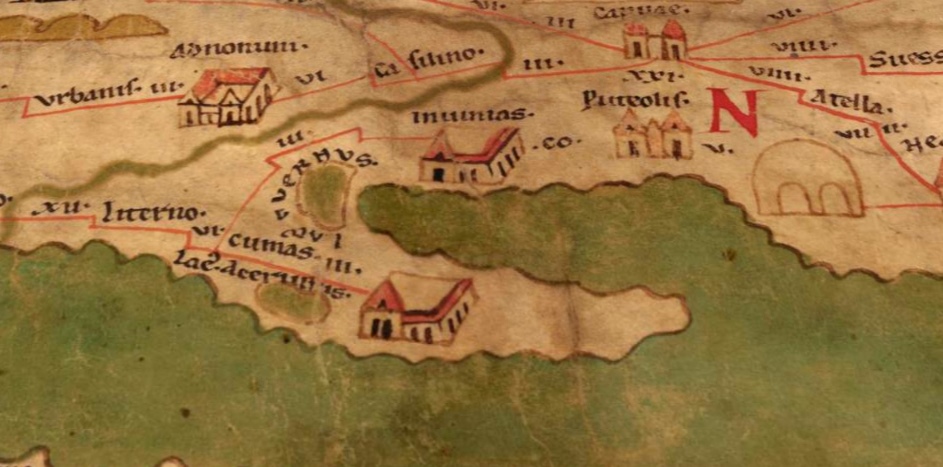

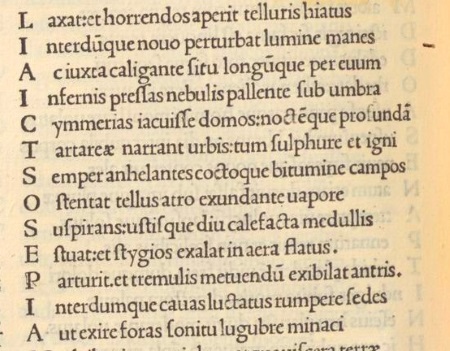

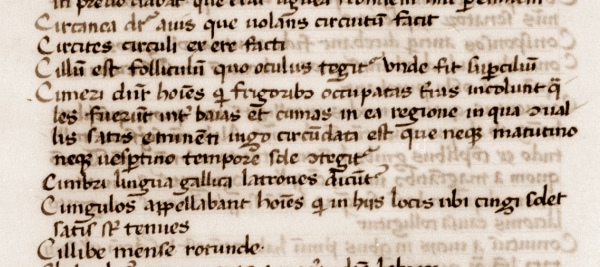

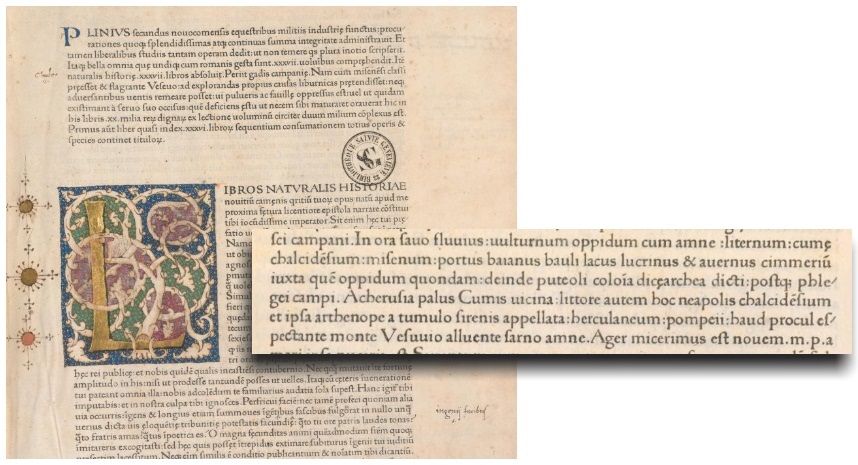

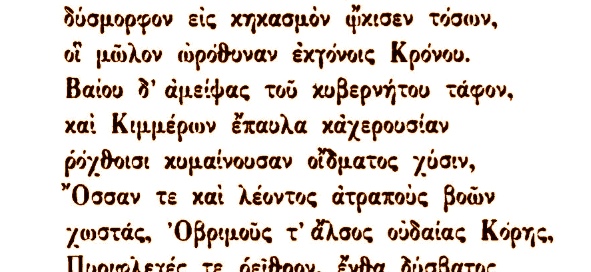

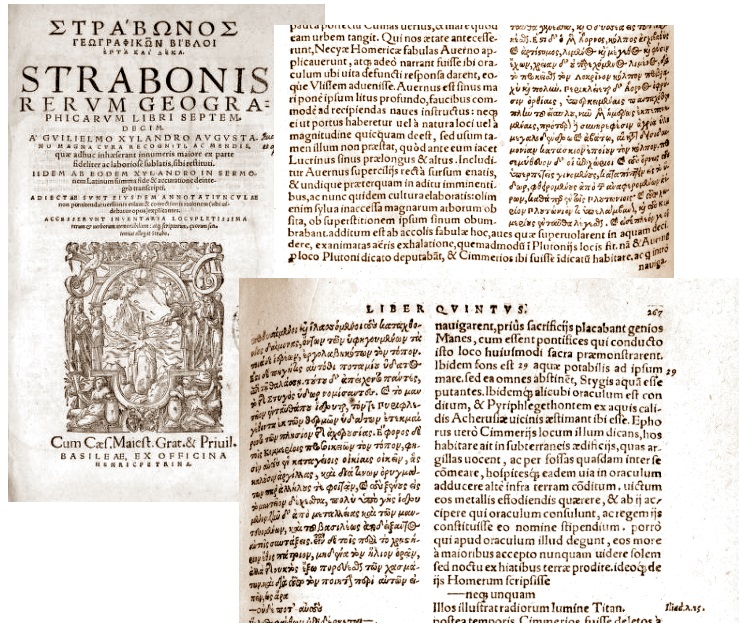

24 Giu 2018
A Sibyl called Cimmerian: exploring the potential link to the Apennine Sibyl - 5. Albumazar and the transformation into a Christian Sibyl
Starting from a series of quotes extracted from Francesco Maurolico's “Topographia Sanctorum Christi Martyrum”, we are trying to understand whether a Sibyl called 'Cimmerian' might have anything to do with the Sibyl of Norcia, established beneath a mountain in the Italian Apennines (see figure 1), as alleged by Maurolico himself.
However, in the course of our search we have stumbled upon a number of unexpected obstacles.
To begin with, the Cimmerian Sibyl, included in the classical list of ten Sibyls set down by Lucius Caecilius Firmianus Lactantius in his “De Divinis Institutionibus”, written in the fourth century, often appears in different editions of this Latin work with the name of «Cumean», an attribute that seems to signify a close relationship with the Sibyl of Cumae, also listed by Lactantius.
An additional problem is that we cannot proceed into an investigation of the classical authors quoted by Lactantius himself as a reference for the Cimmerian Sibyl (i.e. Marcus Varro, Gnaeus Naevius and Lucius Calpurnius Piso Frugi), because the literary works written by the three of them have not survived, save selected excerpts, thoroughly irrelevant to our search.
If we transfer our investigation to more recent centuries, by perusing ancient, utmostly rare books such as the “Oracula Sibyllina”, preserved at the Abbey of St. Gall in Switzerland, and Filippo Barbieri's “Opuscula”, both printed in the fifteenth century and both mentioning our highly enigmatic Cimmerian Sibyl, we find out that she shows up with different, additional names - «Cyemerian», «Chimerian», «Chimica». Furthermore, she begins to appear as a Christian oracle who would have announced the coming of Jesus on earth, by providing a sort of vision concerning a young maiden with long hair, sitting on a throne and feeding a child with her milk: a manifest portrait of Jesus and the Holy Mary. And additional authors are also mentioned: Ennius, a writer from ancient Rome, and a certain «Albumazar the astrologer».
At this point of our search, confusion seems to preside over the whole matter in an undisputed way.
Will we ever be able to unwind this tangled matter? Our motto is: despair not. Let's try to unfold the many leaves which veil the traditional lore about the Cimmerian Sibyl, by taking them out one by one.
As a first step, let's start with getting rid of «Albumazar», the astrologer. We will show that he adds nothing to our investigation on the origin of the Cimmerian Sibyl and her potential connection to the Apennines.
Who is 'Albumazar'? Albumazar is Abu Ma'shar, one of the greatest Muslim astronomers of past ages, who lived in Baghdad in the eight century. He wrote a number of renowned astrological works, including an “Introductorium maius in astronomiam”, which was widely known in Europe starting from the twelfth century.
In 1133, Johannes Hispalensis translated the work by Albumazar into Latin. And in manuscript Lat 14704, preserved at the Bibliothèque Nationale de France and containing Johannes Hispalensis' translation work, we stumble upon the very origin of the Christian-oriented words that were later attributed to the Cimmerian Sibyl (see figure 2):
«Virgin [the sign of the zodiac] [...] In its first decan [a partition of the sign itself] [...] a maiden will rise, a handsome and honest and pure virgin, with long hair and handsome face, bearing two spikes in her hand; and she sits in a throne and feeds a child giving nourishment to him [...] and the child is called among the nations Jesus...».
[In the original Latin text: «Virgo [...] ascendit in prima facie illius puella [...] et est virgo pulcra atque honesta et munda, prolixi capilli et pulcra facie, habens in manu sua duas spicas; et ipsa sedet super sedem stratam et nutrit puerum, dans ei ad commendendum ius [...], et vocant ipsum puerum quedam gens Ihesum...»].
In the excerpt from Albumazar, an astrological sign conveys a vision of things to come, namely the birth of Jesus, a child attended by a pure virgin, the Holy Mary. In the text by Albumazar, no reference to any Sibyl is present at all.
But the chance was too appealing for later Christian scholars: the oracular tale provided by the heathen Albumazar was unbelievably perfect to illustrate the great plan of God concerning the Incarnation. The tender, emotional prophecy on the Holy Mary feeding Jesus, originally presented in connection to the zodiacal sign of Virgin, was perfectly adaptable to a different witness to God's divine scheme: a virginal Sibyl, announcing the new Christian era, as already alleged centuries earlier by Augustine of Hippo.
So Albumazar's tale was adapted to fit one of the Sibyls included in the list by Lactantius, namely the Cimmerian. To the purpose, in St. Gall's “Oracula Sibyllina”, which we saw in the previous paragraph, the Cimmerian Sibyl is portrayed with a sign where the very same words used by Albumazar are found («In prima facie virginis ascendit virgo quedam honesta et munda et est pulchra facie prolixi capilli...»). And the same we find in Filippo Barbieri's “Opuscula” («... sedens super sedem stratam, nutrit puerum, dans ei ad comedendum ius proprium, idest lac de celo missum»).
And in another translation of Albumazar's “Introductorium in astronomiam”, published in Venice in 1506, the excerpt on the zodiacal sign of Virgo is accompanied by an image of a virgin, with long hair and spikes in her hand, which is almost indistinguishable by a typical pictorial illustration of a Sibyl (see figure 3).
Here we are: the transformation of the Cimmerian / Cumean Sibyl extracted from Lactantius is now completed. By virtue of an evocative text written by an ancient Muslim astrologer, widely known in Europe owing to existing translations of his works into Latin, we now have a Sibyl that acts as a herald on behalf of God, providing an incontrovertible announcement of the future coming of the Salvation.
That's why Albumazar's oracular tale became, in the twelfth and thirteenth centuries, a most favourite topic for Christian preachers willing to convince audiences that the birth of Jesus had been foretold in advance by pagan seers, as noted by some scholars (Marie-Thérèse d'Alverny, 1984). And in subsequent centuries the Cimmerian Sibyl will continue her journey through history properly supplemented with her prophecy, which was usually inscribed in a scroll, as in a fine sixteenth-century frescoed medallion painted on a wall of the “Room of the Sibyls” at the Casa Cavassa City Museum in Saluzzo (a small town near Turin, Italy) (see figure 4).
As a result, the Cimmerian Sibyl has now fully joined the Christian army. However, Albumazar, the Holy Virgin, the child and all the Christian apparatus we have seen above have not helped us in getting one single step closer to the true origin of the Cimmerian Sibyl. That was only a misleading path.
To reach the core of the legend about the Cimmerian Sibyl, we must leave the Christian centuries behind and go back again to classical time.
There, at last, we will find the answers we have been long looking for.
Una Sibilla chiamata Cimmeria: un'investigazione sulla possibile relazione con la Sibilla Appenninica - 5. Albumazar e la trasformazione in Sibilla cristiana
Prendendo le mosse da una collezione di brani tratti dalla “Topographia Sanctorum Christi Martyrum” di Francesco Maurolico, stiamo tentando di verificare se un Sibilla denominata 'Cimmeria' possa avere avuto una relazione di qualche genere con la Sibilla di Norcia, dimorante nel cuore di una montagna facente parte della catena degli Appennini (vedere figura 1), così come sostenuto dallo stesso Maurolico.
Nel corso della nostra ricerca, ci siamo però imbattuti in una serie di ostacoli inattesi.
Innanzitutto, la Sibilla Cimmeria, inclusa nella classica elencazione contenente dieci Sibille delineata da Lucio Cecilio Firmiano Lattanzio nel suo "De Divinis Institutionibus", un'opera latina redatta nel quarto secolo, si presenta nelle diverse versioni oggi disponibili con il nome di «Cumea», un attributo che sembra comportare una stretta connessione con la Sibilla di Cuma, anch'essa elencata dal Lattanzio.
Inoltre, abbiamo evidenziato come non sia oggi possibile procedere ad una indagine di quegli autori classici menzionati da Lattanzio stesso in relazione alla Sibilla Cimmeria (e cioè Marco Varrone, Gneo Nevio e Lucio Calpurnio Pisone Frugi), perché le opere scritte da costoro non sono purtroppo sopravvissute fino ai nostri giorni, a meno di singoli frammenti, del tutto irrilevanti per la nostra ricerca.
Se trasferiamo la nostra indagine verso secoli meno remoti, andando a compulsare libri antichi e rarissimi quali gli "Oracula Sibyllina", conservati presso l'Abbazia di San Gallo in Svizzera, e gli "Opuscula" di Filippo Barbieri, entrambi risalenti al quindicesimo secolo ed entrambi contenenti riferimenti alla nostra enigmatica Sibilla Cimmeria, troviamo che essa si ripropone alla nostra attenzione con nuovi e diversi nomi - «Cyemeria», «Chimeria», «Chimica». E ancora, essa comincia anche ad apparire come un oracolo cristiano, una profetessa che avrebbe preannunciato la venuta del Cristo sulla terra per mezzo di una sorta di visione riguardante una fanciulla dai lunghi capelli, assisa su di un trono e intenta a nutrire un bimbo con il proprio latte: una palese prefigurazione di Gesù e della Vergine Maria. E, addirittura, nuovi autori antichi vengono tirati in ballo: Ennio, scrittore della Roma antica, e un certo «Albumazar l'astrologo».
A questo punto della nostra ricerca, una grande confusione sembra regnare, sovrana e incontrastata, sull'intera materia.
Saremo mai in grado di dipanare il filo di questa intricata matassa? Il nostro motto è: mai disperare. Proviamo a sfogliare assieme i molti veli che oscurano la tradizione leggendaria della Sibilla Cimmeria, provando a diradarli singolarmente ad uno ad uno.
Come primo passo, cominciamo a liberarci di «Albumazar», l'astrologo. Mostreremo come questo autore non aggiunga nulla alla nostra investigazione dedicata all'origine della Sibilla Cimmeria e alla sua possibile relazione con le montagne dell'Appennino.
Chi è 'Albumazar'? Albumazar è Abu Ma'shar, uno dei più grandi astronomi islamici del passato, vissuto a Baghdad nell'ottavo secolo. Fu l'autore di alcune celebri opere astrologiche, tra le quali l'“Introductorium maius in astronomiam”, largamente conosciuto in Europa a partire dal secolo dodicesimo.
Nel 1133, Johannes Hispalensis tradusse l'opera di Albumazar in lingua latina. E proprio all'interno del manoscritto Lat 14704, conservato presso la Bibliothèque Nationale de France e contenente la traduzione redatta da Johannes Hispalensis, veniamo a trovarci di fronte alla fonte originale della profezia di orientamento cristiano che sarà in seguito attribuita alla Sibilla Cimmeria (vedere figura 2):
«Vergine [il segno zodiacale] [...] Nella sua prima decade [una suddivisione del medesimo segno] [...] una fanciulla sorgerà, vergine bellissima e onesta e pura, lunghi i capelli, dal viso armonioso, con due spighe nella mano; ed è assisa su di un trono, intenta a nutrire un fanciullo, sostentandolo con appropriato nutrimento [...] e il fanciullo è chiamato tra le nazioni con il nome di Gesù...».
[Nel testo originale latino: «Virgo [...] ascendit in prima facie illius puella [...] et est virgo pulcra atque honesta et munda, prolixi capilli et pulcra facie, habens in manu sua duas spicas; et ipsa sedet super sedem stratam et nutrit puerum, dans ei ad commendendum ius [...], et vocant ipsum puerum quedam gens Ihesum...»].
Nel brano tratto da Albumazar, un segno zodiacale è portatore di una visione degli eventi futuri, in particolare della nascita di Gesù, un bimbo affidato alle cure di una pura vergine, Maria. Nel testo di Albumazar, inoltre, non è presente il minimo riferimento ad alcuna Sibilla.
Ma per i successivi esegeti di orientamento cristiano l'occasione deve essere apparsa troppo ghiotta: il racconto oracolare proposto dal miscredente Albumazar si presentava come assolutamente perfetto al fine di rendere evidente il grande piano di Dio avente per oggetto l'Incarnazione. La dolce profezia di una Santa Vergine che allatta Gesù, originariamente presentata in relazione al segno zodiacale della Vergine, era perfettamente adattabile ad un'altra e diversa testimone del grandioso progetto divino: una virginale Sibilla, intenta a preannunciare l'inizio della nuova era cristiana, così come già sostenuto molti secoli prima da Agostino di Ippona.
E così il racconto di Albumazar fu modificato per essere abbinato ad una delle Sibille incluse nella lista di Lattanzio, la Cimmeria. A questo scopo, negli "Oracula Sibyllina" di San Gallo, che abbiamo avuto modo di vedere nel precedente articolo, la Sibilla Cimmeria è raffigurata assieme ad un cartello che riporta le stesse identiche parole reperibili in Albumazar («In prima facie virginis ascendit virgo quedam honesta et munda et est pulchra facie prolixi capilli...»). E lo stesso testo troviamo negli "Opuscula" di Filippo Barbieri («... sedens super sedem stratam, nutrit puerum, dans ei ad comedendum ius proprium, idest lac de celo missum»).
E in una diversa traduzione dell'“Introductorium in astronomiam” di Albumazar, pubblicata a Venezia nel 1506, il brano concernente il segno zodiacale della Vergine è accompagnato dall'immagine di una fanciulla dai lunghi capelli, con in mano delle spighe, che pare quasi indistinguibile dalla raffigurazione tipica di una Sibilla (vedere figura 3).
Ed eccoci arrivati: la trasformazione della Sibilla Cimmeria / Cumea tratta da Lattanzio è ora completa. Grazie all'evocativo testo scritto da un antico astronomo islamico, ben conosciuto in Europa attraverso le traduzioni delle sue opere in lingua latina, ci troviamo ad avere una Sibilla che opera in qualità di araldo per conto di Dio, fornendo un annuncio incontrovertibile e veritiero del futuro approssimarsi della Salvezza.
Ecco dunque perché il racconto profetico di Albumazar divenne, nel dodicesimo e tredicesimo secolo, uno dei soggetti favoriti trattati dai predicatori cristiani impegnati a convincere il popolo del fatto che la nascita del Cristo fosse stata preannunciata in anticipo da veggenti pagane, così come segnalato da alcuni studiosi (Marie-Thérèse d'Alverny, 1984). E, nei secoli successivi, la Sibilla Cimmeria continuerà il proprio viaggio attraverso la storia accompagnata dalla profezia a lei riferita, opportunamente trascritta su di un apposito cartiglio, così come appare, ad esempio, in un pregevole medaglione cinquecentesco affrescato su una delle pareti della "Sala delle Sibille" nel Museo Civico Casa Cavassa di Saluzzo (Cuneo) (vedere figura 4).
Il risultato di tutto ciò è stato il pieno arruolamento della Sibilla Cimmeria nell'esercito cristiano. Malgrado ciò, né Albumazar, né la Santa Vergine, né il fanciullo, né tutto l'apparato cristiano che abbiamo appena illustrato ci aiutano ad avvicinarci di un singolo passo alla vera origine del mito della Sibilla Cimmeria. Si tratta, come abbiamo visto, solamente di una falsa pista.
Per potere raggiungere il nucleo della leggenda che riguarda la Sibilla Cimmeria, dobbiamo abbandonare i secoli del Cristianesimo e tornare indietro nel tempo fino all'età classica.
Laggiù troveremo, finalmente, le risposte che stiamo da lungo tempo cercando.
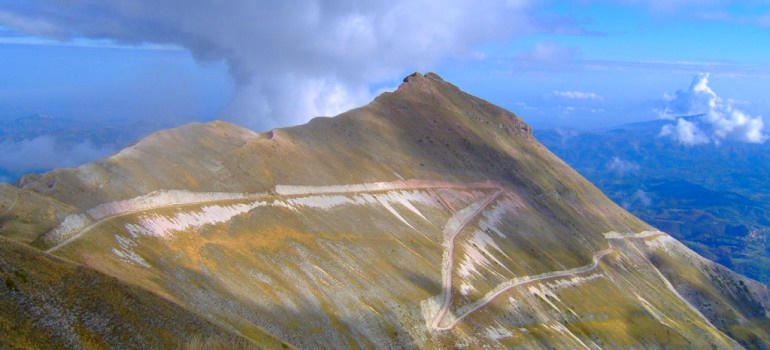

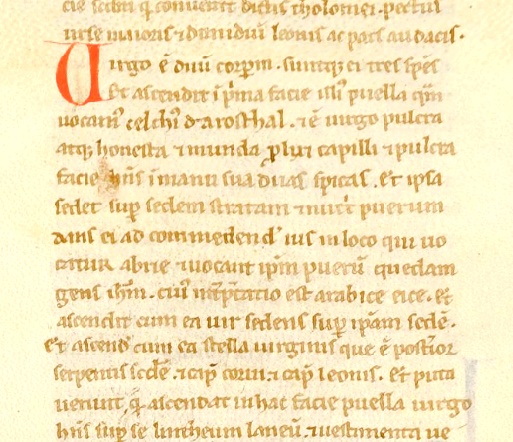

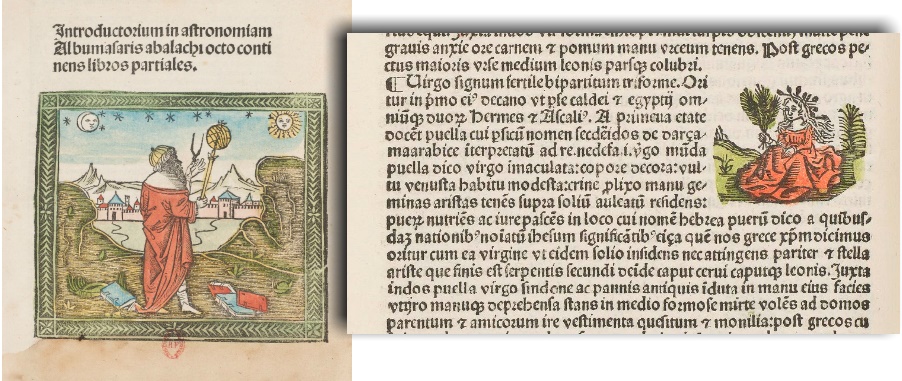

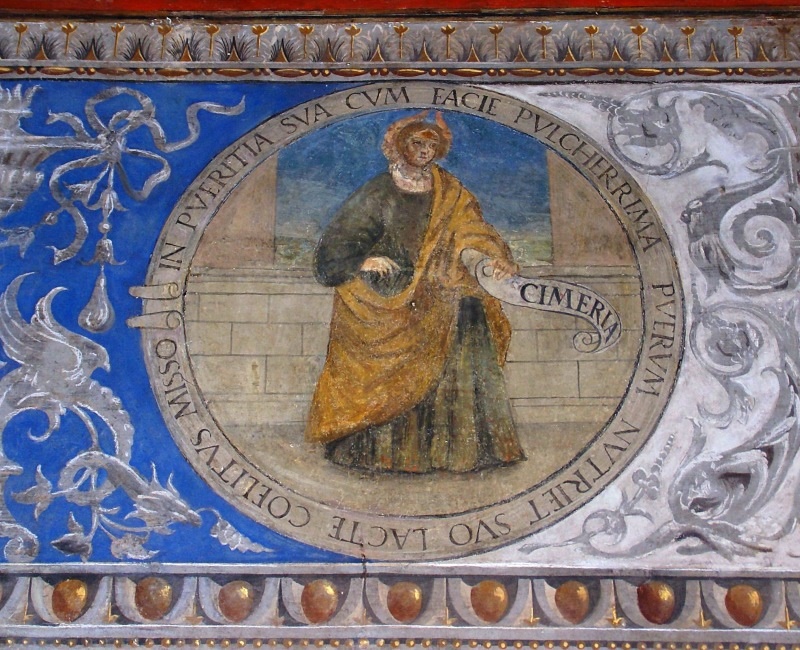

18 Giu 2018
A Sibyl called Cimmerian: exploring the potential link to the Apennine Sibyl - 4. The Sibyl with many names
Is the fourth Sibyl, described by fourth-century author Lactantius in his celebrated enumeration as «Cimmerian», linked in some way to the seventh in the list, the most famous «Cumaean»?
We start to doubt when we consider different ancient editions of Lucius Caecilius Firmianus Lactantius' “De divinis institutionibus”. Because the fourth Sibyl is not always called 'Cimmeriam', as we found in manuscript Latin 1665 preserved at the Bibliothèque Nationale de France.
As a remarkable instance, let's take again the precious edition printed in Subiaco in 1465, one of the first books ever printed in Italy. The excerpt on the fourth Sibyl reads as follows:
«Quartam Cumeam in italia, quam nevius in libris belli punici, piso in annalibus nominant».
The fourth Sibyl has turned into a «Cumeam», a qualifier which appears to have some manifest similarity with the Cumaeam Sibyl.
And we find the same qualifier in a manuscripted versions of the work by Lactantius as well. If we consider a fine Neapolitan edition, dating to the fifteenth century and written in an elegant Italian script (Bibliothèque Nationale de France, Département des Manuscrits, Latin 1674), we find the following:
«Quartam Cumeam in italia, quam Nevius in Libris belli punici, Piso in annalibus nominent».
Again, our Cimmerian Sibyl has become a Cumaeam Sibyl. Note that no reference to any 'Apennine Sibyl' matter can be found at this stage of our search.
And the confusion is not over, because our Sibyl continues to change her attributes. Let's jump in time and space to the renowned benedictine abbey of St. Gall, set at the foot of the Appenzell Alps, in Switzerland. There, in the amazingly gorgeous Library Hall, a jewel of the eighteenth century, is preserved the world's last existing instance of the “Oracula Sibyllina”, a book printed between 1461 and 1465.
The “Oracula Sibyllina” is an early instance of a Christian-oriented rearrangement of the classical list of ten Sibyls set by Lactantius, in the footsteps of such early-Christian authors as Augustine of Hippo and Isidore of Seville, who maintained that Sibyls were included in the vast plan devised by God to announce the Incarnation of Jesus on earth. In this book, for the first time, Sibyls are listed in the number of twelve, with the inclusion of two additional oracles, the Agrippine Sibyl and the European Sibyl.
Here is what St. Gall's book states about our enigmatic Cimmerian Sibyl:
«The Cyemerian Sibyl, eighteen years old, born in Italy, about whom Albumazar the astrologer writes, in a specific prophecy, that a virgin will feed a child».
[In the original Latin text: «Sibilla Cyemeria annorum XVIII in ytalia nata de qua scribit albumazar astrologus vaticinatur commodo virgo lactat puer»].
Now our Cimmerian Sibyl - just like all other Sibyls - has been fully enrolled as a herald of the coming of Jesus, having also been provided - and the same applies to all other sibilline oracles - with an appropriate prophecy on the subject, contained in the caption set below the drawing and describing a maiden (the Holy Mary) that will feed a child (Jesus) with her milk:
«In its first decan of the sign of Virgin, a maiden will rise, honest and pure and handsome in her face, with long hair, sitting in a throne and feeding a child giving milk to him [...] and the child is called among the nations Jesus...».
[In the original Latin text: «In prima facie virginis ascendit virgo quedam honesta et munda et est pulchra facie prolixi capilli sedens super sedem stratam nutriens puerum dans ei ad comedendum lac quem quedam gens vocat Jhesum»].
As you can see, the matter is getting increasingly intricated. And who on earth is «Albumazar the astrologer»? This new element concerning the Cimmerian Sibyl will need further investigation, and sure enough it is not the one and only.
Because we find out the our Cimmerian Sibyl enjoys additional names and further alleged quotes as well. Let's enter into the pages of a very rare book: the “Opuscula”, a miscellaneous book written by Filippo Barbieri, a dominican friar born in Siracusa (Sicily) in 1426. In a 1520 printed edition of Barbieri's work, the first three oracles bear the same names as in “De divinis institutionibus” (Persian, Lybian, Delphic); but then, we find other stunning names for the fourth Sibyl:
«Chimerian Sibyl, who was born in Italy and is also known as Chemical, wearing a heavenly golden garment, with long parted hair down to her shoulders, and young; of her Ennius reports the following: in the first period of the Virgin, a young lady of charming aspect and long hair will rise, sitting on a throne and feeding a child with a right nourishment, a milk sent down from heaven».
[In the original Latin text: «Sybilla chimeria in Italia nata, alias Chimica, vestita celestina veste deaurata capillis per scapulas spartis, et iuvenis de qua Ennius sic ait: in prima facie virginis ascendit puella pulchra facie prolixa capillis; sedens super sedem stratam, nutrit puerum, dans ei ad comedendum ius proprium, idest lac de celo missum»].
The Cimmerian, now turned into «Chimerian» and providing almost the same Christian-oriented prophecy we already saw in St. Gall's “Oracula Sibyllina”, has just earned another qualifier: «Chimica» («Chemical» in English), and with this new name she will often appear in subsequent enumerations of Sibyls. We also find that ancient Roman author Ennius is mentioned as a source about this Sibyl, while no «Albumazar astrologer» is referenced here. And we also find here the very same words we had already retrieved in Claudius Ptolemaeus' “Cosmographia”, in the version published in Ulm by Johann Reger in 1484: «... vestita celestia veste, de aurata capillis per scapulas spartis et iuvenis, de qua enni ait...», one of the sources used by Francesco Maurolico in his passages on the fourth Sibyl.
Thus, our erratic Cimmerian Sibyl seems to shun our investigation: she pops up from time to time across the centuries with different names, attributes and references to literary sources. And we continue to miss any link to the legend and lore of the Apennine Sibyl, a link that only Francesco Maurolico, the Sicilian abbot, seems to allege.
So what can we do now?
There is still a step to take: we need to go back to the root of the Cimmerian / Cumaean sibilline tale, a track already pointed to us by Lactantius' “De divinis institutionibus”. We need to return to Cumae, the antique Greek colony established in southern Italy, and the ancestral home of the seventh Sibyl.
And, perhaps, we will find there the answers we are so eagerly looking for.
Una Sibilla chiamata Cimmeria: un'investigazione sulla possibile relazione con la Sibilla Appenninica - 4. La Sibilla dai molti nomi
È possibile che la quarta Sibilla, menzionata da Lattanzio, scrittore del quarto secolo, nella propria celebre elencazione con l'appellativo di «Cimmeria», sia collegata in qualche modo con il settimo oracolo contenuto nella stessa lista, la «Cumana»?
Effettivamente si comincia a dubitare di ciò quando si prendano in considerazione differenti edizioni antiche dell'opera “De divinis institutionibus” di Lucio Cecilio Firmiano Lattanzio. Perché la quarta Sibilla non viene affatto chiamata sempre 'Cimmeria', come avevamo rilevato nel manoscritto latino n. 1665 conservato presso la Bibliothèque Nationale de France.
A titolo di esempio, andiamo a considerare nuovamente la preziosa edizione stampata a Subiaco nel 1465, uno dei primi volumi a stampa mai prodotti in Italia. Qui, il brano sulle Sibille si presenta nel seguente modo:
«Quartam Cumeam in italia, quam nevius in libris belli punici, piso in annalibus nominant».
La quarta Sibilla si è dunque trasformata in «Cumeam», un appellativo che pare mostrare una palese somiglianza con quello che qualifica la Sibilla Cumana.
E troviamo lo stesso aggettivo anche in varie versioni manoscritte dell'opera di Lattanzio. Se andiamo a prendere una pregevole edizione napoletana, databile al quindicesimo secolo e redatta con un'elegante grafìa in stile italico (Bibliothèque Nationale de France, Département des Manuscrits, Latin 1674), ecco cosa possiamo trovare:
«Quartam Cumeam in italia, quam Nevius in Libris belli punici, Piso in annalibus nominent».
Di nuovo, la nostra Sibilla Cimmeria si è mutata in una Sibilla Cumea. E si noti che nulla, a questo stadio della nostra ricerca, pare finora condurci in direzione dei racconti leggendari che riguardano la 'Sibilla Appenninica'.
E la confusione non termina certo qui, perché la nostra Sibilla continua a vedere modificate le proprie attribuzioni. Saltiamo infatti nel tempo e nello spazio fino alla rinomata abbazia benedettina di San Gallo, posta ai piedi delle Alpi dell'Appenzell, in Svizzera. Qui, nella splendida e affascinante Sala della Biblioteca, un gioiello del diciassettesimo secolo, è conservato uno degli ultimi esemplari che esistano al mondo degli "Oracula Sibyllina", un volume stampato tra il 1461 e il 1465.
Gli "Oracula Sibyllina" costituiscono uno tra gli esempi più risalenti di quella riconfigurazione in senso cristiano della classica lista delle dieci Sibille definita da Lattanzio, sulle orme di autori quali Agostino di Ippona e Isidoro di Siviglia, i quali avevano affermato, molti secoli prima, come le Sibille facessero parte del grande disegno predisposto da Dio affinché fosse preannunciata al mondo l'Incarnazione del Cristo. In questo libro, per la prima volta, le Sibille sono elencate in numero di dodici, con l'inserimento di due oracoli aggiuntivi, la Sibilla Agrippina e la Sibilla Europea.
Ed ecco cosa ci dice il libro di San Gallo a proposito della nostra enigmatica Sibilla Cimmeria:
«La Sibilla Cyemeria, di anni diciotto, nata in Italia, della quale scrive l'astrologo Albumazar, in un appropriato vaticinio, che una vergine allatterà un bambino».
[Nel testo originale latino: «Sibilla Cyemeria annorum XVIII in ytalia nata de qua scribit albumazar astrologus vaticinatur commodo virgo lactat puer»].
Dunque adesso la nostra Sibilla Cimmeria - come tutte le altre Sibille - è stata pienamente arruolata in qualità di araldo della venuta di Cristo, essendo stata anche dotata - e parimenti accade a tutti gli altri oracoli sibillini - di un'opportuna profezia a tema, indicata nella didascalia posta al di sotto della raffigurazione, un annuncio profetico che prefigura una fanciulla (la Vergine Maria) la quale nutrirà un figlio (Gesù) con il proprio latte:
«Nella prima decade del segno della Vergine, una vergine sorgerà, pura e onesta e dal volto armonioso, lunghi i capelli, assisa su di un trono e intenta a nutrire un fanciullo dando a lui del latte, fanciullo che le genti chiamano Gesù...».
[Nel testo originale latino: «In prima facie virginis ascendit virgo quedam honesta et munda et est pulchra facie prolixi capilli sedens super sedem stratam nutriens puerum dans ei ad comedendum lac quem quedam gens vocat Jhesum»].
Come si può notare, la materia sta diventando ancor più complicata e intricata. E chi è mai «Albumazar l'astrologo»? Questo nuovo elemento, che va a caratterizzare ulteriormente la Sibilla Cimmeria, necessita certamente di ulteriore investigazione; e certamente non è nemmeno l'unico.
Perché, proseguendo con la nostra ricerca, scopriamo che la nostra Sibilla Cimmeria è destinataria di ulteriori attributi, nonché di nuove e presunte citazioni. Entriamo allora nelle pagine di un libro estremamente raro: gli "Opuscula", un'opera miscellanea scritta da Filippo Barbieri, un frate domenicano nato a Siracusa nel 1426. In un'edizione del libro di Barbieri stampata nel 1520, i primi tre oracoli sono denominati con gli stessi appellativi già reperiti nel “De divinis institutionibus” (Persica, Libica, Delfica); ma, poi, ci imbattiamo in nuovi stupefacenti nomi attribuiti alla quarta Sibilla:
«Sibilla Chimeria, nata in Italia, conosciuta anche come Chimica, vestita con un dorato abito celestiale, i capelli che le scendono spartiti sulle spalle, e giovane; di lei così parlò Ennio: nel primo periodo della Vergine una fanciulla sorgerà, dal volto armonioso, lunghi i capelli, assisa su di un trono, intenta a nutrire un fanciullo, sostentandolo con appropriato nutrimento, un latte inviato dal cielo».
[Nel testo originale latino: «Sybilla chimeria in Italia nata, alias Chimica, vestita celestina veste deaurata capillis per scapulas spartis, et iuvenis de qua Ennius sic ait: in prima facie virginis ascendit puella pulchra facie prolixa capillis; sedens super sedem stratam, nutrit puerum, dans ei ad comedendum ius proprium, idest lac de celo missum»].
La Cimmeria, ora divenuta «Chimeria» e annunciante quasi la medesima profezia che abbiamo avuto occasione di vedere negli "Oracula Sibyllina" conservati a San Gallo, si è appena guadagnata un ulteriore appellativo: «Chimica», e proprio con questo nome essa apparirà spesso in successivi cataloghi di Sibille. Troviamo anche che l'antico autore latino Ennio viene qui menzionato come fonte di una citazione concernente questa Sibilla, mentre sparisce del tutto il riferimento a «Albumazar l'astrologo». Infine, troviamo anche qui le stesse parole che avevamo già potuto reperire nella "Cosmographia" di Claudio Tolomeo, nella versione pubblicata a Ulm da Johann Reger nel 1484: «... vestita celestia veste, de aurata capillis per scapulas spartis et iuvenis, de qua enni ait...», una delle fonti utilizzata da Francesco Maurolico per scrivere i suoi brani sulla quarta Sibilla.
E così, la nostra erratica Sibilla Cimmeria sembra sfuggire ad ogni nostro tentativo di investigazione: essa appare di volta in volta, attraverso i secoli, con differenti appellativi, attributi e riferimenti a precedenti fonti letterarie. E continua a risultare mancante ogni possibile connessione con la leggendaria tradizione della Sibilla Appenninica, un legame che solo Francesco Maurolico, l'abate siciliano, pare sostenere.
Dunque cosa possiamo fare ora?
C'è ancora un passo che dobbiamo intraprendere: dobbiamo tornare alle radici del racconto mitico che narra della Sibilla Cimmeria / Cumea, un sentiero già indicatoci dallo stesso Lattanzio nel suo trattato “De divinis institutionibus”. Dobbiamo tornare a Cuma, l'antica colonia fondata dai Greci nell'Italia meridionale, e dimora ancestrale della settima Sibilla.
E là, forse, potremo trovare quelle risposte che stiamo ancora così ardentemente cercando.
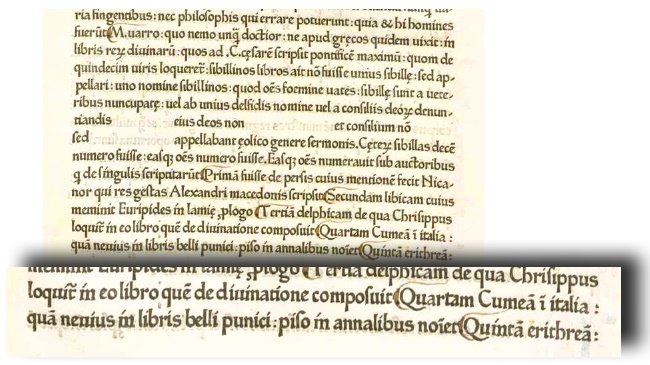

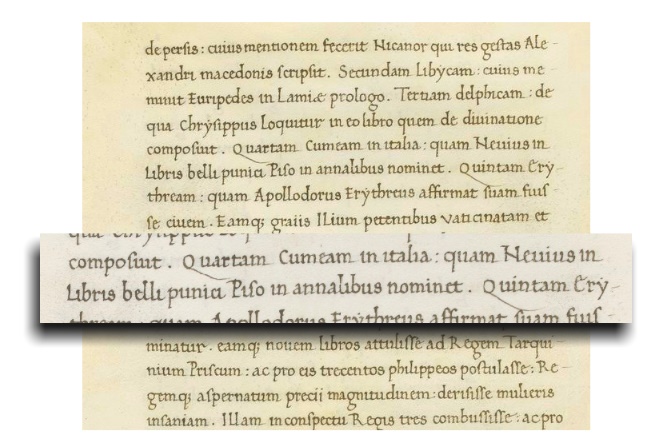

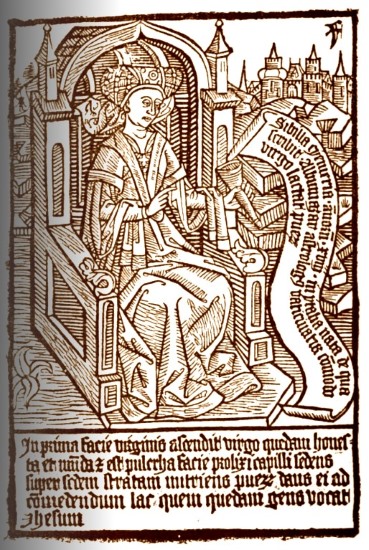



14 Giu 2018
A Sibyl called Cimmerian: exploring the potential link to the Apennine Sibyl - 3. The enigmatic fourth Sibyl
Lucius Caecilius Firmianus Lactantius, a fourth-century early-Christian author, was by no means a minor personage: he was a high-rank advisor to Emperor Constantine the Great and tutor to Emperor's son Crispus.
In his most famous work, “De Divinis Institutionibus”, he provides a remarkable quote drawn from Marcus Terentius Varro, who in turn, in a book that has now gone lost, set down what is considered as the canonical list of ten Sibyls belonging to ancient, classical times.
«It is known that Sibyls were ten in number. Marcus Varro enumerated them all under the writers, who wrote an account of each. The first was from the Persians, and of her Nicanor made mention, who wrote the deeds of Alexander of Macedon. The second was of Libya...»
[In the original Latin text: «Ceterum Sibillas decem numero fuisse. Easquem omnes [M. Varro] numeravit sub auctoribus, qui de singulis scriptitarunt. Primam fuisse de Persis, cujus mentionem fecerit Nicanor, qui res gestas Alexandri Macedonis scripsit. Secundam Libicam...»].
Such are the words by Lactantius, which we will review in further detail in a future article. For the time being, it is sufficient to analyse what he states about the Cumaean Sibyl (in the figure, the oracle as portrayed by Domenico "Domenichino" Zampieri in a painting preserved at the Galleria Borghese in Rome), and the Cimmerian.
The following are Lactantius's words on the Sibyl from Cumae, as taken from a most valuable edition of “De Divinis Institutionibus” printed in 1465 at the benedictine abbey of Subiaco, Italy (see figure) and reporting the renowned episode of the books offered to the King of Rome by the clever oracle:
«... The seventh was of Cumae, by name Amalthaea, who is termed by some Demophile and they say that she brought nine books to the king Tarquinius Priscus, and asked for them three hundred philippics [a golden currency from the antique kingdom of Macedon], and that the king refused so great a price, and derided the madness of the woman; that she, in the sight of the king, burnt three of the books, and demanded the same price for those which were left; that Tarquinias much more considered the woman to be mad; and that when she again, having burnt three other books, persisted in asking the same price, the king was moved, and bought the remaining books for the three hundred pieces of gold: and the number of these books was afterwards increased, after the rebuilding of the Capitol; because they were collected from all cities of Italy and Greece, and especially from those of Erythrae, and were brought to Rome, under the name of whatever Sibyl they were».
[In the original Latin text: «Septimam Cumanam nomine Amaltheam, quae ab aliis Demophile nominatur; eamque novem libros attulisse ad regem Tarquinium priscum, ac pro eis trecentos philippeos postulasse; regemque aspernatum pretii magnitudinem, derisisse mulieris insaniam: illam in conspectu regis tres combussisse, ac pro reliquis idem pretium postulasse: Tarquinium multo magis mulierem insanire putasse. Quae denuo tribus aliis exustis, cum in eodem pretio perseveraret, motum esse regem, ac residuos trecentis aureis emisse: quorum postea numerus sit auctus, Capitolio refecto, quod ex omnibus civitatibus et Italicis, et Graecis, et praecipue Erythraeis coacti, allatique sunt Romam, cuiuscumque Sibyllae nomine fuerunt»].
That was for the Cumaean; but what about the Cimmerian Sibyl? In the classical enumeration by Lactantius, she stands out at number four, as we can read in a most precious fourteenth-century manuscript of “De divinis institutionibus” preserved at the Bibliothèque Nationale de France (Latin 1665 - see figure):
«The fourth a Cimmeriam in Italy, whom Naevius mentions in his book on the Punic war, and Piso in his annals».
[In the original Latin text: «Quartam Cimmeriam in ytalia, quam Nevius in libris belli punici Piso in annalibus nominat»].
According to Lactantius, the Cimmeriam Sibyl - like the Cumaean and the Tiburtine - is an Italian Sibyl. But where was her shrine situated? Perhaps, was it in the Apennines? Lactantius says nothing about that.
We may possibly turn to the two authors mentioned in this excerpt, 'Naevius' and 'Piso', from whim Lactantius took the mentions on the Cimmeriam Sibyl. However, their works are unfortunately lost to us, they are not extant anymore, so we cannot read into the pages of their books.
Gnaeus Naevius, an epic poet who was born in Campania in the early third century B.C., was the author of a “Bellum Poenicum”, a poetic work on the First Punic War and the story of the foundation of Rome: only fifty small literary fragments pertaining to this book are available today, and no known fragment mentions the sibilline topic at all.
Lucius Calpurnius Piso Frugi was a Roman consul in year 133 B.C. As a Latin author, he wrote the “Annales” (“Chronicles”), a work on the origin and history of Rome. Piso's books are lost too, and the few extant excerpts are not relevant to Sibyls.
So where should we turn to unveil the origin and whereabouts of the Cimmerian Sibyl?
The answer is not too far from us. Or, to be more specific, it is not too far from a place we already know.
That place is not the Apennines, as we would be glad to find out. That place, strange as it may be, is Cumae again: the Cimmerian Sibyl appears to be linked to the Cumaean oracle. Let's go and investigate why.
Una Sibilla chiamata Cimmeria: un'investigazione sulla possibile relazione con la Sibilla Appenninica - 3. L'enigma della quarta Sibilla
Lucio Cecilio Firmiano Lattanzio, un autore protocristiano del quarto secolo, non era affatto un personaggio secondario: egli fu infatti consigliere di elevatissimo rango dell'Imperatore Costantino il Grande, nonché precettore di Crispo, figlio dello stesso Imperatore.
Nella sua opera più nota, "De Divinis Institutionibus", egli riporta una significativa citazione tratta da Marco Terenzio Varrone, il quale, a propria volta, in un libro andato oggi perduto, stabilisce quello che è considerato come l'elenco canonico delle dieci Sibille appartenute al mondo classico.
«È noto come le Sibille siano state in numero di dieci. Tutte furono elencate [da Marco Varrone] sulla base degli autori che scrissero a proposito di ognuna. La prima fu la Persica, che fu menzionata da Nicanore, il quale celebrò le gesta di Alessandro il Macedone. La seconda, Libica...»
[Nel testo originale Latino: «Ceterum Sibillas decem numero fuisse. Easquem omnes [M. Varro] numeravit sub auctoribus, qui de singulis scriptitarunt. Primam fuisse de Persis, cujus mentionem fecerit Nicanor, qui res gestas Alexandri Macedonis scripsit. Secundam Libicam...»].
Tali sono le parole di Lattanzio, che avremo modo di considerare in maggior dettaglio in un futuro articolo. Per il momento, ci limiteremo ad analizzare ciò che egli scrive a proposito dellla Sibilla Cumana (in figura, l'oracolo rappresentato da Domenico Zampieri, il "Domenichino", in un dipinto conservato presso la Galleria Borghese in Roma), e della Cimmeria.
Quello che segue è ciò che scrive Lattanzio in merito alla Sibilla di Cuma, così come tratto da una preziosissima edizione dell'opera “De Divinis Institutionibus” stampata presso l'abbazia benedettina di Subiaco nel 1465 (vedere figura), e contenente il racconto del beffardo episodio relativo ai libri offerti al Re di Roma dall'astuto oracolo:
«... La settima fu Cumana, chiamata Amaltea, che alcuni chiamano Demofile; di lei si narra come avesse portato al re Tarquinio Prisco nove libri, chiedendo per essi trecento filippi [una moneta aurea dell'antico regno di Macedonia], e di come il re si fosse rifiutato di pagare un prezzo così elevato e si fosse preso gioco della follia della donna; e di come essa, di fronte agli occhi del re, avesse bruciato tre di quei libri, per poi chiedere, per i restanti, il medesimo prezzo. Tarquinio ancor più grande reputò essere la pazzia di quella donna; e quando ella ebbe bruciato tre ulteriori libri, perseverando nel richiedere lo stesso prezzo, il re infine si convinse e acquistò i tre libri che rimanevano per trecento monete d'oro. Tale numero fu poi incrementato, dopo la ricostruzione del Campidoglio, essendone acquisiti altri presso molte città dell'Italia e della Grecia, e in particolare da Eritre, e portandoli a Roma, a qualsiasi Sibilla fossero essi appartenuti».
[Nel testo originale latino: «Septimam Cumanam nomine Amaltheam, quae ab aliis Demophile nominatur; eamque novem libros attulisse ad regem Tarquinium priscum, ac pro eis trecentos philippeos postulasse; regemque aspernatum pretii magnitudinem, derisisse mulieris insaniam: illam in conspectu regis tres combussisse, ac pro reliquis idem pretium postulasse: Tarquinium multo magis mulierem insanire putasse. Quae denuo tribus aliis exustis, cum in eodem pretio perseveraret, motum esse regem, ac residuos trecentis aureis emisse: quorum postea numerus sit auctus, Capitolio refecto, quod ex omnibus civitatibus et Italicis, et Graecis, et praecipue Erythraeis coacti, allatique sunt Romam, cuiuscumque Sibyllae nomine fuerunt»].
Questo è quanto riporta Lattanzio a proposito della Cumana. Ma cosa afferma il nostro autore, invece, in merito alla Sibilla Cimmeria? Nella classica elencazione redatta dal consigliere imperiale, quest'ultima compare nella quarta posizione, come possiamo leggere in un preziosissimo manoscritto dell'opera “De Divinis Institutionibus” risalente al quattordicesimo secolo e conservato presso la Bibliothèque Nationale de France (Latin 1665 - vedere figura):
«La quarta è Cimmeria, in Italia, che Nevio menziona nei suoi libri sulla guerra punica e Pisone nei propri annali».
[Nel testo originale latino: «Quartam Cimmeriam in ytalia, quam Nevius in libris belli punici Piso in annalibus nominat»].
Secondo quanto riferisce Lattanzio, la Sibilla Cimmeria - così come anche la Cumana e la Tiburtina - è una Sibilla italica. Ma dove era collocato il suo santuario? È possibile che fosse situato tra i monti dell'Appennino? Lattanzio, a questo proposito, non dice nulla.
Potremmo forse tentare di rivolgerci ai due autori classici menzionati in questo brano, 'Nevio' e 'Pisone', dai quali Lattanzio trasse i propri riferimenti alla Sibilla Cimmeria. Purtroppo, però, le opere di questi due autori sono andate perdute: esse non esistono più, e così non possiamo più leggere ciò che fu scritto in questi antichi libri.
Gneo Nevio, un poeta epico nato in Campania nella prima metà del terzo secolo a.C., fu l'autore di un "Bellum Punicum", un'opera poetica che narrava le vicende della Prima Guerra Punica e le storie della fondazione di Roma: di questo libro, sopravvivono oggi soltanto cinquanta piccoli frammenti testuali, e nessuno di essi è relativo al tema degli oracoli sibillini.
Lucio Calpurnio Pisone Frugi è stato console romano nell'anno 133 a.C. Fu l'autore degli "Annales", un'opera sulle origini e sulla storia di Roma. Anche i volumi di Pisone sono andati perduti, e nessuno dei frammenti sopravvissuti riguarda le Sibille.
E dunque, in quale altro modo possiamo tentare di disvelare l'origine e la collocazione della Sibilla Cimmeria?
La risposta non è poi così distante dai nostri occhi. O, per essere più specifici, non è così lontana da un luogo che già conosciamo.
Questo luogo non si trova tra gli Appennini, come saremmo certamente lieti di scoprire. Il posto giusto, per quanto possa apparire strano, è sempre e ancora Cuma: la Sibilla Cimmeria pare possedere una stretta relazione con l'oracolo cumano. Andiamo a investigare perché.


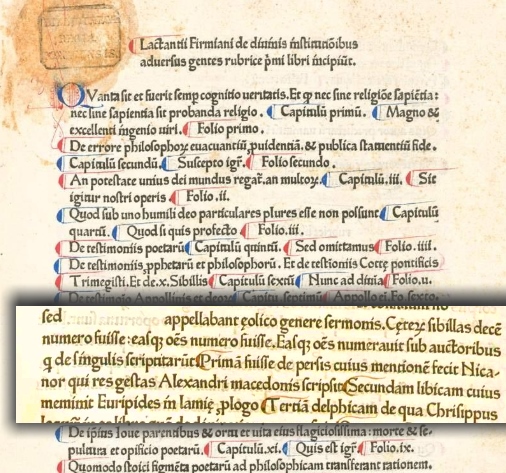

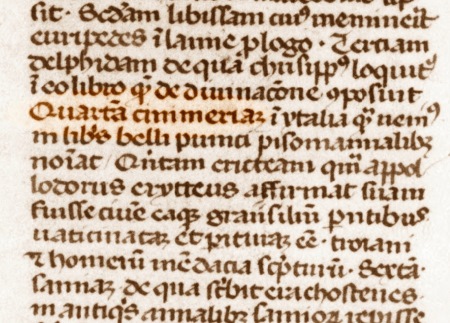

10 Giu 2018
A Sibyl called Cimmerian: exploring the potential link to the Apennine Sibyl - 2. A Cimmerian connection
In the fifteenth-century romance “Guerrino The Wretch”, Andrea da Barberino presents a Sibyl who lives under a mountain in the vicinity of Norcia: an oracle who declares that she is the Cumaean Sibyl, after having established her abode in the Apennine ridge, far from the ancient town of Cumae.
However, Francesco Maurolico, an abbot and scholar who lived in Messina (southern Italy) in the sixteenth century, does not agree with such an identification at all. In a number of different passages from his “Topographia Sanctorum Christi Martyrum”, published in 1568, he clearly states that the Apennine Sibyl is to be considered as the Cimmerian Sibyl, one of the ten classical oracles listed in Lactantius' most renowned “De Divinis Institutionibus”, a work written in the fourth century.
In a previous paper, we already published Maurolico's mentions concerning the Sibyl of Norcia; we review all of them here, for the reader's convenience:
«Ameria, an Italian town set in the Sabine region. From this town the author names the 'Emerian Sibyl', who others call the 'Cimeriam' owing to the uncertainty of the place; she lives in the caverns of Norcia, and is different from both the Cumaean and the Tiburtine Sibyls [...] Norcia, a town of the Italian region of Picenum; close to it is the Cavern of the Cimeriam Sibyl, and the lake of Demons [...] The fourth Sibyl is the Cumaeam, whom Naevius mentions in his books about the Punic war, and Piso in his annals as well; from the Cimeriam castle, also known as the Cave of Norcia, which some call by the corrupted name of 'Cymea' or 'Cymica' [...] Cumae, a town of Campania lying by the gulf of Baiae. Here was the Cumaean Sibyl, who was also called Deiphobe, and by some named as Cimmeria or Cymica, but in truth the latter is a different one in the cavern of Norcia».
[In the original Latin excerpts: «Ameria civitas Italiae in Sabinis. Hinc denominat author Sybillam Emeriam, quam alii Cimeriam vocant ab oscuritate loci, et in Nurcinis antris habitantem, atque a Cumana, et a Tyburtina diversam [...] Nurcia civitas Italiae in agro Piceno, iuxta quam est Antrum Sibyllae Cymeriae, et lacus Daemonum [...] Quartam Cumaema in Italia, quam Nevius in libris belli punici, Piso autem in annalibus nominat; ex Cimerio oppido, sive Antro nurcino, quae corrupto forte verbo Cymea, vel Cymica vocetur a nonnullis [...] Cumae Campaniae civitas in sinu Baiarum. Hic fuit Cumana Sibylla, quae Deiphobe vocatur, quae a nonnullis Cimmeria, vel Cymica dicitur, nisi haec alia sit ex antro Nurcino»].
In Maurolico's “Topographia”, a catalogue of places connected to the presence of God on earth, he repeatedly states that the Sibyl of Norcia has nothing to do with the Cumaean Sibyl, as her lineage goes back to a very different classical Sibyl. He shows no hesitation: the Sibyl of Norcia is the Emeriam - or Cimeriam, Cymeriam, Cymea, Cymica, Cimmeria - who lived in ancient times in a small town called Ameria or Cimeria, lying not far from Norcia, where the Sibyl's cave stands.
Was Francesco Maurolico right? Was a village named Ameria or Cimeria really extant in the vicinity of Norcia? Is the Sibyl of the Apennines really descending from a Cimmeriam Sibyl? And what does 'Cimmerian Sibyl' stand for?
In a preceding article, we saw that Maurolico did not take the above information from his recognised primary source, Jean Germain's “Mappemonde Spirituelle”, a work written in the fifteenth century. Furthermore, in addition to what we stated in that article, we can now show that Maurolico drew part of the information he wrote on the fourth Sibyl from another fifteenth-century work (whom Maurolico himself mentions in his introductory notes to his “Topographia”). As a matter of fact, we find almost the same wording used by Maurolico as to the «Ameria civitas» in Claudius Ptolemaeus' “Cosmographia”, in the version published in Ulm by Johann Reger in 1484. This book contains an introductory «Registrum Alphabeticum» listing a large number of geographical names referred to by Ptolemy, and - under letter 'A' - we find the following:
«Ameria (Book 3, Chapter 1, Map 6 of Europe). Here the fourth Sibyl was born. The Emerian Sibyl was born in Italy and is also known as Chemical, wearing a heavenly golden garment, with long parted hair down to her shoulders, and young; of her Ennius reports: in the first period of the Virgin, a young lady of charming aspect and long hair will rise, sitting on a throne and feeding a child with a right nourishment, a milk sent down from heaven».
[In the original Latin text: «Ameria li 3 ca 1 ta 6 europe Hic nascitur quarta sibilla. Sibilla emeria in ytalia nata, alias chimica vestita celestia veste, de aurata capillis per scapulas spartis et iuvenis, de qua enni ait. In prima facie virginis ascendit puella pulchra facie, plixa capillis, sedens super sedem stratam nutrit puerum, dans ei ad comedendum ius proprium, id est lac de celo missum»].
What does it all mean? Who is the fourth Sibyl? Why is she portrayed in a such a peculiar way? And why Maurolico seems to quote from this excerpt when he mentions the unknown town of «Ameria», although no reference is found in Reger's Ptolemy as to Norcia and its Sibyl's cave?
The matter is very complex and, at first sight, utterly puzzling. However, we will try to solve the many riddles concealed in the above excerpts, conferring an identity and a place of birth to the fourth Sibyl, the Cimmerian.
For a better understanding of the issue, we need to go back to Lucius Caecilius Firmianus Lactantius' enumeration of ten classical Sibyls, and meet, in a close encounter, the original Cimmerian Sibyl.
Una Sibilla chiamata Cimmeria: un'investigazione sulla possibile relazione con la Sibilla Appenninica - 2. L'ipotesi cimmeria
Nel romanzo quattrocentesco "Guerrin Meschino", Andrea da Barberino ci presenta una Sibilla che vivrebbe al di sotto di una montagna posta non lontano da Norcia: un oracolo che descrive se stesso come la Sibilla Cumana, trasferitasi tra le vette degli Appennini, e dunque molto lontano dall'antica città di Cuma.
Eppure, l'abate Francesco Maurolico, un erudito vissuto in Messina nel sedicesimo secolo, dichiara di non essere affatto d'accordo con questa identificazione. In vari passaggi della sua “Topographia Sanctorum Christi Martyrum”, pubblicata nel 1568, egli si presenta come convinto sostenitore dell'ipotesi che la Sibilla Appenninica coincida in realtà con la Sibilla Cimmeria, uno dei dieci oracoli classici elencati nella notissima opera di Lattanzio “De divinis institutionibus”, risalente al quarto secolo.
In un precedente articolo, abbiamo già avuto occasione di pubblicare i riferimenti proposti da Maurolico in merito alla Sibilla di Norcia; li riproponiamo integralmente qui, per maggiore comodità del lettore:
«Ameria, città dell'Italia posta nella regione Sabina. Da questa città l'autore denomina la 'Sibilla Emeria', che altri chiamano 'Cimeria' a causa dell'incertezza sul luogo; essa vive nell'antro di Norcia, ed è diversa sia dalla Cumana che dalla Tiburtina [...] Norcia, una città d'Italia nella regione del Piceno, vicino alla quale si trova l'Antro della Sibilla Cimeria, e il lago dei Dèmoni [...] La quarta Sibilla è la Cumea, di cui parla Nevio nei suoi libri dedicati alla Guerra Punica, a anche Pisone nei suoi annali; dal castello Cimerio, conosciuto anche con il nome di Antro nursino, che alcuni chiamano con il nome corrotto di 'Cymea' o 'Cymica' [...] Cuma, città della Campania nel golfo di Baia. Qui fu la Sibilla Cumana, chiamata anche Deifobe, che alcuni indicano come Cimmeria o Cymica, se questa non fosse un diverso oracolo posto nella caverna di Norcia».
[Nel testo originale latino: «Ameria civitas Italiae in Sabinis. Hinc denominat author Sybillam Emeriam, quam alii Cimeriam vocant ab oscuritate loci, et in Nurcinis antris habitantem, atque a Cumana, et a Tyburtina diversam [...] Nurcia civitas Italiae in agro Piceno, iuxta quam est Antrum Sibyllae Cymeriae, et lacus Daemonum [...] Quartam Cumaema in Italia, quam Nevius in libris belli punici, Piso autem in annalibus nominat; ex Cimerio oppido, sive Antro nurcino, quae corrupto forte verbo Cymea, vel Cymica vocetur a nonnullis [...] Cumae Campaniae civitas in sinu Baiarum. Hic fuit Cumana Sibylla, quae Deiphobe vocatur, quae a nonnullis Cimmeria, vel Cymica dicitur, nisi haec alia sit ex antro Nurcino»].
Nella “Topographia” redatta da Maurolico, comprendente un catalogo di luoghi presso i quali si rivela la presenza di Dio sulla terra, egli dichiara ripetutamente come la Sibilla di Norcia non abbia nulla a che fare con la Sibilla Cumana, in quanto l'ascendenza della prima sarebbe da riferirsi ad una ben diversa Sibilla classica. Maurolico non mostra alcuna esitazione: la Sibilla di Norcia è l'Emeria - o Cimeria, Cymeria, Cymea, Cymica, Cimmeria - la quale visse nell'antichità in una piccola città chiamata Ameria o Cimeria, che sarebbe sorta nelle vicinanze di Norcia, dove si trova la grotta della Sibilla.
Francesco Maurolico aveva ragione? Esisteva veramente un villaggio il cui nome era Ameria o Cimeria in prossimità di Norcia? La Sibilla Appenninica discende veramente dalla Sibilla Cimmeria? E cosa significa veramente 'Sibilla Cimmeria'?
In un precedente articolo, abbiamo anche visto come Maurolico non abbia tratto queste affermazioni dalla sua fonte primaria, l'opera “Mappemonde Spirituelle” di Jean Germain, compilata nel quindicesimo secolo. Inoltre, a titolo di integrazione rispetto a ciò che scrivemmo in quell'articolo, possiamo oggi mostrare come Maurolico abbia ricavato parte delle informazioni da lui riportate in merito alla quarta Sibilla da un ulteriore volume seicentesco (che lo stesso Maurolico cita nelle sue note introduttive alla "Topographia"). In effetti, possiamo ritrovare quasi le stesse parole menzionate da Maurolico in relazione alla «Ameria civitas» all'interno della "Cosmographia" di Claudio Tolomeo, nella versione pubblicata a Ulm da Johann Reger nel 1484. Questo libro contiene infatti un «Registrum Alphabeticum» introduttivo, nel quale sono elencati un gran numero di nomi di luoghi ai quali Tolomeo ha fatto riferimento, e - sotto la lettera 'A' - ecco cosa possiamo leggere:
«Ameria (Libro 2, Capitolo 1, Tavola 6 dell'Europa). Qui è nata la quarta Sibilla. La Sibilla Emeria è nata in Italia, essendo conosciuta anche come Chimica, vestita con un azzurro abito dorato, con lunghi capelli che le scendono su entrambe le spalle, e giovane; di lei così parlò Ennio: nel primo decano della Vergine, una fanciulla sorgerà di bellissimo aspetto, lunghi i capelli, assisa su di un trono e intenta a nutrire un bambino, al quale darà il nutrimento opportuno, che è latte inviato dal cielo».
[Nel testo originale latino: «Ameria li 3 ca 1 ta 6 europe Hic nascitur quarta sibilla. Sibilla emeria in ytalia nata, alias chimica vestita celestia veste, de aurata capillis per scapulas spartis et iuvenis, de qua enni ait. In prima facie virginis ascendit puella pulchra facie, plixa capillis, sedens super sedem stratam nutrit puerum, dans ei ad comedendum ius proprium, id est lac de celo missum»].
Cosa significa tutto questo? Chi è veramente la quarta Sibilla? Perché essa viene rappresentata in questo modo così peculiare? E perché Maurolico, nel menzionare la sconosciuta città di «Ameria», sembrerebbe riferirsi proprio a questo brano, benché il testo tratto dal Tolomeo nella versione di Reger non contenga affatto alcun riferimento a Norcia e alla Grotta della Sibilla?
L'intera questione pare presentarsi nel modo più complicato e, a prima vista, assolutamente sconcertante. Eppure, noi tenteremo comunque di risolvere i molti enigmi nascosti nei brani che abbiamo citato, assegnando un'identità e un luogo di nascita alla quarta Sibilla, la Cimmeria.
Per una migliore comprensione di tutto ciò, dobbiamo però ripartire dall'enumerazione delle dieci Sibille classiche tramandataci da Lucio Caecilio Firmiano Lattanzio, per affrontare, nel corso di un vero e proprio incontro ravvicinato, la Sibilla originale, quella Cimmeria.
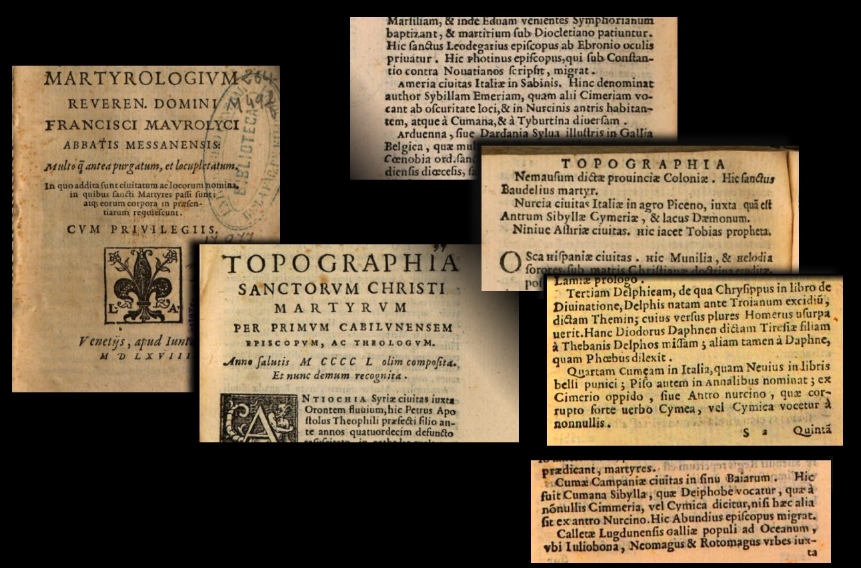

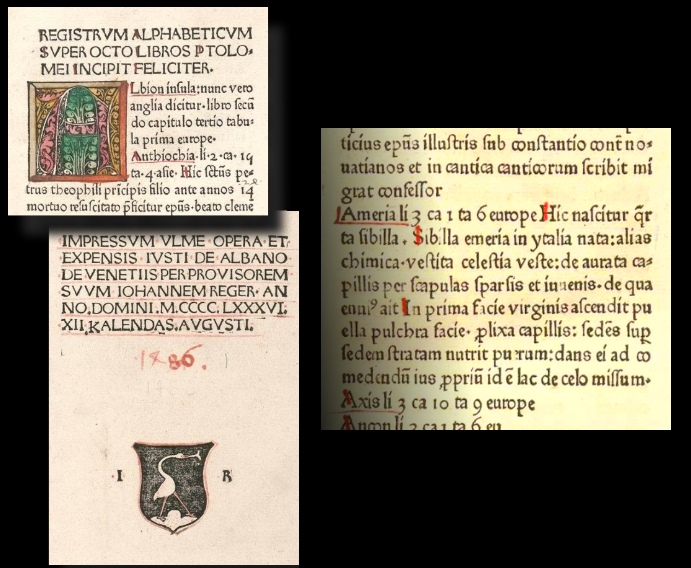

8 Giu 2018
A Sibyl called Cimmerian: exploring the potential link to the Apennine Sibyl - 1. Cumae and Norcia
The Apennine Sibyl, or the Sibyl of Norcia, has been the focus of fascinated attention throughout many centuries, from the fifteenth-century romance “Guerrino The Wretch” by Andrea da Barberino to the late nineteenth-century explorations carried out by the philologist Pio Rajna, and beyond. Dozens and dozens of literary works have mentioned her name and whereabouts, depicting an oracle who would be concealed under the rocky bulk of Mount Sibyl, in the Sibillini Mountain Range, a portion of the Italian Apennines.
According to Andrea da Barberino, the Apennine Sibyl is to be identified with the Cumaean Sibyl, a classical Sibyl who is included in the ancient enumeration provided by Lucius Caecilius Firmianus Lactantius, an author who lived in the fourth century. In the work written by Andrea da Barberino, it's the Sibyl herself who openly declares her own origin:
«I want you to know my name. I was called 'Cumaean' by the Romans for I was born in a town in the countryside whose name is Cuma: before I was sentenced to this place I lived in the world one thousand two hundred years. When Aeneas came to Italy, I led him through the nether world: and I was seven hundred years old at that time [...] And in his time [of Tarquinius Priscus] the Romans came and asked me for laws: and I sent nine books of laws to them. And in that time to my own benefit I asked to remain alive, as much as the world could ever last, until the fair judge will come for the last judgment.».
[In the original Italian text: «Io voglio che tu sapi el mio nome. Io fui chiamata da Romani chumana per che io naqui in una cità de campagna che ha nome chumana: e stete al mondo inanzi che io fosse iudicata in questa parte mille e ducento anni, che quando Enea vene i queste parte zoe in Italia, io lo menai per tuto lo inferno: e havea alhora sete cento anni [...] E nel suo tempo mandareno li Romani a domandare lezie: et io mandai a loro nove libri de lezie. Et in quello tempo per mia scientia mandai a domandare de stare in questa vita: tanto quanto el mondo de durare, et che el dreto iudice vignerà a giudicare»].
In the above excerpt, the main features which the ancient Roman tradition attributed to the Cumaean Sibyl are all mentioned by Andrea da Barberino: her role as a guide to the Otherworld as portrayed in Publius Vergilius Maro's “Aeneid” (Book VI); the nine books of sibilline prophecies offered to King Tarquinius, as reported by Lactantius; the legendary tale about her immortality, which is narrated by Publius Ovidius Naso in his “Metamorphoses”.
Andrea da Barberino also provides an explanation as to the reason for which the Cumaean Sibyl would have moved her abode to a mountain in central Italy. The Sibyl says that she was «sentenced there», a wording that refers to another old lore, dating to the early Christian era: the Sibyl, a virgin like the Holy Mary and her teacher, had conceived the whim that she could be the one to grow the son of God in her own womb; but God himself, who had already chosen Mary, devised to punish her for her unholy arrogance. And when Guerrino asks for information about the whereabouts of the Sibyl, a man tells him that
«I heard that the wise Sibyl was a virginal maid, so that she had hoped that God would enter into her when the Incarnation occurred in the Holy Mary. Because of that different choice she grieved and was then sentenced amid these mountainous ridges».
[In the original Italian text: «Io ho udito dir che ze la savia Sibilla la quale si è vergene in lo mondo che la credea che dio scendesse i(n) lei qua(n)do incarnò in Maria vergine. E per questo lei desperò e fu ziudicata per questa casone in queste montagne»].
But Guerrino's Sibyl is eager to stress that she herself has nothing to do with the Holy Mary, because that was a story connected to another Sibyl, the Albunean (better known as the Tiburtine Sibyl). When Guerrino asks the oracle whether she is the one who «was granted by the grace of God to be the teacher of the virgin who gave birth to the Saviour of our human nature» («havendoti conceduta la divina providentia la gratia che tu fosti maestra de quela verzene in cui incarnò el Salvatore de la humana natura» in Italian), the Sibyl replies harshly to him, by saying that she
«[...] has never been the one who taught our lady [...] The Sibyl you are referring to is called Albunea».
[In the original Italian text: «[...] ella non essere stata quella che insegna a nostra donna [...] La Sibilla che tu voi dire have nome Albunea»].
In the sixteenth century, the Cumaean origin of the Apennine Sibyl is mentioned by Ludovico Ariosto as well. The author of “Orlando Furioso” writes the following words:
«[...] the Cumæan Sibyl [...] who fled, in antiquity, to a Cavern in the territory of Norcia, placed on a mountain-top amidst a gloomy forest, from the charming abode she used to live in at earlier times».
[In the original Italian text: «la Sibilla Cumea, la qual ridotta / s’era in quei tempi a la Nursina grotta / su gli aspri monti in una selva folta / da i luoghi ameni, ove habitava prima»].
The Apennine Sibyl and the Cumaean: a close relationship seems to exist between the two. However, we also have the evidence of a second, different tradition, emerging from a different work written in 1568.
The work is the “Topographia Sanctorum Christi Martyrum”, written by Francesco Maurolico, and it tells us a different story. According to Maurolico, the Sibyl of Norcia is to be identified with another Sibyl: the Cimmerian.
Who is the Cimmerian Sibyl? Is she included in the classical list of ten Sibyls handed over to us by Lucius Caecilius Firmianus Lactantius in the fourth century? And what does Maurolico says about a potential link connecting the Cimmerian Sibyl and the Sibyl of Norcia?
We will now try and tread a new mysterious path in the legends and lore of Sibyls. Don't miss the chance to further step ahead in the enthralling, hidden enigma of the Apennine Sibyl.
Una Sibilla chiamata Cimmeria: un'investigazione sulla possibile relazione con la Sibilla Appenninica - 1. Cuma e Norcia
La Sibilla Appenninica, o Sibilla di Norcia, è stata per molti secoli al centro di un'attenzione affascinata e ininterrotta, a partire dal romanzo quattrocentesco "Guerrin Meschino" di Andrea da Barberino fino a giungere alle esplorazioni compiute nel tardo diciannovesimo secolo dal filologo Pio Rajna, per giungere infine sino a tempi recentissimi.
Decine e decine di opere letterarie hanno menzionato questa Sibilla e i luoghi della sua leggenda, descrivendo un oracolo che si troverebbe nascosto al di sotto della massa rocciosa del Monte Sibilla, nella regione dei Monti Sibillini, una porzione della catena degli Appennini.
Secondo Andrea da Barberino, la Sibilla Appenninica deve essere identificata con la Sibilla Cumana, una delle Sibille classiche incluse nell'antica elencazione tramandataci da Lucio Cecilio Firmiano Lattanzio, un autore vissuto nel quarto secolo. È la Sibilla stessa, nel romanzo scritto da Andrea da Barberino, a dichiarare esplicitamente la propria origine:
«Io voglio che tu sapi el mio nome. Io fui chiamata da Romani chumana per che io naqui in una cità de campagna che ha nome chumana: e stete al mondo inanzi che io fosse iudicata in questa parte mille e ducento anni, che quando Enea vene i queste parte zoe in Italia, io lo menai per tuto lo inferno: e havea alhora sete cento anni [...] E nel suo tempo [Tarquinio Prisco] mandareno li Romani a domandare lezie [leggi]: et io mandai a loro nove libri de lezie. Et in quello tempo per mia scientia mandai a domandare de stare in questa vita: tanto quanto el mondo de durare, et che el dreto iudice vignerà a giudicare».
In questo brano, Andrea da Barberino fa esplicito riferimento a tutti i principali attributi che caratterizzano la Sibilla Cumana nella tradizione antico-romana: il suo ruolo in qualità di guida nell'Oltretomba così come illustrato da Publio Virgilio Marone nell'"Eneide" (Libro VI); i nove libri di oracoli sibillini offerti al Re Tarquinio, così come riferito da Lattanzio; il leggendario racconto della sua immortalità, narratoci da Publio Ovidio Nasone nelle sue "Metamorfosi".
Andrea da Barberino ci propone anche una spiegazione in merito alla ragione per la quale la Sibilla Cumana avrebbe trasferito la propria dimora presso una remota montagna dell'Italia centrale. La Sibilla afferma infatti di essere stata «iudicata in questa parte», una frase che pare riferirsi ad un'altra antica leggenda, risalente agli albori della Cristianità: la Sibilla, una vergine così come anche Maria e maestra di quest'ultima, avrebbe accarezzato l'idea di potere essere lei stessa a portare nel proprio grembo il figlio di Dio; ma Dio stesso, che già aveva prescelto Maria Vergine, deliberò di punire quella Sibilla per la propria blasfema arroganza. E quando Guerrino tenta di informarsi su dove egli debba recarsi per incontrare la Sibilla, un uomo gli risponde nel modo seguente:
«Io ho udito dir che ze la savia Sibilla la quale si è vergene in lo mondo che la credea che dio scendesse i(n) lei qua(n)do incarnò in Maria vergine. E per questo lei desperò e fu ziudicata per questa casone in queste montagne».
Ma è la stessa Sibilla del "Guerrino" a voler precisare che lei medesima non ha proprio nulla a che fare con la Santa Vergine, perché quella storia sarebbe connessa ad un'altra e diversa Sibilla, l'Albunea (meglio nota come Sibilla Tiburtina). Infatti, quando Guerrino si rivolge all'oracolo chiedendole se fosse lei quella che avrebbe desiderato vedersi «conceduta la divina providentia la gratia che tu fosti maestra de quela verzene in cui incarnò el Salvatore de la humana natura», la Sibilla gli risponde con fare alquanto seccato, affermando che
«[...] ella non essere stata quella che insegna a nostra donna [...] La Sibilla che tu voi dire have nome Albunea».
Nel sedicesimo secolo, l'origine cumana della Sibilla Appenninica viene citata anche da Ludovico Ariosto. L'autore dell'"Orlando Furioso" scrive infatti i seguenti versi:
«la Sibilla Cumea, la qual ridotta / s’era in quei tempi a la Nursina grotta / su gli aspri monti in una selva folta / da i luoghi ameni, ove habitava prima».
La Sibilla Appenninica e la Sibilla Cumana: pare che un legame estremamente stretto connetta tra di loro i due oracoli. Eppure, sussiste anche l'evidenza di una seconda tradizione, differente da questa già citata, che emerge consultando un diverso volume pubblicato nel 1568.
Quel volume è la “Topographia Sanctorum Christi Martyrum”, scritto da Francesco Maurolico, il quale pare raccontarci una storia differente. Secondo quanto afferma Maurolico, la Sibilla di Norcia sarebbe da identificarsi con un'altra Sibilla: la Cimmeria.
Ma chi è la Sibilla Cimmeria? È forse inclusa anch'essa nella classica elencazione comprendente dieci Sibille tramandataci da Lucio Cecilio Firmiano Lattanzio nel quarto secolo? E cosa afferma esattamente Maurolico a proposito del potenziale legame che sussisterebbe tra la Sibilla Cimmeria e la Sibilla di Norcia?
Proveremo ora a intraprendere un nuovo, misterioso percorso nel leggendario mito della Sibilla. Non perdete l'opportunità di camminare su strade in precedenza quasi completamente sconosciute attraverso l'affascinante, enigmatico segreto della Sibilla Appenninica.
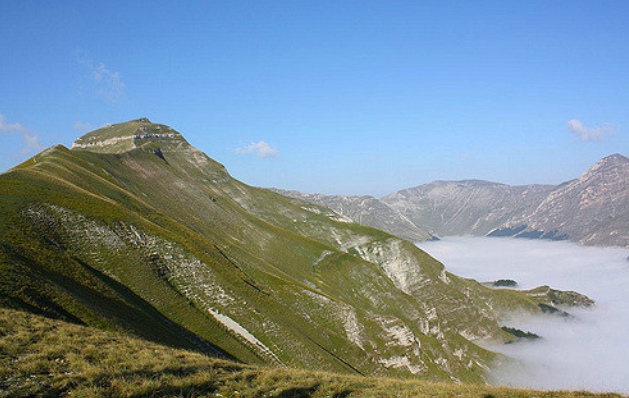

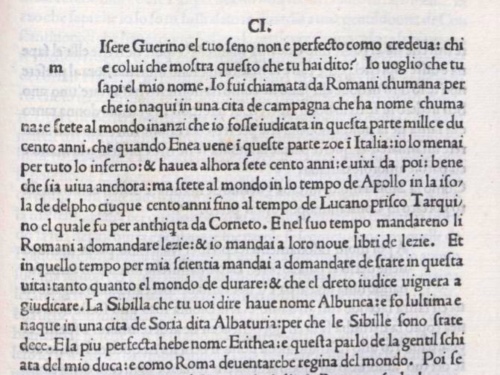

17 Mag 2018
A mysterious quote from «Bishop Primus Cambilunensis» unveiled - 6. The search goes on
«Ameria, an Italian town set in the Sabine region», writes Francesco Maurolico in his “Topographia Sanctorum Christi Martyrum” in 1568. «From this town the author names the 'Emerian Sibyl', who others call the 'Cimeriam' owing to the uncertainty of the place; she lives in the caverns of Norcia, and she is different from both the Cumaean and the Tiburtine Sibyls». These words will be quoted by Father Fortunato Ciucci in his “Chronicles of the Antique Town of Norsia” written in 1650.
Francesco Maurolico, an abbot who lived in Messina, introduced his book with the statement that it was drawn from «Primus Cabilunensis, bishop and theologist, once composed in the Year of Salvation 1450 and now at last complemented» [in the original Latin text: «per Primum Cabilunensem, episcopum, ac theologum, Anno salutis MCCCCL olim composita Et nunc demum recognita»].
By following the faint clues leading to the unknown identity of 'Primus Cabilunensis', we have ascertained that 'Primus' was the pen name of Jean Germain, a bishop of the French town of Chalon-sur-Saône, who in 1449 wrote a “Spiritual World Map” (“Mappemonde Sprituelle”), which made up the primary source of Maurolico's work.
However, by consulting the ancient original manuscript of the “Mappemonde Spirituelle”, we found out that Jean Germain never wrote a single word about a Sibyl of Norcia, nor provided any reference to an Amerian or Cimerian Sibyl.
So, all such references to Norcia and a cavern and a Sibyl and a village named Ameria were included in Maurolico's book by Maurolico himself.
Can we assume that Francesco Maurolico did not just copy from Jean Germain, and introduced additional information instead?
Yes, the surmise is fully correct. It is Maurolico himself who tells the reader that he «complemented» the information coming from Primus Cabilunensis. Furthermore, in the foreword to his “Martyrologium” - which includes his “Topographia” - Maurolico writes the following sentence, which shows that Jean Germain's work was the primary yet not the sole source:
«In all that I definitely took great advantage from the 'Topographia' by bishop Primus Cabilunensis, who lived some one hundred years ago».
[In the original Latin text: «Ad haec multum mihi contulit, quaedam Primi Cabilunensis episcopi Topographia, qui centesimo fere ab hinc anno vixit»].
We have already shown that Francesco Maurolico had a peculiar interest in Sibyls, so much so that he included a specific section specifically dedicated to the sibilline oracles, «On Sibyls and other authors» [in the original Latin text: «De Sibyllis, et variis Authoribus»]. And he did like to elaborate on the subject by adding additional information with respect to what he could read in Jean Germain's manuscript.
As an example, let's consider Jean Germain's excerpt on the town of Cumae. Here is what the French bishop says (see figure):
«Town of Cumea. The seventh Sibyl was born here, she was called Cumaean when Tarquinius reigned [...] Here St. Abundius was bishop [...]» («Cité cumane. Cy fut née la septième Sibile appellée cumane autemps de Terquinus [...] Cy fut evesque saint Abonde [...]»)
But Maurolico was not satisfied with what Germain had written, so he introduced additional information (actually the following is the fourth mention provided by Maurolico as to a Sibyl of Norcia):
«Cumae, a town of Campania lying by the gulf of Baiae. Here was the Cumaean Sibyl, who was also called Deiphobe, and by some named as Cimmeria or Cymica, but in truth the latter is a different one in the cavern of Norcia. Here bishop Abundius passed away».
[In the original Latin text: «Cumae Campaniae civitas in sinu Baiarum. Hic fuit Cumana Sibylla, quae Deiphobe vocatur, quae a nonnullis Cimmeria, vel Cymica dicitur, nisi haec alia sit ex antro Nurcino. Hic Abundius episcopus migrat»].
So it is now certain that Francesco Maurolico did not draw his mentions of a Sibyl of Norcia from Jean Germain. Where did he take them from?
It is no easy task to provide an answer to this crucial question. As a matter of fact, Maurolico made use of a number of different sources which, after re-elaboration, finally made up his “Topographia”, as noted by many authors (Gabriel Le Bras among others). Therefore, this might be a topic for further study targeted at spotting the original source which Maurolico is quoting when he provides mentions of the Sibyl of Norcia and the Amerian or Cimmerian Sibyl.
Father Fortunato Ciucci, abbot Francesco Maurolico, bishop Jean Germain: three authors belonging to three different centuries who each took part, in one way or the other, in the long-lasting mystery connected to the Apennine Sibyl and her legend. A thrilling ride across time, which casts additional light over an enigma which is still enshrouded in darkness: one of the most fascinating legends of ancient Italy.
Una misteriosa citazione da «Primo Cambilunense Vescovo» svelata - 6. La ricerca continua
«Ameria, città dell'Italia posta nella regione Sabina», scrive Francesco Maurolico nella sua “Topographia Sanctorum Christi Martyrum” nel 1568. «Da questa città l'autore denomina la 'Sibilla Emeria', che altri chiamano 'Cimeria' a causa dell'incertezza sul luogo; essa vive nell'antro di Norcia, ed è diversa sia dalla Cumana che dalla Tiburtina». Queste parole saranno successivamente menzionate da Padre Fortunato Ciucci nelle proprie "Historie dell'antica città di Norsia", scritte nel 1650.
Francesco Maurolico, abate messinese, introduceva la propria opera con l'affermazione che essa era tratta da «Primo Cabilunense, vescovo e teologo, un tempo composta nell'Anno della Salvezza 1450 e ora finalmente integrata» [nel testo originale latino: «per Primum Cabilunensem, episcopum, ac theologum, Anno salutis MCCCCL olim composita Et nunc demum recognita»].
Seguendo i labili indizi che conducono alla sconosciuta identità di 'Primo Cabilunense', abbiamo potuto accertare come 'Primo' non fosse altro che lo pseudonimo di Jean Germain, vescovo della città francese di Chalon-sur-Saône, il quale nel 1449 scrisse un "Mappamondo Spirituale" ("Mappemonde Spirituelle"), che andò a costituire la fonte primaria dell'opera di Maurolico.
Eppure, consultando l'antico manoscritto del "Mappemonde Spirituelle", troviamo che Jean Germain non scrisse nemmeno una singola parola a proposito di una Sibilla di Norcia, né menzionò in alcun modo una Sibilla Ameria o Cimeria.
E dunque, tutte quelle citazioni relative a Norcia e a una caverna e a una Sibilla e a un villaggio chiamato Ameria furono introdotte, nel volume di Maurolico, da Maurolico stesso.
È possibile allora supporre che Francesco Maurolico non si sia limitato meramente a copiare da Jean Germain, e abbia anzi introdotto informazioni aggiuntive tratte da altre fonti?
Sì, questa ipotesi è assolutamente corretta. È lo stesso Maurolico a informare il lettore di come egli abbia «integrato» i dati reperiti nell'opera di Primo Cabilunense. Inoltre, nell'introduzione al suo "Martyrologium" - che include la sua "Topographia" - Maurolico scrive le seguenti parole, le quali mostrano come Jean Germain abbia costituito la fonte primaria, ma non la sola:
«In queste cose certamente molto mi giovò la 'Topographia' del vescovo Primo Cabilunense, che visse circa cento anni fa».
[In the original Latin text: «Ad haec multum mihi contulit, quaedam Primi Cabilunensis episcopi Topographia, qui centesimo fere ab hinc anno vixit»].
Abbiamo già evidenziato come Francesco Maurolico dimostrasse un particolare interesse per le Sibille, tanto da inserire una sezione specificatamente dedicata agli oracoli sibillini, «Sulle Sibille, e altri autori» [nel testo originale latino: «De Sibyllis, et variis Authoribus»]. L'abate messinese, effettivamente, non si sottrasse alla tentazione di integrare le singole voci, aggiungendo ulteriori informazioni rispetto a quelle che è possibile reperire nell'opera di Jean Germain.
A titolo di esempio, andiamo a leggere il brano di Jean Germain relativo alla città di Cuma. Ecco cosa scrive il vescovo francese (vedere figura):
«Città di Cuma. Qui nacque la settima Sibilla chiamata Cumana ai tempi di Tarquinio [...] Qui fu vescovo Sant'Abbondio [...]» («Cité cumane. Cy fut née la septième Sibile appellée cumane autemps de Terquinus [...] Cy fut evesque saint Abonde [...]»)
Ma per Maurolico ciò che è riportato in Jean Germain non pare essere sufficiente, e così vengono introdotte ulteriori informazioni (in effetti quella che segue è la quarta citazione fornitaci da Maurolico in relazione alla Sibilla di Norcia):
«Cuma, città della Campania nel golfo di Baia. Qui fu la Sibilla Cumana, chiamata anche Deifobe, che alcuni indicano come Cimmeria o Cymica, se questa non fosse un diverso oracolo posto nella caverna di Norcia. Qui morì il vescovo Abbondio».
[Nel testo originale latino: «Cumae Campaniae civitas in sinu Baiarum. Hic fuit Cumana Sibylla, quae Deiphobe vocatur, quae a nonnullis Cimmeria, vel Cymica dicitur, nisi haec alia sit ex antro Nurcino. Hic Abundius episcopus migrat»].
E così, possiamo affermare con certezza che Francesco Maurolico non trasse le proprie citazioni in merito a una Sibilla di Norcia da Jean Germain. Ma allora, dove reperì quelle citazioni?
Fornire una risposta a questa cruciale domanda non pare essere compito facile. È noto infatti come Maurolico abbia fatto uso di varie fonti differenti, le quali, a valle di una rielaborazione da parte dell'autore, andarono infine a costituire la sua "Topographia", così come rilevato da diversi studiosi (tra gli altri Gabriel Le Bras). È per questo che tutto ciò potrà essere oggetto di ulteriori studi mirati all'identificazione della fonte originale utilizzata da Maurolico a proposito dei riferimenti concernenti una Sibilla di Norcia e una Sibilla Ameria o Cimmeria.
Padre Fortunato Ciucci, l'abate Francesco Maurolico, il vescovo Jean Germain: tre autori vissuti in tre differenti secoli, tre studiosi i quali hanno tutti preso parte, in un modo o nell'altro, a quel duraturo mistero connesso alla Sibilla Appenninica e alla sua leggenda. Un emozionante viaggio attraverso il tempo, in grado di gettare nuova luce su di un enigma che è ancora avvolto nell'oscurità: una delle leggende più affascinanti dell'antica Italia.
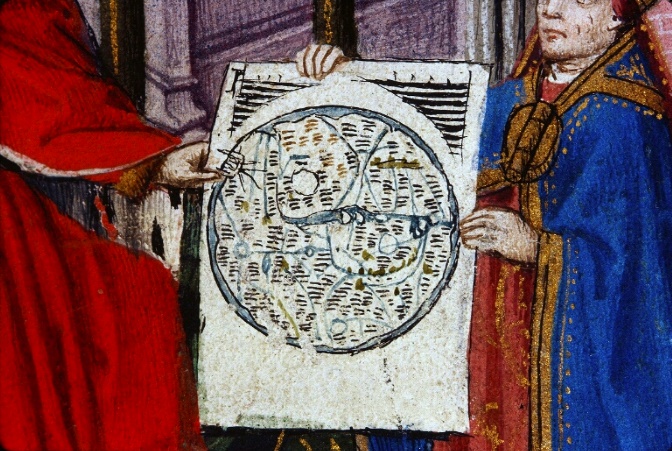

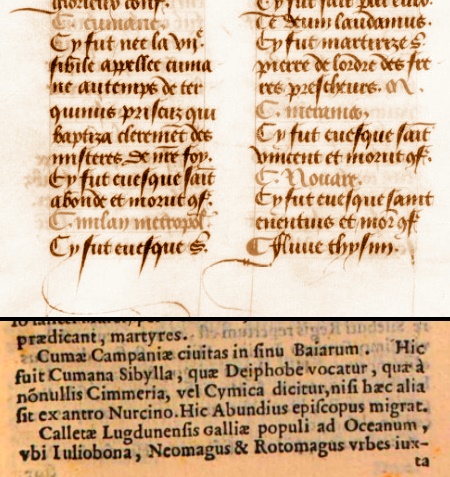

15 Mag 2018
A mysterious quote from «Bishop Primus Cambilunensis» unveiled - 5. The "Mappemonde Spirituelle" by Jean Germain
«Jehan Germain, professor of theology in Paris and by the grace of God bishop of Chalon-sur-Saône, [...] Chancellor of the Golden Fleece, in honour and homage. As many have already portrayed many different wordly maps by indicating in them the regions and countries and towns and castles and the seas [...], beasts and snakes and birds and fish and monsters to exhibit the wonders of the world [...] we made up in the year of the Lord 1449 this world map which, in contrast to the others, might be called a spiritual one»
[In the old French text: «Jehan Germain, docteur en theologie a Paris par la grace de dieu evesque de Chalon sur la Soone [...] Chancellier de [l']ordre de la touson dor, tout honneur and reverence. Que'en consideration que plusieurs se sont occupez a portraire diverses mappemondes temporelles et en illes ont consigné les provinces, pays, aucunes citez, villes, chasteaulx, mers [...] bestes, serpens, oyseaulx, poissons et monstres alfin se congnoistre les merveilles du monde [...] Avons l'an de notre seigneur 1449 fait cette mappemonde et icelle a la difference des autres appeller spirituelle»].
This is the opening of the “Spiritual world map” (“Mappemonde Spirituelle”) written by Jean Germain - which we know under the pen name «Primus Cambilunensis» - in the fifteenth century: a work that intended to convey the picture of a physical world in which God had performed sacred deeds through his holy heralds, including apostles, martyrs, priests and blessed maidens («apotres, les plus nommés martyrs, confesseurs, vierges»).
Did Jean Germain include an Apennine Sibyl in his geography of hallowed preachers and announcers of the Salvation scattered all around the known world? Abbot Francesco Maurolico in the sixteenth century and Father Fortunato Ciucci in the seventeenth alleged that the French bishop actually mentioned a Sibyl of Norcia in his “Mappemonde”. Is that true?
To find out, we need to address one of the five extant manuscripts of Germain's “Spiritual world map”, such as the illuminated manuscript from Lyon, from which we draw the fine miniature which shows the bishop of Chalon-sur-Saône presenting his work to Duke Philip the Good of Burgundy; or the instance preserved at the Bibliothèque Nationale de France (Département des Manuscrits, Français 13235).
Let's go through the pages of the latter: Jean Germain brings us across Arabia, Syria, Judea, Cappadocia, Mesopotamia, Armenia, and India, and African regions such as Ethiopia and Egypt, all of them with their saints and martyrs; we are then transferred to Europe, with Dalmatia, Russia, and the lands of Goths, Saxony, Hungary, Germany, Sweden. Italy is now close, with Naples and the Calabria. The French bishop continues his enumeration by listing Spoleto and Perugia and Rome and many other Italian towns, including Florence, Bologna, Siena and Venice, which preserved the body of St. Mark the Evangelist. After that, the text goes on with Spain and France and England, and ends up with «Ybernie», today's Ireland.
But no single reference to a Sibyl of the Apennines is found anywhere in Jean Germain's text.
So in the year 1449, in his “Mappemonde Spirituelle”, Jean Germain, also known as 'Primus Cambilunensis', never wrote the sentences on the Sibyl of Norcia which were subsequently attributed to him by Francesco Maurolico and, a century later, by Father Fortunato Ciucci.
So it was Maurolico, in 1568, who included in his book, the “Topographia Sanctorum Christi Martyrum”, the words concerning a Sibyl in the caverns of Norcia and her qualifiers as Ameria, Emeriam or Cimeriam. And he did not draw them from Jean Germain.
We have reached the bottom end of our search. In the next article, we will summarise the results of our ride across three centuries and propose further lines of study.
Una misteriosa citazione da «Primo Cambilunense Vescovo» svelata - 5. Il "Mappemonde Sprituelle" di Jean Germain
«Jehan Germain, dottore in teologia a Parigi per la grazia di dio vescovo di Chalon-sur-Saône, [...] Cancelliere dell'ordine del Toson d'Oro, ogni onore e reverenza. In considerazione del fatto che molti si sono occupati di ritrarre diverse mappe del mondo temporale e in esse hanno rappresentato province, paesi, molte città, castelli, mari [...] belve, serpenti, uccelli, pesci e mostri affinché si conoscano le meraviglie del mondo [...] noi abbiamo fatto, l'anno di Nostro Signore 1449, questo mappamondo e questo, a differenza degli altri, lo si chiami spirituale»].
[Nel testo in antico francese: «Jehan Germain, docteur en theologie a Paris par la grace de dieu evesque de Chalon sur la Soone [...] Chancellier de [l']ordre de la touson dor, tout honneur and reverence. Que'en consideration que plusieurs se sont occupez a portraire diverses mappemondes temporelles et en illes ont consigné les provinces, pays, aucunes citez, villes, chasteaulx, mers [...] bestes, serpens, oyseaulx, poissons et monstres alfin se congnoistre les merveilles du monde [...] Avons l'an de notre seigneur 1449 fait cette mappemonde et icelle a la difference des autres appeller spirituelle»].
Così comincia il "Mappamondo Spirituale" (“Mappemonde Spirituelle”) scritto da Jean Germain - che noi conosciamo con lo pseudonimo di 'Primo Cambilunense' - nel quindicesimo secolo: un'opera che intendeva rappresentare un mondo fisico e reale, nel quale Dio aveva però agito santificandolo con la presenza e le azioni degli araldi da Lui prescelti, quali apostoli, martiri, chierici e sante vergini («apotres, les plus nommés martyrs, confesseurs, vierges»).
Jean Germain inserì anche una Sibilla Appenninica, in quella sua geografia sacra fatta di predicatori e messaggeri della Salvezza disseminati lungo tutta l'estensione del mondo a quel tempo conosciuto? L'abate messinese Francesco Maurolico, nel sedicesimo secolo, e il nursino Padre Fortunato Ciucci, nel diciassettesimo, affermarono che il vescovo francese avesse realmente menzionato una Sibilla di Norcia nel proprio "Mappemonde". Ma è proprio così?
Per verificare come stiano effettivamente le cose, dobbiamo rivolgerci a uno dei cinque manoscritti superstiti del "Mappamondo Spirituale" di Jean Germain, come il bel manoscritto conservato a Lione, dal quale traiamo la preziosa miniatura che mostra il vescovo di Chalon-sur-Saône nell'atto di offrire la propria opera al Duca Filippo il Buono di Borgogna; oppure, l'esemplare custodito presso la Bibliothèque Nationale de France (Département des Manuscrits, Français 13235).
Andiamo a sfogliare le pagine di quest'ultimo: Jean Germain ci conduce attraverso l'Arabia, la Siria, la Giudea, la Cappadocia, e poi la Mesopotamia, l'Armenia, l'India e le regioni dell'Africa, come l'Etiopia e l'Egitto, tutte con i propri santi e i propri màrtiri; ci trasporta inoltre in Europa, con la Dalmazia, la Russia e le terre dei Goti, la Sassonia, l'Ungheria, la Germania e la Svezia. L'Italia si avvicina, con Napoli e la Calabria. Il vescovo francese continua ancora la propria elencazione, nominando Spoleto e Perugia e Roma e molte altre città italiane, tra le quali Firenze, Bologna, Siena e Venezia, nella quale si trova il corpo dell'evangelista Marco. Infine, il testo si muove verso la Spagna, la Francia e l'Inghilterra, fino a terminare con «Ybernie», la moderna Irlanda.
Nell'opera, non appare alcuna menzione che riguardi una Sibilla degli Appennini.
E dunque, nell'anno 1449, nel suo "Mappamonde Spirituelle", Jean Germain, noto anche come 'Primo Cambilunense', non scrisse mai quelle frasi concernenti la Sibilla di Norcia che gli furono successivamente attribuite da Francesco Maurolico e, un secolo più tardi, da Padre Fortunato Ciucci.
Così, possiamo affermare che fu Maurolico, nel 1568, a inserire nel proprio volume, la “Topographia Sanctorum Christi Martyrum”, quelle parole relative a una Sibilla presente nelle caverne di Norcia, caratterizzandola con le qualificazioni di Ameria, Emeria o Cimeria. E non si tratta di parole tratte dall'opera di Jean Germain.
Abbiamo quasi raggiunto il termine della nostra ricerca. Nel prossimo articolo, riepilogheremo i risultati del nostro viaggio attraverso tre secoli e proporremo ulteriori percorsi di studio e di investigazione.


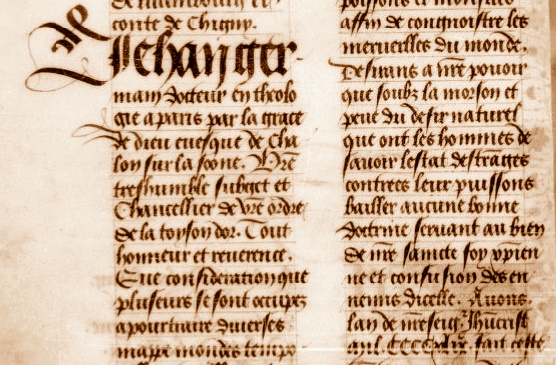

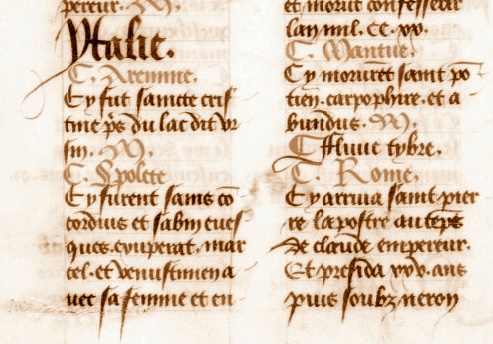

8 Mag 2018
A mysterious quote from «Bishop Primus Cambilunensis» unveiled - 4. In search of the shadowy identity of 'Primus'
Now the time has come to unveil the identity of 'Primus Cambilunensis', allegedly the original source from which Francesco Maurolico, in 1568, extracted a number of cryptic mentions about the Apennine Sibyl, and also the «bishop and theologist» quoted by Father Fortunato Ciucci from Norcia who, a century later, in 1650, reported a similar mention concerning the same Sibyl.
We know that 'Primus' is connected to Chalon-sur-Saône, the ancient French town of 'Cabillonum'. Furthermore, we know that he was a bishop, though no bishop with such name is listed in the historical records of Chalon-sur-Saône. Finally, we know that in 1450 he wrote some kind of “Topography of Martyrs”, as attested in both Ciucci and Maurolico.
So who is 'Primus'?
We are about to follow so faint a trace that it seems quite impossible we have any chance to succeed. However, you will see that we will finally get through. Let's start and find out who 'Primus Cambilunensis' was.
As a matter of fact, we are able to positively retrieve an additional excerpt which does mention our unknown Primus.
Let's turn to the antique pages of a most precious book: the “Cosmographia” of second-century Roman-Greek author Claudius Ptolemaeus (Ptolemy in modern English). However, we are not going to address the ancient extant manuscripts, written in Greek. We want to read from a later, particularly rare printed version, that published in Latin by Johann Reger, in Ulm, a German town, in 1486.
Reger's version begins with an alphabetical list of places, including information which is not to be ascribed to Ptolemy, as it manifestly refers directly to Reger's age. And, under letter 'C', we find a place whose name is «Cabulium»: this is nothing else than 'Cabillonum', or, in our modern times, Chalon-sur-Saône.
What does Reger write about «Cabulium»? Here are his precise words:
«Cabulium [...] Here [was] the noble Primus, German bishop and professor of sacred theology, who in the year of our Lord 1450 arranged the saints in his world map, which is called a spiritual one».
[In the original Latin text: «Cabulium [...] Hic dominus primus germani episcopus sacre theologie professor qui anno domini 1450 hos sanctos composuit in sua mappa mundi que spiritualis dicitur»].
We are getting closer and closer to our target: in Chalon-sur-Saône, in 1450, someone composed a “world map of saints”, the same kind of literary work attributed to 'Primus' by Ciucci and Maurolico, and he was a «German bishop».
Now, if we peruse the list of bishops who held the post in Chalon-sur-Saône throughout the centuries, we find that between 1436 and 1461 the position was occupied by a Jean Germain. He was a scholar and an author of pious literary works. His family name was 'Germain': even though he was not German (he was born in Cluny), its surname sounds like the «German bishop» mentioned by Reger.
However, his name was 'Jean', not 'Primus'. So what shall we do with this unfit name?
To solve the riddle, we have to draw on another remarkable book, a posthumous work published in 1725, written by a certain Adrien Baillet, an erudite and priest who lived in Paris in the second half of the seventeenth century. His “Scholarly Opinions on the Main Works of the Writers” (“Jugemens des Savans sur les Principaux Ouvrages des Auteurs”) is a quite unbelievable, mammoth collection, made up of eight books, of literary criticism applied to all sorts of writers and poets, starting from classical authors and up to Baillet's age.
In Book 5, Baillet explores the world of the «Authors in disguise» [«Les auteurs déguisés»] by listing hundreds and hundreds of 'noms de plume' for just as much authors. And, under letter 'P', we find the following pen name:
«Primus: Jean Germain».
There we are. We got it. At last we discovered the true identity of «Primus Cambilunensis»: he is Jean Germain, bishop of Chalon-sur-Saône from 1436 to 1461, whose pen name was 'Primus'.
As a matter of fact, “The Apennine Sibyl - A Mystery and a Legend” is not first in achieving such result, as it had already been stated by other scholars (Baudouin de Gaiffier and Gabriel Le Bras in the first half of the twentieth century); however, the fanciful steps we have been retracing - from Fortunato Ciucci to Francesco Maurolico, from Johann Reger's edition of Ptolemy's “Cosmographia” to Adrien Baillet's ponderous work - are fully original: a treasure hunt carried out across various different authors and centuries.
Now, to crosscheck our guess, we only need to inspect whether Jean Germain, the fifteenth-century French bishop, did actually write and publish any “Topography of Martyrs”.
He did. In 1449, he composed a “Spiritual Worldmap” (“Mappemonde Spirituelle” in French), containing information on which places were made holy by saints, apostles and martyrs with their presence, sermons and deeds.
So we are now about to open Jean Germain's “Worldmap” and see whether we can find in it any reference to Norcia and the Apennine Sibyl, as alleged by Fortunato Ciucci and Francesco Maurolico. Nobody has ever read the work of Jean Germain with the intention of performing such a check.
Let's see what happens.
Una misteriosa citazione da «Primo Cambilunense Vescovo» svelata - 4. Alla ricerca dell'elusiva identità di 'Primo'
È arrivato il momento di svelare l'identità di 'Primo Cambilunense', il quale, secondo Francesco Maurolico, costituirebbe la fonte originale dalla quale l'abate messinese trasse, nel 1568, una serie di enigmatici riferimenti concernenti la Sibilla Appenninica, nonché il «Vescovo e Teologo» che Padre Fortunato Ciucci da Norcia menzionerà nel riferire di una simile citazione a proposito della medesima Sibilla, un secolo più tardi, nel 1650.
Sappiamo come 'Primo' sia legato a Chalon-sur-Saône, l'antica città di 'Cabillonum'. Inoltre, sappiamo anche che egli fu vescovo di quella città, benché nessun vescovo con tale nome risulti essere elencato nella lista di presuli storici di Chalon-sur-Saône. Infine, sappiamo anche che, nel 1450, il nostro ignoto personaggio si dedicò alla compilazione di un qualche genere di "Topografia di Màrtiri", come attestato sia dal Ciucci che dal Maurolico.
Insomma, chi fu mai questo 'Primo'?
Stiamo per seguire una traccia così labile da rendere quasi impossibile conseguire un successo. Eppure, vedrete che riusciremo a farcela. Cominciamo, dunque, e andiamo a indovinare chi fu 'Primo Cambilunense'.
Come ulteriore elemento fattuale, possiamo affermare di essere in grado di rintracciare un ulteriore brano che fa menzione del nostro ignoto 'Primo'.
Andiamo dunque a sfogliare le antiche pagine di un volume estremamente prezioso: la "Cosmographia" dell'autore greco-romano Claudio Tolomeo, vissuto nel secondo secolo d.C. Non andremo però ad esplorarne il testo greco, riportato dai più antichi manoscritti ancora esistenti; ci rivolgeremo, invece, a una più tarda, rarissima edizione a stampa, pubblicata in lingua latina da Johann Reger, a Ulm, in Germania, nel 1486.
La versione di Reger comincia con un elenco alfabetico di luoghi, il quale comprende informazioni non ascrivibili all'originale di Tolomeo, in quanto relativo a notizie risalenti all'epoca dello stesso Reger. E, sotto la lettera 'C', ci imbattiamo in un luogo il cui nome è «Cabulium»: si tratta di null'altro che di 'Cabilllonum', o, come diremmo oggi, Chalon-sur-Saône.
E cosa scrive Reger a proposito di «Cabulium»? Ecco le sue esatte parole:
«Cabulium [...] Qui [fu] il nobile Primo, vescovo della Germania e professore della sacra teologia, il quale nell'anno del Signore 1450 collocò i santi nella sua mappa del mondo, che è chiamata mappa spirituale»].
[Nel testo originale latino: «Cabulium [...] Hic dominus primus germani episcopus sacre theologie professor qui anno domini 1450 hos sanctos composuit in sua mappa mundi que spiritualis dicitur»].
Ci stiamo avvicinando sempre di più al nostro obiettivo: a Chalon-sur-Saône, nel 1450, qualcuno compilò un "mappamondo dei santi", lo stesso genere di opera letteraria attribuita a 'Primo' da Ciucci e Maurolico; egli, inoltre, era un «vescovo della Germania».
Ora, se andiamo a consultare la lista dei vescovi che hanno ricoperto questa carica ecclesiastica a Chalon-sur-Saône nel corso dei secoli, troviamo che tra il 1436 e il 1461 la posizione era occupata da un certo Jean Germain. Un erudito, un autore di opere letterarie di argomento religioso. Il suo cognome era 'Germain': benché egli non fosse tedesco (essendo nato a Cluny), questo cognome pare ricordare proprio quel «vescovo della Germania» di cui ci parla Reger.
Il problema è che il suo nome era 'Jean', non 'Primo'. E dunque, cosa dobbiamo pensare di questa incongruenza tra i nomi di battesimo?
Per risolvere questo rebus, dobbiamo rivolgerci ad un altro peculiare volume, un'opera postuma pubblicata nel 1725, il cui autore è un certo Adrien Baillet, anch'egli un erudito, un canonico vissuto a Parigi nella seconda metà del '600. I suoi "Giudizi dei sapienti sulle principale opere degli scrittori" (“Jugemens des Savans sur les Principaux Ouvrages des Auteurs”) è un'incredibile, gigantesca raccolta, composta da ben otto libri, di critiche letterarie concernenti ogni genere di scrittori e poeti, a partire dagli autori dell'antichità e fino all'epoca dello stesso Baillet.
Nel quinto volume, Baillet approfondisce il mondo degli «Autori in incognito» [«Les auteurs déguisés»], elencando centinaia e centinaia di pseudonimi relativi ad altrettanti scrittori. E, sotto la lettera 'P', troviamo il seguente pseudonimo:
«Primus: Jean Germain».
Ed eccolo qui. Ci siamo arrivati. Abbiamo finalmente scoperto quale sia la vera identità di «Primo Cambilunense»: si tratta di Jean Germain, vescovo di Chalon-sur-Saône dal 1436 al 1461, il cui pseudonimo da scrittore era 'Primo'.
In realtà, "Sibilla Appenninica - Il Mistero e la Leggenda" non è stata la prima a pervenire a questo risultato, già rilevato in precedenza da altri studiosi (in particolare da Baudouin de Gaiffier e Gabriel Le Bras nella prima metà del ventesimo secolo); nondimeno, i fantasiosi ma fondati passaggi che abbiamo ricostruito in questo articolo - da Fortunato Ciucci a Francesco Maurolico, dall'edizione della "Cosmographia" di Tolomeo di Johann Reger alla ponderosa opera di Adrien Baillet - sono del tutto originali: una caccia al tesoro condotta tra vari autori e attraverso diversi secoli.
Ora, al fine di confermare definitivamente la nostra ipotesi, non ci rimane che verificare se effettivamente Jean Germain, vescovo francese del quindicesimo secolo, abbia mai scritto e pubblicato una qualche "Topografia di Màrtiri".
La risposta è affermativa. Nel 1449, egli compose un "Mappamondo Spirituale" (“Mappemonde Spirituelle”), contenente informazioni su quali luoghi siano stati santificati dalla presenza, dalla predicazione e dalle opere di santi, apostoli e martiri.
Stiamo dunque adesso per aprire le pagine del "Mappamondo" di Jean Germain, per vedere se esso contenga o meno uno o più riferimenti a Norcia e alla Sibilla Appenninica, come sostengono Fortunato Ciucci e Francesco Maurolico. Nessuno ha mai affrontato in precedenza l'opera di Jean Germain con l'intenzione di effettuare questo genere di controllo.
Vediamo insieme, allora, cosa sta per accadere.


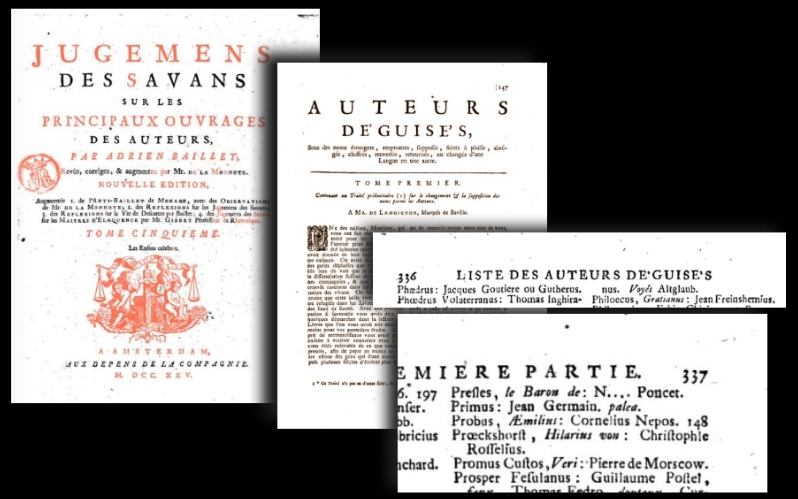

2 Mag 2018
A mysterious quote from «Bishop Primus Cambilunensis» unveiled - 3. The Sibyl looms through the words written by Francesco Maurolico
Francesco Maurolico, a man of the late Renaissance, a benedictine abbot, one of the most learned scholars in Messina during the first half of the sixteenth century. Many of his works have never been published and are now lost to us; many others have reached our present times, including scientific essays like the “Opuscula Mathematica”, historical chronicles such as the “Sicanicarum Rerum Compendium”, and religious works as the “Topographia Sanctorum Christi Martyrum”, contained in his “Martyrologium”.
It is in the “Topographia” that we find a number of mentions concerning the Sibyl of Norcia: three different references which cast a new, unprecedented light upon the sibilline oracle that, according to the legend, resides beneath the peak of Mount Sibyl, in central Italy.
In this article, for the first time ever, we publish the three mentions of the Sibyl of Norcia written by Francesco Maurolico in 1568.
A first mention is provided by Maurolico at the very beginning of his alphabetical list of places which are relevant to martyrs. Here is what he notes down under letter 'A':
«Ameria, an Italian town set in the Sabine region. From this town the author names the 'Emerian Sibyl', who others call the 'Cimeriam' owing to the uncertainty of the place; she lives in the caverns of Norcia, and it is different from both the Cumaean and the Tiburtine Sibyls».
[In the original Latin text: «Ameria civitas Italiae in Sabinis. Hinc denominat author Sybillam Emeriam, quam alii Cimeriam vocant ab oscuritate loci, et in Nurcinis antris habitantem, atque a Cumana, et a Tyburtina diversam»].
The above excerpt is quite puzzling: Maurolico refers to a Sibyl who lives «in the caverns of Norcia», but he also mentions another Italian town, Amelia (whose Latin name is 'Ameria'). Though the latter is not far from Norcia and lies in the same ancient region of Sabine, Amelia, a town which still stands, is set in a different geographical area, separated from Norcia by a number of mountainous ridges, and definitely it has nothing to do with the Sibillini Mountain Range.
A second notable trait comes in sight either: Francesco Maurolico calls the Sibyl of Norcia 'Emeriam' or 'Cimeriam': a Sibyl that appears in some versions of the most classical enumeration of Sibyls provided by Lucius Caecilius Firmianus Lactantius, a fourth-century author. Does Maurolico maintain that the Apennine Sibyl actually belongs to the list of ten classical Sibyl known from antiquity?
But Maurolico does not restrict himself to a single mention. Under letter 'N' in his “Topographia”, we find another mention. And, this time, 'N' is for 'Norcia':
«Norcia, a town of the Italian region of Picenum; close to it is the Cavern of the Cimeriam Sibyl, and the lake of Demons».
[In the original Latin text: «Nurcia civitas Italiae in agro Piceno, iuxta quam est Antrum Sibyllae Cymeriae, et lacus Daemonum»].
Again, Maurolico stresses the point that the name of the Sibyl of Norcia is 'Cimeriam': once more, a direct reference to the classical list of ten Sibyls.
That was the second mention. However, there is a third too. At all appearances, the Sicilian abbot had a special interest in Sibyls, as later in his “Topographia” he introduces a specific section specifically dedicated to the sibilline oracles, «On Sibyls and other authors» [in the original Latin text: «De Sibyllis, et variis Authoribus»]. In this section, Maurolico provides quotes from a number of classical authors who wrote about the Sibyls. When it comes to Lactantius, he enumerates the ten Sibyls included in the renowned classical list. The fourth in the list is the one we are interested in:
«The fourth Sibyl is the Cumaeam, whom Naevius mentions in his books about the Punic war, and Piso in his annals as well», says Maurolico, reporting the same words that are actually found in most versions of fourth-century Lactantius' “De divinis institutionibus”.
However, the learned Sicilian abbot adds further words, which are not present in Lactantius' original excerpt:
«... from the Cimeriam castle, also known as the Cave of Norcia, which some call by the corrupted name of 'Cymea' or 'Cymica'».
[In the original Latin text: «ex Cimerio oppido, sive Antro nurcino, quae corrupto forte verbo Cymea, vel Cymica vocetur a nonnullis»].
Ameria, Emeriam, Cimeriam, Cymeriam, Cymea, Cymica, Cumaeam: a plethora of different qualifiers, which - according to Francesco Maurolico - would all point to a same oracle: the Sibyl of Norcia, which is not the one from Cumae (for Lactantius, and Maurolico as well, the latter is listed as the seventh Sibyl, with the Latin qualifiers «Cumanam» and also «Amaltheam»).
Now uncertainty has reached its utmost level. Where did Maurolico take all those words from? Did he really quote, as he explicitly declares, from a certain «Primus Cabilunensis, bishop and theologist» and his work allegedly written in 1450? Who is the Cimeriam Sibyl? And has she really anything to do with our Sibyl of the Apennines, as alleged by Maurolico?
We will try to provide an answer to all such questions in the next article, when we will find out the true identity of «Primus Cabilunensis», and we will read directly from the pages of his books.
Does Primus also provide mentions about the Sibyl of Norcia? Or, did Maurolico just «complemented» Primus' book by inserting his own words concerning our Sibyl?
Stay with us, because we will check it out.
Una misteriosa citazione da «Primo Cambilunense Vescovo» svelata - 3. La Sibilla si manifesta attraverso le parole vergate da Francesco Maurolico
Francesco Maurolico, un uomo del tardo rinascimento, un abate benedettino, un letterato di grande erudizione, attivo nella città di Messina nel corso della prima metà del sedicesimo secolo. Molte delle sue opere non sono mai state pubblicate, e sono così andate perdute; molte altre hanno invece raggiunto la nostra epoca, come ad esempio saggi scientifici quali gli "Opuscula Mathematica", volumi storici come il "Sicanicarum Rerum Compendium", e opere di argomento religioso come la “Topographia Sanctorum Christi Martyrum”, contenuta nel suo “Martyrologium”.
È proprio nella “Topographia” che ci imbattiamo in una serie di menzioni concernenti la Sibilla di Norcia: tre differenti citazioni che gettano una nuova, inedita luce sull'oracolo sibillino che, secondo la leggenda, dimorerebbe al di sotto del picco del Monte Sibilla, nell'Italia centrale.
In questo articolo, per la prima volta, pubblichiamo le tre menzioni relative alla Sibilla di Norcia scritte da Francesco Maurolico nel 1568.
Una prima menzione ci viene fornita da Maurolico proprio all'inizio della sua elencazione, in ordine alfabetico, di luoghi considerati rilevanti in relazione ai santi martiri. Ecco cosa egli scrive nell'ambito della lista catalogata sotto la lettera 'A':
«Ameria, città dell'Italia posta nella regione Sabina. Da questa città l'autore denomina la 'Sibilla Emeria', che altri chiamano 'Cimeria' a causa dell'incertezza sul luogo; essa vive nell'antro di Norcia, ed è diversa sia dalla Cumana che dalla Tiburtina».
[Nel testo originale latino: «Ameria civitas Italiae in Sabinis. Hinc denominat author Sybillam Emeriam, quam alii Cimeriam vocant ab oscuritate loci, et in Nurcinis antris habitantem, atque a Cumana, et a Tyburtina diversam»].
Questo brano non può non lasciare lo studioso alquanto perplesso: Maurolico sta facendo riferimento a una Sibilla che abita «nelle caverne di Norcia», ma pare menzionare anche un'altra città italica, Amelia (il cui nome latino è 'Ameria'). Benché quest'ultimo borgo, ancora oggi esistente, non sia così distante da Norcia e si trovi nella medesima antica regione della Sabina, Amelia è localizzata in una differente area geografica, separata da Norcia da vari rilievi montuosi, e di certo non ha nulla a che vedere con i Monti Sibillini.
Inoltre, è possibile evidenziare un secondo aspetto notevole: Francesco Maurolico denomina la Sibilla di Norcia come 'Emeria' o 'Cimeria': una Sibilla che appare in alcune versioni della più famosa enumerazione classica di Sibille, quella tramandataci da Lucio Cecilio Firmiano Lattanzio, un autore del quarto secolo. Forse Maurolico intende sostenere l'ipotesi che la Sibilla Appenninica appartenga alla lista delle dieci Sibille note sin dall'antichità?
In ogni caso, Maurolico non si limita ad una sola citazione. Nella sua "Topographia", sotto la lettera 'N', troviamo infatti un altro riferimento. E, questa volta, 'N' sta per 'Norcia':
«Norcia, una città d'Italia nella regione del Piceno, vicino alla quale si trova l'Antro della Sibilla Cimeria, e il lago dei Dèmoni».
[Nel testo originale latino: «Nurcia civitas Italiae in agro Piceno, iuxta quam est Antrum Sibyllae Cymeriae, et lacus Daemonum»].
Ancora una volta, Maurolico rimarca come il nome della Sibilla di Norcia sia 'Cimeria': ancora una volta, si tratta un riferimento diretto alla lista delle dieci Sibille classiche.
E questa era la seconda menzione. Ma non è finita, perché ve ne è anche una terza. In tutta evidenza, l'abate siciliano nutriva uno speciale interesse per le Sibille, perché più oltre, nella sua "Topographia", egli inserisce addirittura una specifica sezione dedicata agli oracoli sibillini, «Sulle Sibille, e altri autori» [nel testo originale latino: «De Sibyllis, et variis Authoribus»]. In questa sezione, Maurolico fornisce citazioni tratte da vari autori classici che scrissero a proposito delle Sibille. Nel riferire di Lattanzio, egli ci ripropone la lista delle dieci Sibille contenute nell'elenco classico. La quarta nella lista è quella di nostro particolare interesse:
«La quarta Sibilla è la Cumea, di cui parla Nevio nei suoi libri dedicati alla Guerra Punica, a anche Pisone nei suoi annali», ci informa Maurolico, riportando le parole che sono effettivamente reperibili in molte versioni dell'opera di Lattanzio “De divinis institutionibus”, risalente al quarto secolo.
Ma l'erudito abate siciliano aggiunge poi ulteriori parole, che non sono presenti nel brano originale di Lattanzio:
«... dal castello Cimerio, conosciuto anche con il nome di Antro nursino, che alcuni chiamano con il nome corrotto di 'Cymea' o 'Cymica'».
[Nel testo originale latino: «ex Cimerio oppido, sive Antro nurcino, quae corrupto forte verbo Cymea, vel Cymica vocetur a nonnullis»].
Ameria, Emeria, Cimeria, Cymeria, Cymea, Cymica, Cumaea: una moltitudine di nomi differenti che - secondo Francesco Maurolico - punterebbero tutti al medesimo oracolo: la Sibilla di Norcia, che non sarebbe da identificarsi con quella di Cuma (per Lattanzio, come anche per Maurolico, quest'ultima è elencata come la settima Sibilla, con le qualificazioni latine di «Cumanam» e anche «Amaltheam»).
A questo punto, l'incertezza regna in sommo grado. Da dove trasse, il Maurolico, quelle parole? Sta realmente riportando, come egli stesso dichiara esplicitamente, frasi estratte da un certo «Primo Cabilunense, vescovo e teologo» e dal suo testo asseritamente scritto nel 1450? Chi era la Sibilla Cimeria? E ha essa qualcosa a che fare con la nostra Sibilla degli Appennini, come affermato da Maurolico?
Proveremo a trovare una risposta a tutte queste domande nel prossimo articolo, nel quale scopriremo la vera identità di «Primo Cabilunense», e andremo a leggere direttamente dalle pagine del suo libro.
Ci parlerà, Primo, della Sibilla di Norcia? Oppure, scopriremo che Maurolico ha «integrato» il libro di Primo inserendo parole di propria mano a proposito della nostra Sibilla?
Restate con noi, perché stiamo per andare a scoprirlo.
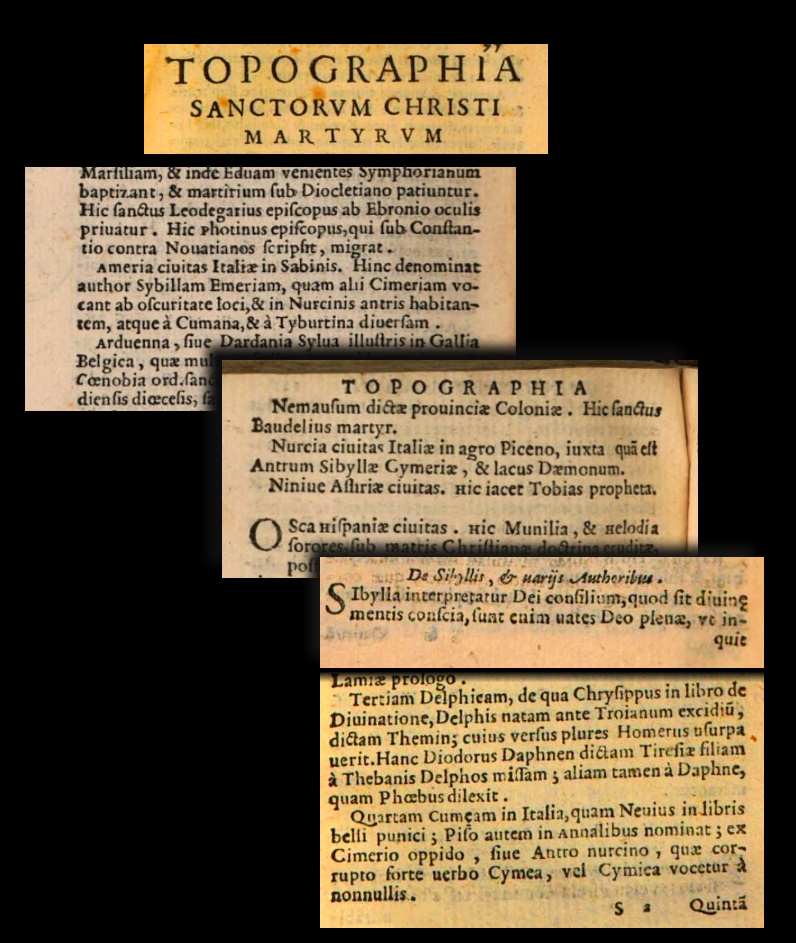

23 Apr 2018
A mysterious quote from «Bishop Primus Cambilunensis» unveiled - 2. A sixteenth-century “Topographia Martyrum” from Sicily (with the Sibyl of Norcia included)
In 1650 Father Fortunato Ciucci reported that in an essay written by a certain «Primus Cambilunensis» the Sibyl of Norcia was mentioned as living in a gloomy cave in the Sibillini Mountain Range.
But who was «Primus Cambilunensis», and where can we trace his book?
If we look for an author named 'Primus' in the European literature of the seventeenth century, or of earlier centuries, we find that we cannot pinpoint a specific writer who bears this name. To restrict our search, a helpful indication may come from the word «Cambilunensis», a geographical qualifier which indicates the ancient French town of Chalon-sur-Saône, attested as 'Cavillonum' or 'Cabillonum' in Julius Ceasar's “Gallic War”.
Accoding to Father Ciucci, «Primus Cambilunensis» was a bishop and author of theological essays, so we may try and address the list of bishops that have held the post in Chalon-sur-Saône from early Middle Ages to year 1650, when the monk from Norcia noted down his quote. However, this list, known from the works by other scholars, is quite long: restraining ourselves to the eleventh century and onwards, it starts from a certain Lambert in year 1017 and continues with Geoffroy, Hugues, Guy, Aicard and many others, up to Cyrus de Thiard de Bissy and Jacques de Neuchèze in the first half of the seventeenth century, the age of Father Ciucci. None of such bishops is named 'Primus' and none of them appears to have ever written any essay on martyrs, as stated by Ciucci.
So we got stuck in a sort of dead end. The list of Chalon-sur-Saône's bishops offers us no hints. Our hunt seems to end up in a small town of Eastern France, and the words written in Norcia by Father Fortunato Ciucci in 1650 appear to be doomed to a sad destiny of unsubstantiality and oblivion.
Yet a very remarkable clue comes to our aid.
Someone, at some point in history, did actually write and publish an essay on martyrs and the places where their martyrdoms happened: a 'Topography of Martyrs', exactly what Ciucci seems to have drawn is quote from.
We have to leave France, at least for the time being, and turn to sixteenth-century Italy. In the town of Messina, lying on the easternmost tip of Sicily right in front of the renowned strait, once lived a famous historian, astronomer and mathematician, a benedictine abbot who was known in Europe as a learned scholar: Francesco Maurolico.
A man of great erudition, he was the author of a “Martyrologium”, a work providing information on saints and martyrs of the Catholic Church for each day of the year, a sort of handbook for priests celebrating the Mass. However, our interest is not in this part of his book.
Maurolico's “Martyrologium”, published in Venice in 1568, contains an addendum which is fully relevant to our search. In fact, in the final section of his work Maurolico includes a specific list of places: an inventory of sites, towns and regions, starting from Antiochia in Syria and ending up with Urci, today's Almeria in Spain, and also containing additional sites pertaining to apostles, prophets and other characters from the Holy Bible.
The title of this section is “Topographia Sanctorum Christi Martyrum”: exactly the “Topography of the holy martyrs” mentioned by Father Fortunato Ciucci in his “Chronicles of the Antique Town of Norsia” a century later.
And this is not all. It is Francesco Maurolico himself who adds a subheading to that title: he states that his “Topographia” is drawn from «Primus Cabilunensis, bishop and theologist, once composed in the Year of Salvation 1450 and now at last complemented» [in the original Latin text: «per Primum Cabilunensem, episcopum, ac theologum, Anno salutis MCCCCL olim composita Et nunc demum recognita»].
Here we are. We have possibly found the original source from which Father Fortunato Ciucci, a benedictine monk active in Norcia around 1650, extracted his words about the Sibyl and her cave.
We will see that our surmise is absolutely correct. Because Francesco Maurolico, who says he is reporting words from an earlier author named Primus, provides the same sentences subsequently reported by Ciucci.
And our finding is even richer than that: “The Apennine Sibyl - A Mystery and a Legend” is proud to convey to the attention of contemporary scholars the additional, previously-unknown sentences that Maurolico wrote about the Sibyl. Actually, there is more than one. As we will see in the next article.
Una misteriosa citazione da «Primo Cambilunense Vescovo» svelata - 2. Una “Topographia Martyrum” seicentesca dalla Sicilia (con inclusa la Sibilla di Norcia)
Nel 1650 Padre Fortunato Ciucci riferisce che, all'interno di un saggio redatto precedentemente da un certo «Primo Cambilunense», appare una menzione concernente la Sibilla di Norcia, la quale abiterebbe una tenebrosa caverna nel massiccio dei Monti Sibillini.
Ma chi era «Primo Cambilunense»? È possibile rintracciare, in qualche modo, il saggio da lui scritto?
Se andiamo in cerca di un autore il cui nome possa essere 'Primo', nell'ambito della letteratura europea del diciassettesimo secolo, o dei secoli precedenti, scopriamo di non essere in grado di identificare uno specifico letterato che porti questo nome. Per circoscrivere la nostra ricerca, un'utile indicazione parrebbe provenire dalla parola «Cambilunense», una qualificazione geografica che identifica l'antica città francese di Chalon-sur-Saône, attestata nella forma 'Cavillonum' o 'Cabillonum' nei "Commentarii de bello gallico" di Giulio Cesare.
Secondo Padre Ciucci, «Primo Cambilunense» fu vescovo e autore di opere di argomento teologico, e dunque è possibile per noi tentare di consultare la lista di vescovi che hanno occupato questa carica ecclesiale a Chalon-sur-Saône, a partire dall'alto Medioevo e fino all'anno 1650, quando il monaco nursino annota quella citazione. Purtoppo, però, questa lista, nota grazie al lavoro di altri studiosi, risulta essere particolarmente lunga: limitandoci alla porzione che va dall'anno 1000 in poi, si comincia con un certo Lambert nel 1017 e si continua con Geoffroy, Hugues, Guy, Aicard e molti altri, fino ad arrivare a Cyrus de Thiard de Bissy e Jacques de Neuchèze, in carica durante la prima metà del diciassettesimo secolo, l'epoca di Padre Ciucci. Nessuno di questi vescovi porta il nome di 'Primo', e nessuno di essi sembra avere scritto alcunché a proposito di martiri, come invece segnalatoci dal Ciucci.
E così, ci troviamo alla fine bloccati in una sorta di vicolo cieco. La lista dei vescovi di Chalon-sur-Saône non ci offre alcuna traccia utile. La nostra ricerca pare dunque arrestarsi innanzi ad una piccola città della Francia orientale, e le parole scritte a Norcia da Padre Fortunato Ciucci nel 1650 sembrano essere condannate a subire un malinconico destino di inconsistenza e oblio.
Ma un indizio estremamente significativo giunge in nostro soccorso.
Qualcuno, in un preciso momento della Storia, effettivamente scrive e pubblica un saggio sui martiri e sui luoghi presso i quali i loro martirio è avvenuto: una 'Topografia dei Martiri', esattamente ciò da cui Ciucci pare avere tratto la propria citazione.
Dobbiamo abbandonare, seppure temporaneamente, la Francia e rivolgerci all'Italia del sedicesimo secolo. Nella città di Messina, posta sulla punta più orientale della Sicilia, proprio di fronte al famosissimo stretto, viveva un tempo un illustre storico, astronomo e matematico, un abate benedettino che era noto in Europa per la sua profonda erudizione: Francesco Maurolico.
Uomo di vasta cultura, egli fu l'autore di un "Martyrologium", un'opera nella quale si fornivano informazioni in merito a santi e martiri della Chiesa Cattolica per ogni giorno dell'anno, una sorta di manuale per sacerdoti impegnati nella celebrazione della Messa. Ma il nostro interesse, certamente, non è rivolto a questa parte del suo libro.
Il "Martyrologium" di Maurolico, pubblicato a Venezia nel 1568, contiene una sezione aggiuntiva, di fondamentale momento per la nostra ricerca. Infatti, nella parte finale della sua opera, Maurolico inserisce una peculiare elencazione di luoghi: un catalogo di siti, città e regioni, che parte da Antiochia in Siria e termina con Urci, l'odierna Almeria in Spagna, e contiene inoltre ulteriori luoghi significativi concernenti gli apostoli, i profeti e altri personaggi che compaiono nella Bibbia.
Il titolo di questa sezione è “Topographia Sanctorum Christi Martyrum”: esattamente quella "Topografia de' santi martiri" menzionata da Padre Fortunato Ciucci, un secolo più tardi, nelle proprie "Historie dell'antica città di Norsia".
E questo non è tutto. È lo stesso Francesco Maurolico ad aggiungere un sottotitolo di grandissimo interesse: egli dichiara infatti che la sua "Topographia" è tratta da «Primo Cabilunense, vescovo e teologo, un tempo composta nell'Anno della Salveza 1450 e ora finalmente integrata» [nel testo originale latino: «per Primum Cabilunensem, episcopum, ac theologum, Anno salutis MCCCCL olim composita Et nunc demum recognita»].
Ed eccoci arrivati. Abbiamo forse trovato la fonte originale dalla quale Padre Fortunato Ciucci, monaco benedettino attivo a Norcia intorno al 1650, trasse quelle parole a proposito della Sibilla e della sua grotta.
Vedremo che la nostra ipotesi è assolutamente corretta. Perché Francesco Maurolico, il quale afferma di riferire quanto scritto da un precedente autore di nome Primo, ci fornisce esattamente le stesse parole già a noi note tramite il Ciucci.
E la nostra scoperta è addirittura ancora più ricca: "Sibilla Appenninica - Il Mistero e la Leggenda" è infatti lieta di sottoporre all'attenzione dei moderni studiosi le ulteriori frasi, in precedenza sconosciute, che Maurolico scrisse a proposito della Sibilla. In effetti, nella sua "Topographia" ve ne sono diverse. Come avremo modo di vedere nel prossimo articolo.
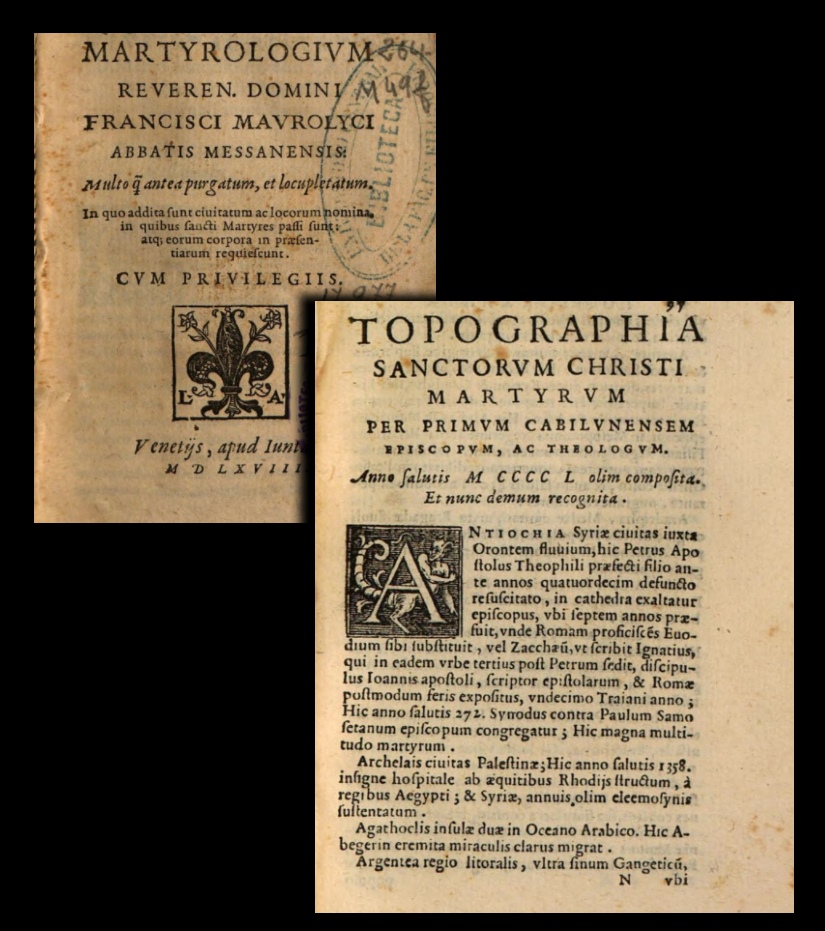

21 Apr 2018
A mysterious quote from «Bishop Primus Cambilunensis» unveiled - 1. Fortunato Ciucci and his words on the Cave of Norcia
The legend of an Apennine Sibyl residing beneath a remote peak in central Italy has journeyed across many European countries, spanning more than six centuries and emerging in unexpected ways in the works of dozens of authors speaking different languages.
One of the most cryptic quotes on the Sibyl of the Apennines which scholars have dealt with is found in an historical essay written in year 1650 by Father Fortunato Ciucci, a monk who lived in Norcia, the town which is set in the vicinity of Mount Sibyl. In his “Chronicles of the Antique Town of Norsia”, Father Ciucci reports the following sentence:
«Not far from the said Lakes [of Mount Vettore], on the southern side of the same mountain, a frightful Cavern is present, in which since time immemorial [...] a false Sibyl has her abode, whom Primus Cambilunensis, a Bishop and Theologist of the Topography of the holy martyrs, maintains she is the Emerian, also known as Cimmerian, a different Sibyl from the Cumaean and the Tiburtine, with the following words: 'The Emerian Sibyl, who some call Cimmerian owing to the gloominess of her abode, and who resides in the Cave of Norcia, not the same Sibyl as the Cumaean and the Tiburtine'».
[In the original Italian text: «Non molto lontano dai detti Laghi [del Monte Vettore] verso il Mezzogiorno nell'Istesso Monte Vittore s'apre un'orrenda Spelonca, dove da un lungo rivolgimento di tempo [...] abita una mensogniera Sibilla, la quale dice Primo Cambilunense Vescovo e Teologo della Topografia de' santi martiri che sia l'Emeria chiamata Cimeria, diversa dalla Cumea, e Tiburtina, con queste parole: 'Sybillam Emericam quam alij Cimeriam vocant ab oscuritate loci, et in Nursinis Antris habitantem, atque a Cumea, et a Tiburtina diversam»].
A number of questions arise when confronting with Father Ciucci's antique excerpt: who was «Primus Cambilunensis», bishop and theologist? What sort of 'Topography' about martyrs is the book Father Ciucci is quoting from? Who is the 'Cimmerian Sibyl' and why that Sibyl would be connected to the Sibyl of the Apennines?
For centuries, this mysterious, enigmatic reference to the Sibyl of Norcia has rested unfathomed before the puzzled eyes of scholars, in the absence of a clue as to where to turn in order to find the original source of Ciucci's quote.
Today, “The Apennine Sibyl - A Mystery and a Legend” is proud to bring all the interlocking pieces of this astounding literary puzzle together. Like in a most classical treasure hunt, we will analyze each clue available to us, searching into history and literature, so that in the end we will be fully able to reassemble the whole picture and confer an identity and an epoch to Primus Cambilunensis: another element of the amazing portrait of the Apennine Sibyl that has been painted from many different hands across many centuries throughout the lands of Europe.
Follow me into this thrilling journey across old books and ancient manuscripts, a travel through a legend that never stops dispensing new surprises.
Una misteriosa citazione da «Primo Cambilunense Vescovo» svelata - 1. Fortunato Ciucci e le sue parole sulla Grotta di Norcia
La leggenda relativa a una Sibilla Appenninica che avrebbe dimorato all'interno di un picco elevantesi nell'Italia centrale ha percorso molte nazioni d'Europa, attraverso più di sei secoli, emergendo in modi spesso inattesi all'interno delle opere di decine e decine di autori che hanno parlato e scritto in lingue differenti.
In relazione alla Sibilla degli Appennini, una delle citazioni più enigmatiche con la quale gli studiosi della leggenda sibillina hanno avuto l'opportunità di confrontarsi è quella reperibile in un saggio storico redatto nell'anno 1650 da Padre Fortunato Ciucci, un monaco vissuto a Norcia, la città posta nelle vicinanze del Monte Sibilla. Nelle sue "Historie dell'antica città di Norsia", Padre Ciucci riporta le seguenti parole:
«Non molto lontano dai detti Laghi [del Monte Vettore] verso il Mezzogiorno nell'Istesso Monte Vittore s'apre un'orrenda Spelonca, dove da un lungo rivolgimento di tempo [...] abita una mensogniera Sibilla, la quale dice Primo Cambilunense Vescovo e Teologo della Topografia de' santi martiri che sia l'Emeria chiamata Cimeria, diversa dalla Cumea, e Tiburtina, con queste parole: 'Sybillam Emericam quam alij Cimeriam vocant ab oscuritate loci, et in Nursinis Antris habitantem, atque a Cumea, et a Tiburtina diversam'».
Nel prendere in considerazione l'antica citazione di Padre Ciucci, sorgono dunque una serie di domande: chi era «Primo Cambilunense», vescovo e teologo? Da quale 'Topografia' concernente i santi martiri sta traendo, il Ciucci, il brano citato? Chi è la 'Sibilla Cimmeria' e perché questa Sibilla sarebbe collegata alla Sibilla degli Appennini?
Per secoli, questo misterioso, enigmatico riferimento alla Sibilla di Norcia si è stagliato in modo impenetrabile di fronte allo sguardo perplesso degli studiosi, nell'assenza di indizi che potessero indicare la direzione verso la quale volgersi per rintracciare la fonte originale della citazione di Ciucci.
Oggi, "Sibilla Appenninica - Il Mistero e la Leggenda" è orgogliosa di ricomporre tutti i pezzi interconnessi relativi a questo incredibile rompicapo letterario. Come nella più classica delle cacce al tesoro, analizzeremo ogni indizio a noi disponibile, investigando tra storia e letteratura, in modo tale che, al termine della nostra ricerca, saremo in grado di ricostruire un'immagine completa, conferendo un'identità e un'epoca a Primo Cambilunense: un nuovo elemento dello stupefacente ritratto della Sibilla Appenninica dipinto da molte mani differenti lungo vari secoli nelle varie lande d'Europa.
Seguitemi in questo emozionante viaggio attraverso libri polverosi e antichi manoscritti, un viaggio riguardante una leggenda che non cessa mai di dispensare nuove sorprese.
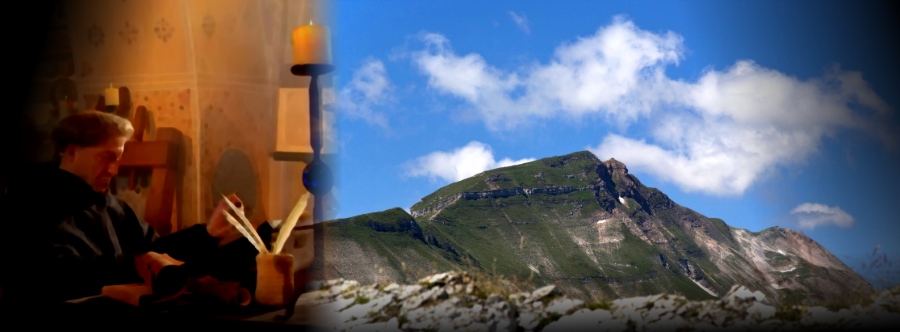

27 Set 2017
In the name of the Sibillini /2: the Sibyl's Mountains
We don't know why, we don't know when, yet at a certain point in time across the centuries the “Tetrica rupes” (the name of the Sibillini Range in antiquity) seems to turn into something different: the whole mountainous fastness becomes “The Sibyl's Mountains”.
In Chapter 137 of the fifteenth-century romance “Guerrino the Wretch”, the hero is told that the Sibyl «was to be found amid the mountains of the Apennine in the middle of Italy high up a town called Norza, some say it is called Norsia» («li iera in li monti de pinino i[n] lo mezo de Italia sopra una cità chiamata Norza, alcuni dicono como la è chiamata Norsia»); only a few lines ahead, Guerrino asks people «on where is located the Sibyl's mount» («dove era il monte de la Sibilla»). Antoine de La Sale, at the very beginning of his “The Paradise of Queen Sibyl”, reports of a «mount of Queen Sibyl's lake» («mont du lac de la royne Sibille» - today's Mount Vettore) and a «mount of Queen Sibyl» («mont de la royne Sibille»), facing the former.
So, in the fifteenth century no reference to a “Mount Tetricus” can be traced anymore: the Sibillini Range, a portion of the Italian Apennines, is already identified as a mount or group of mounts related to a Sibyl. In addition, no reference to the peak we know today as Mount Vettore can be found at this late Medieval age.
If we jump further ahead in time, we find another clue dating back to 1566: it's the astounding map contained in Vatican manuscript n. 5241, where the whole mountainous massif is referred to with the following sentence: «this mount is called the 'chiavetoie' (Vettore?), also known as The Mountain of the Sibyl» («questa montagna dicono de chiavetoie, altramente La montagna della Sibilla»). Again, no “Tetrica rupes” is present anymore: the drawing shows a mountain range named “of the Sibyl” as a whole; and a first, early reference to something that might be our modern Mount Vettore is now present.
In the subsequent century, Father Fortunato Ciucci, a monk residing in Norcia, concentrates his attention on Mount Vettore. In his “Chronicles of the antique town of Norsia”, written in 1650, he clearly mentioned the «great Mount Vettore [...] its name is Victor owing to his being the greatest, and the best as to magnificence and other qualities» (il «gran Monte Vittore [...] si chiama Vittore per essere di tutti il maggiore, così egli l'istessa qualità ritiene in bellezza ed altre prerogative»). He does not mention a specific mount for the Sibyl, as he rather says that «on the very same Mount Vettore a ghastly Cavern opens its mouth where [...] a mendacious Sibyl has her abode» («nell'Istesso Monte Vittore s'apre un'orrenda Spelonca dove [...] abita una mensogniera Sibilla»).
Nonetheless, in the sixteenth and seventeenth centuries all the maps of the region show an isolated Mount Sibyl only, with no reference to a Mount Vettore nearby, nor to any larger massif surrounding the renowned peak.
To come full circle, we must get as far as year 1869, when a local scholar, Feliciano Patrizi-Forti, writes his “On the Historical Essays about Norcia”. And here is what he states at page one of his seven-hundred-page work:
«The Apennine massif at whose base Norcia was founded is called 'Mount Sibyl', or 'Mons Tetricus' in antiquity» («Il gruppo appenninico alle falde del quale fu Norcia fondata, è detto 'Monte della Sibilla', anticamente 'Mons Tetricus'»).
In a single sentence, we find the whole transmutation path from the “Tetrica rupes” of the Romans to our modern “Sibillini Range”.
Somewhere along the way, a Sibyl has magically appeared, giving her legendary name to a whole Italian mountainous region: an amazing occurrence that still needs to undergo further investigation and research.
Nel nome dei Sibillini: le Montagne della Sibilla
Non sappiamo né quando, né perché; eppure, ad un certo punto nel corso del volgere dei secoli, la "Tetrica rupes" (il nome dei Monti Sibillini nell'antichità) sembra trasformarsi in qualcosa di differente: l'intero massiccio montuoso diviene "le Montagne della Sibilla".
Nel Capitolo 137 del romanzo quattrocentesco "Guerrin Meschino", al protagonista viene raccontato che la Sibilla «li iera in li monti de pinino i[n] lo mezo de Italia sopra una cità chiamata Norza»; e, poche righe più sotto, Guerrino cerca di raccogliere informazioni su «dove era il monte de la Sibilla». Antoine de La Sale, proprio all'inizio del suo "Il paradiso della Regina Sibilla" riferisce di un «mont du lac de la royne Sibille» (l'odierno Monte Vettore) e di un «mont de la royne Sibille», posto proprio di fronte al primo.
Dunque, nel quindicesimo secolo non è più possibile rintracciare alcuna menzione a proposito di un "Monte Tetrico": il massiccio dei Monti Sibillini, una porzione degli Appennini in terra d'Italia, risulta già essere indicato come una montagna o un gruppo di montagne connesse ad una Sibilla. Inoltre, nessun riferimento al picco oggi conosciuto come Monte Vettore sembra essere reperibile nel volgere di questa tarda età medievale.
Se saltiamo ancora più avanti nel tempo, ci imbattiamo in un ulteriore indizio risalente al 1566: si tratta dell'incredibile mappa contenuta nel manoscritto vaticano n. 5241, dove l'intero massiccio montuoso viene identificato con la seguente frase: «questa montagna dicono de chiavetoie (Vettore?), altramente La montagna della Sibilla». Di nuovo, nessuna "Tetrica rupes" è più presente: il disegno mostra invece un gruppo montuoso denominato nel suo complesso «la montagna della Sibilla», nonché un primo, embrionale riferimento a ciò che noi, oggi, conosciamo come Monte Vettore.
Nel secolo successivo, Padre Fortunato Ciucci, un monaco nursino, concentra la propria attenzione sul Monte Vettore. Nelle sue "Historie dell'antica città di Norsia", scritte nel 1650, egli cita apertamente il «gran Monte Vittore [...] si chiama Vittore per essere di tutti il maggiore, così egli l'istessa qualità ritiene in bellezza ed altre prerogative». Padre Ciucci non menziona alcuna specifica montagna relativa alla Sibilla, limitandosi ad affermare che «nell'Istesso Monte Vittore s'apre un'orrenda Spelonca dove [...] abita una mensogniera Sibilla».
In ogni caso, in tutte le mappe del sedicesimo e diciassettesimo secolo relative a questi territori viene sempre mostrato un isolato Monte della Sibila, senza alcun riferimento ad un adiacente Monte Vettore, né ad alcun massiccio di più vaste dimensioni nelle vicinanze del famoso picco sibillino.
Per chiudere il cerchio, sarà necessario arrivare fino al 1869, quando un erudito locale, Feliciano Patrizi-Forti, pubblicherà il suo "Delle memorie storiche di Norcia". Ed ecco cosa egli scriverà nella pagina iniziale della propria opera da settecento pagine:
«Il gruppo appenninico alle falde del quale fu Norcia fondata, è detto 'Monte della Sibilla', anticamente 'Mons Tetricus'».
In una singola frase, troviamo riassunto l'intero percorso di trasmutazione dalla "Tetrica rupes" degli antichi romani fino ai nostri moderni "Monti Sibillini".
Da qualche parte lungo la strada del tempo, una Sibilla è apparsa magicamente, donando il proprio nome leggendario ad un'intera regione montuosa d'Italia: un evento stupefacente, che necessita certamente di ulteriori studi ed investigazioni.


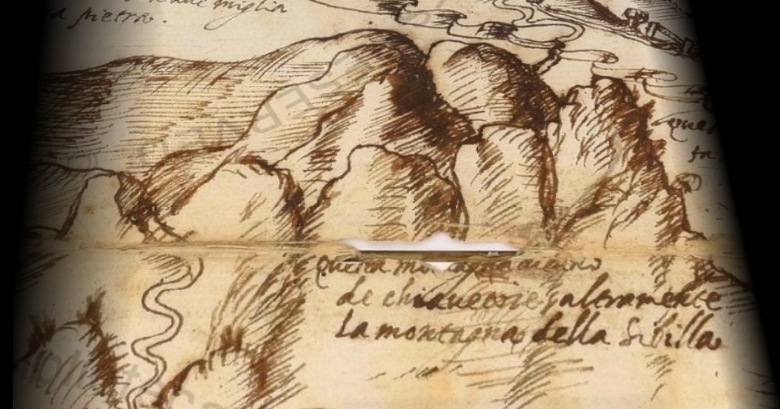

25 Set 2017
In the name of the Sibillini: the "Tetrica rupes"
Today, 'Sibillini Mountain Range' in Italy is a well-known name, describing a territory where the magnificence of nature harbours a number of mysterious legends. But what was the name of the Sibillini in ancient times?
Romans used to call the region “gloomy, frightful mountain” ('Tetrica rupes' in Latin), as mentioned by Vergilius in Book VII of his poem “Aeneid”, when describing the Italian troops that were being sent against Aeneas:
«Ecce Sabinorum prisco de sanguine magnum Agmen
[...] postquam in partem data Roma Sabinis
[...] qui Tetricae horrentis rupes
[...] quos frigida misit Nursia»
(«Here comes the great Army of the ancient lineage of the Sabines [...] after Sabines were given a part of Rome [...] those who live at the dreadful Tetricus cliff [...] and those who come from cold, wintry Norcia»)
Servius Marius Honoratus, a fifth century scholar, provides his own comment to the above line by Vergilius ('Commentarii in Vergilii Aeneidos libros', Book VII), by specifying that «the Tetricus mountain is a barren, towering mountain, where stern men are said 'tetricos', sullen and gloomy».
«Tetricus mons in Sabinis asperrimus, unde tristes homines tetricos dicimus»
And Isidore of Seville, in Book X of his “Etymologiarum sive Originum” (sixth century A.D.), adds to Servius' text the following additional remark on the men living at the Tetricus: «inclined to silence, persistently taciturn» («Taciturnus, in tacendo diuturnus»).
The same name 'Tetricus' for the Sibillini Range is also mentioned by Silius Italicus, a Roman consul and poet who lived in the first century A.D. In his work “Punica” (Book VIII), he lists the Italian warriors summoned by the Romans to confront Hannibal at the Battle of Cannae (216 B.C.):
«Hunc Foruli magnaeque Reate dicatum
Caelicolum Matri necnon habitata pruinis
Nursia et a Tetrica comitantur rupe cohortes»
(«With him come the soldiers of [...] Reate sacred to the great Mother of the Gods, and Nursia the abode of snow, and warriors from the Tetricus cliff»).
Furthermore, Marcus Terentius Varro, in Book II of his “De re rustica” (first century B.C.), writes that «even now there are several species of wild cattle in various places. [...] For there are many wild goats in Italy in the vicinity of Mount Fiscellum and Mount Tetrica» («Etiam nunc in locis multis genere pecudum ferarum sunt aliquot. [...] Sunt enim in Italia circum Fiscellum et Tetricam montes multae»).
But what does Varro mean by 'Mount Fiscellum'? The answer is in Pliny the Elder, who in his “Naturalis Historia” (Book III) states that «Velinos accolunt lacus [...] Nar amnis exhaurit illos sulpureis aquis Tiberim ex his petens, replet e monte Fiscello Avens iuxta Vacunae nemora et Reate in eosdem conditus» («in the vicinity of the Lakes of the Velinus [...] the Nar, with its sulphureous waters, exhausts these lakes running towards the Tiber; the river Avens flows from Mount Fiscellus near the groves of Vacuna and Rieti»).
So Pliny, in the above excerpt - which is most probably corrupt - seems to confuse the River Nera (which actually originates in the Sibillini Range) with the River Velino ('Avens'), flowing in and out the Lake of Piediluco, and whose source is found in the area of Mount Terminillo, together with a number of sulphurous springs. Thus the 'Fiscellus Mons' should be better identified with Mount Terminillo.
'Tetrica rupes', gloomy, frightful mountains: such was the name of the Sibillini Mountain Range in antiquity. And - as we will see in a subsequent post - its name will later turn into something different and mysterious: a straight, unequivocal “Mount Sibyl”.
[in the picture: the excerpt from Vergilius'Aeneid containing the sentence on the “Tetricae horrentis rupes” - British Library, manuscript Harley n. 2772, eleventh century]
Nel nome dei Sibillini: la "Tetrica rupes"
Oggi 'Monti Sibillini' è il nome, molto conosciuto, di un territorio presso il quale una natura straordinaria custodisce numerose leggende ricche di mistero. Ma quale era il nome dei Monti Sibillini nel mondo antico?
I Romani chiamavano questa regione "cupa, minacciosa montagna" ('Tetrica rupes' in latino), come riportato da Virgilio nel Libro VII dell''Eneide', con la descrizione delle schiere italiche inviate a fronteggiare l'invasore Enea:
«Ecce Sabinorum prisco de sanguine magnum Agmen
[...] postquam in partem data Roma Sabinis
[...] qui Tetricae horrentis rupes
[...] quos frigida misit Nursia»
(«Ecco giunge il grande Esercito dell'antica stirpe dei Sabini [...] dopo che Roma fu in parte data ai Sabini [...] ecco coloro che venivano dalla spaventosa rupe Tetrica [...] e quelli che furono inviati dalla gelida Norcia»)
Servio Mario Onorato, un erudito del quinto secolo, ci fornisce il suo commento su questo specifico verso di Virgilio ('Commentarii in Vergilii Aeneidos libros', Libro VII), specificando che «lo scosceso e impraticabile Monte Tetrico si trova nella terra dei Sabini, dove gli uomini sono duri e sono chiamati 'tetrici', scontrosi e cupi».
«Tetricus mons in Sabinis asperrimus, unde tristes homines tetricos dicimus»
E anche Isidoro di Siviglia, nel Libro X del suo “Etymologiarum sive Originum” (sesto secolo d.C.), aggiunge al testo di Servio una precisazione relativa a quegli uomini che vivevano presso il Tetrico: «taciturni, inclini al silenzio» («Taciturnus, in tacendo diuturnus»).
Lo stesso nome 'Tetricus' per i Monti Sibillini è menzionato anche da Silio Italico, console e poeta romano vissuto nel primo sec. d.C. Nella sua opera "Punica" (Libro VIII), egli fornisce un elenco delle schiere italiche convocate dai Romani per affrontare Annibale nel corso della Battaglia di Canne (216 a.C.):
«Hunc Foruli magnaeque Reate dicatum
Caelicolum Matri necnon habitata pruinis
Nursia et a Tetrica comitantur rupe cohortes»
(«Assieme ad essi arrivano i soldati di [...] Rieti, sacra alla grande Madre degli Dèi, e Norcia abitata dalle brine, e coorti dalla rupe tetrica»).
Anche Marco Terenzio Varo, nel Libro II del suo "De re rustica" (primo secolo d.C.), scrive che «anche ora ci sono in molti luoghi varie specie di armenti selvatici. [...] Ci sono infatti in Italia molte capre presso i monti Fiscello e Tetrica» («Etiam nunc in locis multis genere pecudum ferarum sunt aliquot. [...] Sunt enim in Italia circum Fiscellum et Tetricam montes multae»).
Ma cosa intendeva Varo per 'Monte Fiscello'? La risposta si trova in Plinio il Vecchio, il quale nella sua "Naturalis Historia" (Libro III) dichiara che «Velinos accolunt lacus [...] Nar amnis exhaurit illos sulpureis aquis Tiberim ex his petens, replet e monte Fiscello Avens iuxta Vacunae nemora et Reate in eosdem conditus» («vicino ai Laghi del Velino [...] il Nera con le sue acque sulfuree esce da questi laghi correndo verso il Tevere; il fiume Avens scorre dal Monte Fiscello vicino ai boschi di Vacuna e Rieti»).
Dunque Plinio, nel brano citato, seppure forse in parte corrotto, sembra confondere il fiume Nera (che nasce in effetti nel massiccio dei Monti Sibillini) con il fiume Velino ('Avens'), che entra nel e fuoriesce dal Lago di Piediluco, e la cui sorgente si trova nell'area del Monte Terminillo, insieme a varie fonti sulfuree. Così il Monte Fiscello è probabilmente da identificarsi con il Monte Terminillo.
'Tetrica rupes', cupa, minacciosa montagna: questo era, nell'antichità, il nome dei Monti Sibillini. E - come vedremo in un successivo post - questo nome si tramuterà in seguito in qualcosa di differente e misterioso: un diretto ed inequivocabile 'Monte della Sibilla'.
[nell'immagine: il brano tratto dall'Eneide di Virgilio contenente il verso sulla “Tetricae horrentis rupes” - British Library, manoscritto Harley n. 2772, undicesimo secolo]
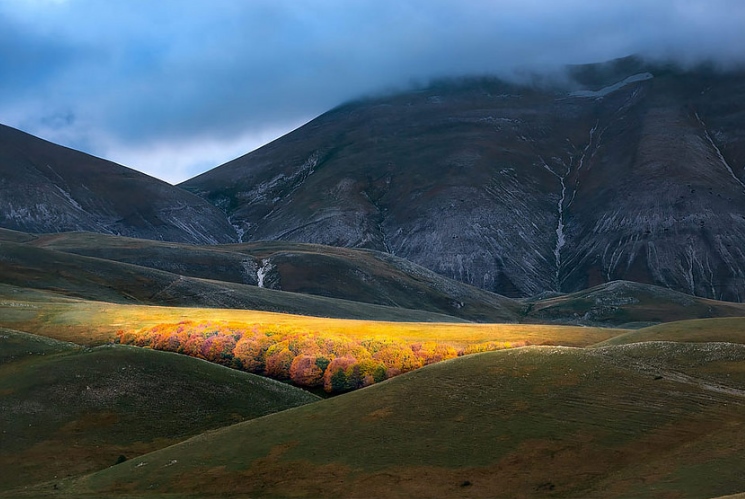



11 May 2017
The ritual vigil of a Roman Emperor: Suetonius and the Apennines
We have shown in previous posts that the Apeninnes in Italy have something to do with classical Sibyls (Cumaean, Tiburtine) and oracular shrines (“Historia Augusta”). We can even retrieve a further quote which goes in that same direction: a quote from first-century Latin writer Suetonius, the author of the celebrated work “The Twelve Ceasars”.
Let's fly through the pages of the most ancient known manuscript handing down to us Suetonius' stories about twelve Roman emperors: it is preserved at the Bibliothèque Nationale de France in Paris, under the registration number “Lat 6115”, a treasure coming down straight from the ninth century (see pictures).
In his work, Suetonius recounts the life and deeds of Aulus Vitellius Germanicus Augustus, who reigned as an Emperor after the short-lived Galba and Otho: his rule lasted for nine months only to the end of 69 A.D. when he was slain by partisans of Vespasian.
Aulus Vitellius was a descendant of a «stirpem ex Sabinis», a family originating from the province of Sabina, in central Italy, sitting right on the Apennines. And he probably knew well that this mountainous chain was a peculiar place.
When his legions defeated his rival-Emperor Otho, who finally committed suicide by stabbing himself with a knife, he actually selected the Apennines for a special night of revelling and celebration. In Suetonius' words:
«He openly drained a great draught of unmixed wine and distributed some among the troops. With equal bad taste and arrogance, gazing upon the stone inscribed to the memory of Otho, he declared that he deserved such a Mausoleum, and sent the dagger with which his rival had killed himself to the Colony of Agrippina, to be dedicated to Mars. He also held a ritual vigil throughout the night on the heights of the Apennines. Finally he entered the city (Rome) to the sound of the trumpet, wearing a general's mantle and a sword at his side...».
(in the original Latin text: «plurimum meri propalam hausit passimque divisit. Pari vanitate atque insolentia lapidem memoriae Othonis inscriptum intuens, dignum eo Mausoleo ait, pugionemque, quo is se occiderat, in Agrippinensem coloniam misit Marti dedicandum. In Appennini quidem iugis etiam pervigilium egit. Urbem denique ad classicum introiit paludatus ferroque succinctus...»).
According to Suetonius, Aulus Vitellius left Gaul and, in his course to Rome to be acclaimed as the new victorious Emperor, he stopped one full night with his troops amid the Apennines - his ancestral homeland - for a sacred festival, a sort of thanksgiving to the divine favor.
Again, for ancient Romans the Apennines seemed to be a special place for rites and celebrations. Which mount or valley did Aulus Vitellius exactly select to carry out his vigil? Nobody knows. But sure enough the Apennines had a special attractiveness for oracles, shrines and ritual, devotional practices. The Apennine Sibyl was about to come.
La veglia sacra di un Imperatore romano: Svetonio e gli Appennini
Abbiamo mostrato in precedenti post come la catena degli Appennini presenti una speciale relazione con le Sibille classiche (Cumana, Tiburtina) e i centri oracolari ("Historia Augusta"). Siamo inoltre in grado di rintracciare un'ulteriore citazione che conduce la ricerca nella medesima direzione: parole che sono tratte dagli scritti dell'autore classico Svetonio, vissuto nel I sec. d. C., ed in particolare dalla sua opera più famosa, le "Vite dei Cesari".
Voliamo insieme attraverso i fogli del più antico manoscritto conosciuto contenente l'opera di Svetonio che ci narra dei dodici imperatori romani: è conservato presso la Bibliothèque Nationale de France a Parigi, alla collocazione "Lat 6115", un vero e proprio tesoro che ci arriva direttamente dal nono secolo (cfr. immagini).
Nella sua opera, Svetonio ci racconta la vita e le gesta di Aulo Vitellio Germanico Augusto, che fu imperatore dopo Galba e Otone, entrambi destinati ad un brevissimo regno: anche l'imperio di Vitellio durò solamente nove mesi, fino al termine dell'anno 69 d.C., quando egli fu assassinato dai sostenitori di Vespasiano.
Aulo Vitellio discendeva da una «stirpem ex Sabinis», una famiglia originaria della provincia della Sabina, nell'Italia centrale, situata proprio nel mezzo degli Appennini. E, probabilmente, ben sapeva come questi luoghi fossero unici e speciali.
Quando le legioni di Vitellio sconfissero il suo rivale, l'imperatore Otone, il quale infine si diede la morte con un pugnale, egli decise di recarsi proprio tra gli Appennini per una notte speciale di festeggiamenti e celebrazioni. Nelle parole di Svetonio:
«Egli aprì botti di vino puro e lo distribuì tra i suoi. Con la stessa arroganza e vanità, osservando la lapide scolpita alla memoria di Otone, dichiarò di essere lui stesso degno di un tale mausoleo, e inviò il pugnale con il quale il suo nemico si era ucciso alla colonia di Agrippina, affinché fosse dedicato al Dio Marte. Inoltre, egli celebrò anche una veglia rituale notturna tra i gioghi dell'Appennino. Infine, entrò nella città (Roma) al suono delle trombe, vestito come un generale e indossando la spada...».
(nella versione originale latina: «plurimum meri propalam hausit passimque divisit. Pari vanitate atque insolentia lapidem memoriae Othonis inscriptum intuens, dignum eo Mausoleo ait, pugionemque, quo is se occiderat, in Agrippinensem coloniam misit Marti dedicandum. In Appennini quidem iugis etiam pervigilium egit. Urbem denique ad classicum introiit paludatus ferroque succinctus...»).
Dunque, secondo Svetonio, Vitellio aveva lasciato la Gallia e, nel dirigersi verso Roma per essere acclamato nuovo e vittorioso imperatore, egli si era fermato per un'intera notte con le sue truppe tra le vette dell'Appennino - la terra natìa dei suoi antenati - per una festa sacra, una sorta di ringraziamento reso agli Dèi per il favore concessogli.
Ancora una volta, per gli antichi Romani gli Appennini sembrano rappresentare un luogo molto speciale, presso il quale effettuare riti e celebrazioni. Quale montagna o quale valle aveva scelto Aulo Vitellio per trascorrere la sua veglia sacra? Nessuno lo sa. Ma certamente gli Appennini confermano la propria speciale vocazione per gli oracoli, i luoghi di culto e le pratiche rituali e devozionali. La Sibilla Appenninica stava già per arrivare.
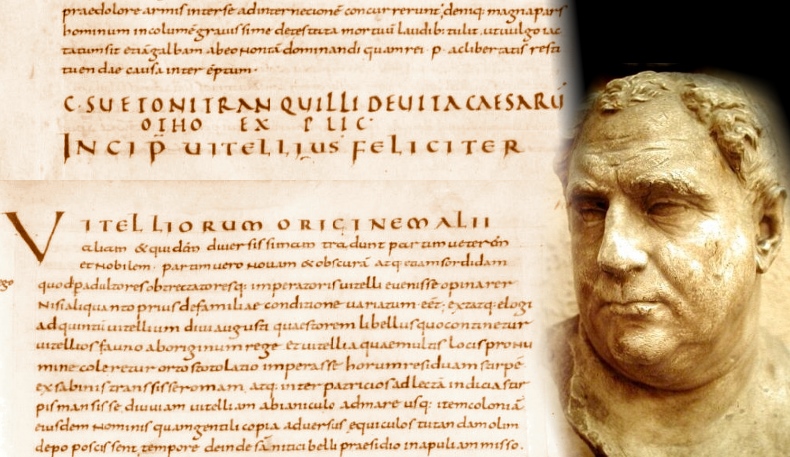

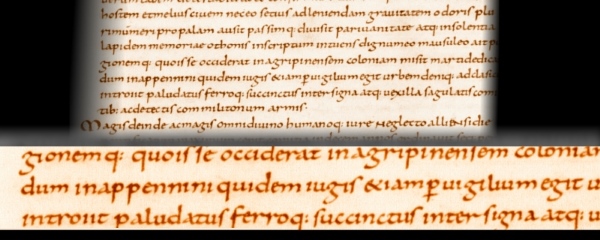

5 May 2017
An oracle in the Apennines: the “Historia Augusta”
In our effort to trace back the origin of the Apennine Sibyl, we cannot miss a well-known excerpt drawn from the “Historia Augusta”, an antique collection of biographies of Roman Emperors written in the fourth century.
For the first time ever, I will publish here the full text of the excerpt, with pictures of the “Historia Augusta”'s oldest manuscript (ninth century), written in a beautiful carolingian script.
In the section “Divus Claudius” (deified Claudius) written by Latin author Trebellio Pollio and dedicated to Claudius II Gothicus, a soldier of barbarian origin who was proclaimed Emperor by his legions in 268 A.D., we found another important link to an oracle set in the Apennines.
After having asked an oracular response about the fortunes of his lineage in Comagena, a Roman outpost at the frontier with the Noricum (Danube region), Emperor Claudius moves to another oracle. Here is how the excerpt narrates the full story:
«Similarly, when once in the Apennines he asked about his own future, he received the following reply: "Three times only shall summer behold him a ruler in Latium". Likewise, when he asked about his descendants: "Neither a goal nor a limit will I set for their power". Likewise, when he asked about his brother Quintillus, whom he was planning to make his associate in the imperial power, the reply was: "Fate shall display him to people on earth not for long”».
(in the original Latin text: «Item cum in Appennino de se consuleret, responsum huius modi accepit: "Tertia dum latio regnantem viderit aestas”. Item cum de posteris suis: "His ego nec metas rerum nec tempora ponam". Item cum de fratre Quintillo, quem consortem habere volebat imperii, responsum est: "Ostendent terris hunc tantum fata"»).
Once again, we have an oracle who delivers his/her prophecies amid the rugged peaks of the Apennines (the last prophetical statement is a verse from Vergilius' Aeneid). For Romans, Italy's mountainous backbone appears to be a special place, as we have already seen for the Tiburtine Sibyl, who in the legend of the nine suns tells the senators to move with her to the Apennines so as to render her oracular response in a fit, unblemished location.
Has the story of Claudius II Gothicus anything to do with the Apennine Sibyl? Nobody knows: the text provides no further clues, and it might just convey a reference - for instance - to the Tiburtine Sibyl. Yet, it is undeniable that the ancient tale found in the “Historia Augusta” is a confirmation of the fact that the Apennines were a magical place. A most convenient abode for a Sibyl of the Apennines.
Un oracolo negli Appennini: l'”Historia Augusta”
Proseguendo nel nostro tentativo di investigare le origini della Sibilla Appenninica, non possiamo certamente tralasciare una notissima citazione tratta dall'"Historia Augusta", un'antica raccolta di biografie di imperatori romani compilata nel IV secolo.
Per la prima volta in assoluto, pubblicheremo in questa sede il testo completo di questo brano, corredato da immagini del più antico manoscritto esistente dell'"Historia Augusta" (IX secolo), redatto con bellissimi caratteri carolingi.
Nella sezione "Divus Claudius" (Claudio il Divinizzato), scritta dall'autore latino Trebellio Pollione e dedicata a Claudio II il Gotico, un soldato di origini barbare che venne proclamato imperatore dalle sue legioni nel 268 d.C., troviamo questo ulteriore, importante riferimento ad un oracolo localizzato tra gli Appennini.
Dopo avere richiesto un responso oracolare a proposito dei futuri destini della propria discendenza, a Comagena (un avamposto imperiale situato presso la frontiera del Norico, sul Danubio), l'Imperatore Claudio si reca presso un ulteriore oracolo. Ed ecco come l'antico testo ci racconta questa storia:
«Successivamente, essendosi egli recato nell'Appennino per conoscere del proprio futuro, ricevette il seguente responso: "Solamente per tre volte l'estate lo vedrà regnare sul Lazio". Poi, quando egli domandò della propria discendenza: "Io non porrò al loro governo né limiti né confini". E infine, chiedendo del proprio fratello Quintillo, che egli voleva associare nel governo imperiale, gli fu risposto: "Non a lungo i fati lo mostreranno alle genti"».
(nel testo originale latino: «Item cum in Appennino de se consuleret, responsum huius modi accepit: "Tertia dum latio regnantem viderit aestas”. Item cum de posteris suis: "His ego nec metas rerum nec tempora ponam". Item cum de fratre Quintillo, quem consortem habere volebat imperii, responsum est: "Ostendent terris hunc tantum fata"»).
Ancora una volta, troviamo un oracolo che profetizza tra le vette scoscese dell'Appennino (l'ultimo responso profetico è un verso tratto dall'Eneide virgiliana). Per i Romani, la dorsale montuosa dell'Italia sembra essere un luogo speciale, come abbiamo già avuto modo di vedere in relazione alla Sibilla Tiburtina, la quale nella leggenda dei nove soli invita i senatori a seguirla proprio tra gli Appennini, in modo da potere rendere il proprio responso oracolare in un luogo adatto, in quanto incontaminato.
Esiste un legame tra la storia di Claudio II il Gotico e la Sibilla Appenninica? Nessuno può saperlo: il testo non ci fornisce ulteriori indizi, e potrebbe trattarsi semplicemente di un ulteriore riferimento alla Sibilla Tiburtina. Eppure, è innegabile come questo antico racconto tratto dall'"Historia Augusta" costituisca una conferma del fatto che gli Appennini erano un luogo speciale. Una dimora perfetta per una Sibilla degli Appennini.
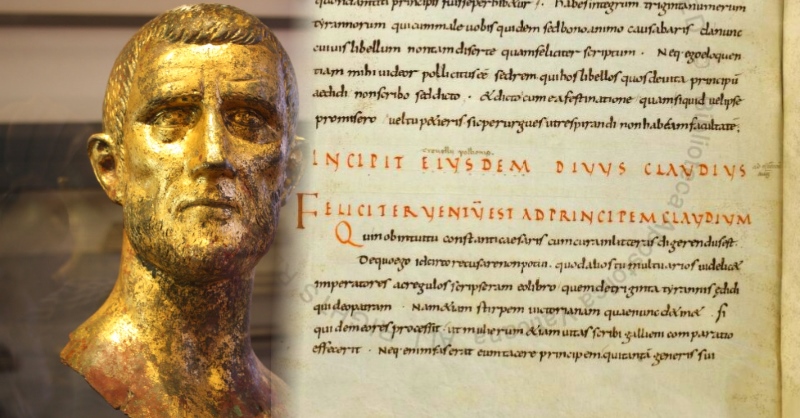

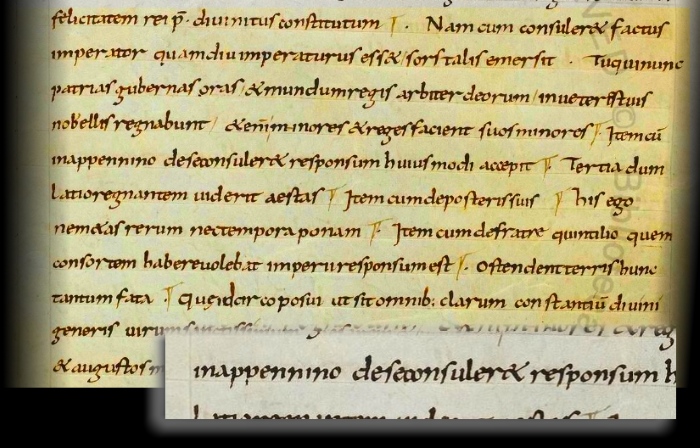

30 Apr 2017
The origin of the Apennine Sibyl: Cuma or Tivoli? (Part 3)
We have seen in a preceding post that, in antiquity, the Tiburtine Sibyl was reputed to live amid “high mountains” and rendered her oracular responses on the “apennines”. However, this does not imply any direct link to the Apennine Sibyl.
As a matter of fact, and as attested in an excerpt from Servius Marius Honoratus, the Tiburtine Sibyl just had her shrine in Tibur (modern Tivoli): a place whose picturesque setting with waterfalls and ravines, encircled by high mountains, has beguiled not only ancient Roman, but also scores of Grand Tour travellers starting from the sixteenth century and as far as our contemporary era.
In the pictures below, you can see the Temple of the Tiburtine Sibyl as it appears today: the Aniene river plunges its rushing waters down into the precipice opening its jaws just below the shrine, in a sinister gorge called “Valley of Hell”; from there, the water has broken its way further down through a sheer wall of rock, and it is swallowed by a devilish crack where no living being would ever survive if thrown into it.
In classical time, the vista was even more picturesque than today: the “Valley of Hell” was thoroughly flooded with large waterfalls and countless small rivulets oozing from innumerable crevices in the rock wall, like a sort of inhuman kingdom of natural powers (today, the new nineteenth-century waterfall has almost cancelled this liquid show).
«Quae forma beatis ante manus artemque locis!», writes Publis Papinius Statius in his work 'Silvae', containing a portrait of the place, «largius usquam indulsit Natura sibi. Nemora alta citatis incubuere vadis: fallax responsat imago frondibus, et longas eadem fugit umbra per undas. Ipse Anien - miranda fides - infraque superque saxeus hic tumidam rabiem spumosaque ponit murmura, ceu placidi veritus turbare Vopisci Pieriosque dies et habentes carmina somnos» [How kindly the temper of the soil! How beautiful beyond human art the enchanted scene! Nowhere has Nature more lavishly spent her skill. Lofty woods lean over rushing waters; a false image counterfeits the foliage, and the reflection dances unbroken over the long waves. Anio himself — marvellous to believe — though full of boulders below and above, here silences his swollen rage and foamy din, as if afraid to disturb the Pierian days and music-haunted slumbers of tranquil Vopiscus].
That's why the Tiburtine Sibyl was considered as a “mountain”, “apennine” Sibyl. But this had nothing to do with the Apennine Sibyl, hidden in her den in the Sibillini Range area, a very different mountain and natural setting.
L'origine della Sibilla Appenninica: Cuma o Tivoli? (Parte 3)
Abbiamo visto in un precedente post come, nell'antichità, si ritenesse che la Sibilla Tiburtina avesse la propria dimora tra "alte montagne", rendendo i propri responsi oracolari tra gli "Appennini". Tutto questo, però, non permette di stabilire alcuna diretta relazione con la Sibilla Appenninica.
In effetti, come attestato da un brano di Servio Mario Onorato, ciò significa semplicemente che la Sibilla Tiburtina aveva, come noto,la propria sede oracolare a Tibur (l'odierna Tivoli): un luogo le cui pittoresche caratteristiche, con cascate e precipizi circondati da alte montagne, hanno affascinato da sempre non solo gli antichi romani, ma anche decine e decine di viaggiatori del Grand Tour, a partire dal diciassettesimo secolo e fino all'età contemporanea.
Nelle immagini qui proposte, potete osservare il Tempio della Sibilla Tiburtina così come appare ai nostri giorni: il fiume Aniene si getta con acque roboanti nel precipizio che si apre proprio al di sotto del tempio, nella sinistra valle nota con il nome di "Valle dell'Inferno"; da qui, l'acqua si è poi scavata un passaggio che discende ancora più in basso, attraverso una muraglia di roccia viva, e viene infine inghiottita all'interno di una sorta di maligna fessurazione nella quale nessun essere vivente potrebbe mai sopravvivere, se mai dovesse trovarsi a precipitare in essa.
In età classica, lo scenario si presentava in modo ancor più pittoresco di oggi: la "Valle dell'Inferno" era completamente inondata da grandi cascate e innumerevoli rivoli di minori dimensioni, fuoriuscenti dai molteplici orifizi aperti nella roccia, come se si trattasse di una sorta di regno inumano governato dalla potenza della natura (oggi, invece, la nuova cascata realizzata nel diciannovesimo secolo ha quasi completamente cancellato questo affascinante spettacolo d'acqua).
«Che dolce natura ha il suolo, quale bellezza possiedono quei luoghi fortunati», scrive Publio Papinio Stazio nella sua opera "Silvae", che include una descrizione di questi luoghi, «anche senza il lavoro e l’arte dell’uomo. In nessun luogo la natura è stata più generosa verso se stessa. Alti boschi si protendono verso le acque scorrenti, le fronde si moltiplicano in falsi riflessi, e le ombre fuggono sulle onde. L’Aniene stesso – straordinario a credersi – che scorre sassoso a valle e a monte, qui depone la sua tumida furia e i rimbombi spumeggianti, come se temesse di turbare i giorni consacrati alle Muse e i sonni pieni di poesia del sereno Vopisco».
Ed ecco dunque perché la Sibilla Tiburtina è stata sempre considerata come una Sibilla "di montagna", "degli appennini". Ma ciò non ha nulla a che fare con la Sibilla Appenninica, nascosta nel suo elevato rifugio posto nella regione dei Monti Sibillini, una zona montuosa del tutto differente e caratterizzata da ben diversi scenari naturalistici.
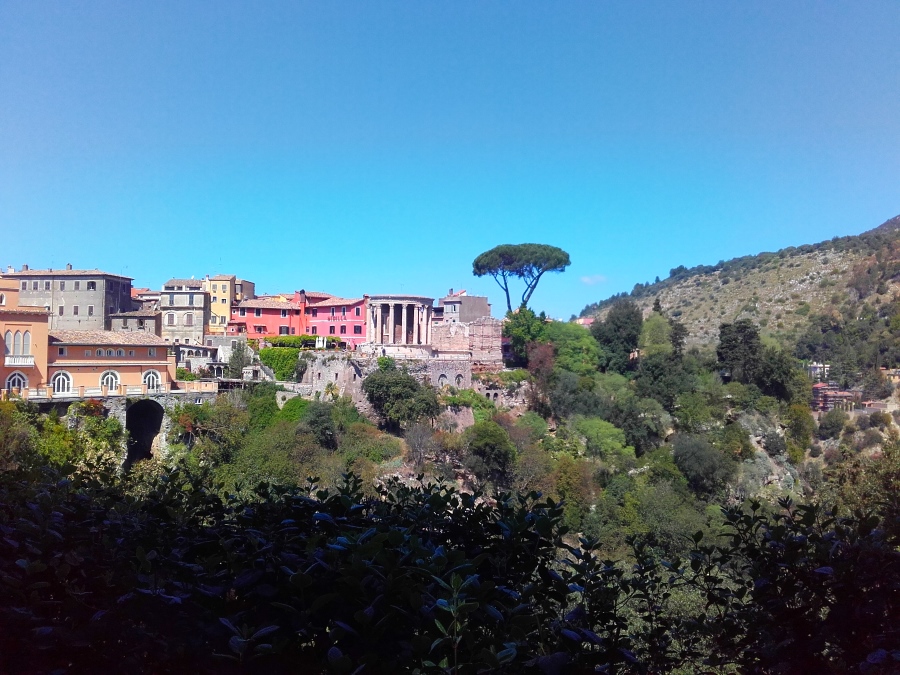

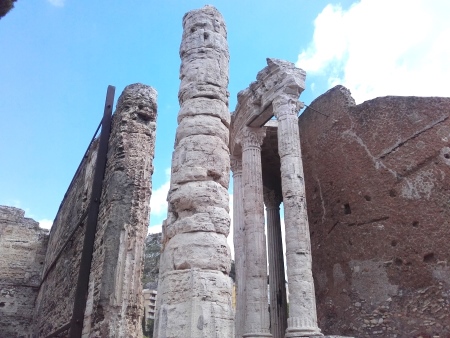
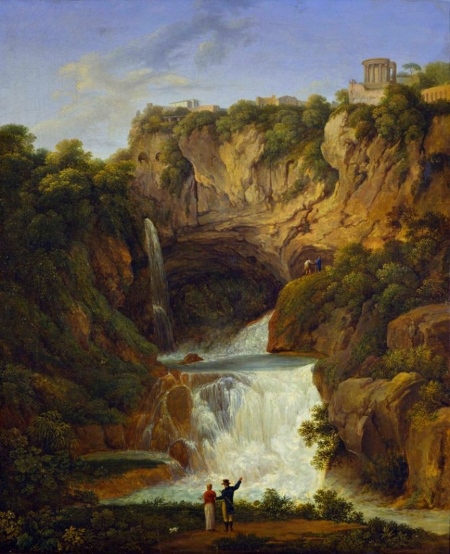
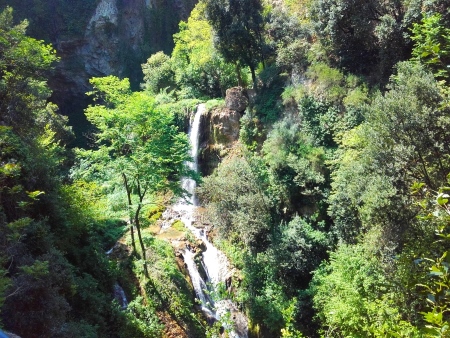
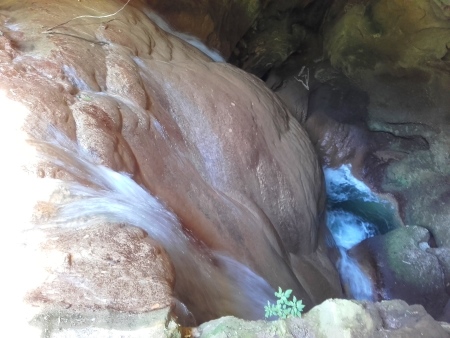
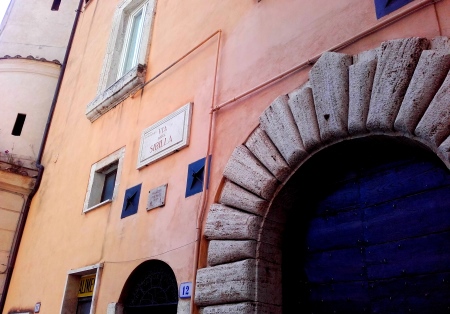

20 Apr 2017
The origin of the Apennine Sibyl: Cuma or Tivoli? (Part 2)
Beside the Cumaean, there is another classical Sibyl as to whom a sort of connection to the Apennine Sibyl might be highlighted: the Tiburtine Sibyl.
The tiburtine oracle is included in the famous list of ten Sibyls reported by Latin author Lactantius in his “Divinae Institutiones”, as a quote from Varro: «the tenth of Tibur, by name Albunea, who is worshipped at Tibur as a goddess, near the banks of the river Aniene, in the depths of which her statue is said to have been found, holding in her hand a book».
In early-Christian times, the Tiburtine Sibyl was known for the prophecy and legend of the nine suns: a visionary dream made by a hundred Roman senators at the same time, which the Sibyl explained as a succession of historical ages from the Roman empire to the advent of Christianity, future wars and finally the end of the world. The legendary account was copied in dozens of manuscripts across Europe.
The peculiar aspect about this Sibyl is that she is linked to mountains and the Apennines: in some manuscripts reporting the prophecy of the Tiburtine oracle on the nine suns, she tells the senators that she will provide them with a response «in apenninnum», on the Apennine mountains, considered as a sacred and unblemished place as opposed to corrupted Rome. This same indication is present in “Le Livre de Sibile” (The Book of the Sibyl), a thirteen-century anglo-norman work attributed to Philippe de Thaon, which reports the same Tiburtine Sibyl's episode by saying that the senators should move «ki apenin anun». An old manuscripted French version of the same prophecy dating to 1300 states «alons en la montagne ancyene» ('let's move to the old mountain'). Finally, in the “Liber Mirabilis”, a sixteenth-century book containing a collection of prophecies, the Tiburtine Sibyl invites the Roman senators «in monte apennin».
Could the Tiburtine Sibyl have chosen a remote Apennine peak as her oracular shrine of choice? Could all that refer to the cliff of Mount Sibyl?
The surmise is truly fascinating. However, we must stick to facts (at least literary ones) and there is no evidence of any direct connection between Mount Sibyl and the Apennines mentioned in the Tiburtine oracle's nine-sun legend.
Furthermore, we must consider the illuminating words that Servius Marius Honoratus, a fourth-century scholar, wrote in his “Commentary on Virgil's Aeneid”: «Albunea. [...] quia est in Tiburtinis altissimis montibus». It is clear that the “high mountains” where the Tiburtine (or Albunea) Sibyl used to live are plainly the mountainous ridges at Tivoli, near Rome: they are not as high as Mount Sibyl, nonetheless they are fully impressive and picturesque, with ravines and waterfalls celebrated throughout the centuries by scores of artists and men of letters.
So, the Apennine Sibyl is not the Tiburtine one (if we want to explore a more promising connection, we will have to study the story of the Cumaean). And yet, there is no doubt that by this focus on the oracular Apennines we have shown that in antiquity those lofty mountainous ridges in Italy were considered as a pure and unblemished place: a convenient location for oracles and prophetical responses, as we will also see in the next post.
[in the picture: Tiburtine Sibyl, Anna Bacherini Piattoli, 1750, Collezione Alessandro Marabottini, Palazzo Baldeschi, Perugia (Italy)]
L'origine della Sibilla Appenninica: Cuma o Tivoli? (Parte 2)
Oltre alla Cumana, c'è anche un'altra Sibilla classica per la quale può essere posto in evidenza un qualche tipo di legame con la Sibilla Appenninica: la Sibilla Tiburtina.
L'oracolo tiburtino fa parte della famosa lista di dieci Sibille presente nelle "Divinae Institutiones" dello scrittore latino Lattanzio, una citazione da un testo di Varro: «la decima [Sibilla], tiburtina, nota anche come Albunea, venerata come dea a Tivoli presso le rive del fiume Aniene, dai cui flutti si racconta sia stata tratta una sua statua, reggente un libro nella mano».
Al tempo dei primi Cristiani, la Sibilla Tiburtina era nota per la leggendaria profezia dei nove soli: una visione onirica, sognata da cento senatori romani nel corso della stessa notte; una visione che la Sibilla interpretò come una successione di età storiche, dall'impero romano all'avvento del Cristianesimo, seguiti da conflitti futuri e poi dalla fine del mondo. Il racconto leggendario ci è stato tramandato nei secoli in dozzine di copie manoscritte reperite in tutta Europa.
L'aspetto particolare di questa Sibilla consiste nel fatto che essa è legata alle montagne e all'Appennino: in alcuni manoscritti che raccontano della profezia sibillina relativa ai nove soli, l'oracolo risponde alla richiesta dei senatori dicendo loro che fornirà il proprio responso «in apenninnum», sulle montagne dell'Appennino, considerate come sacre e incorrotte, contrariamente alla sordida Roma. Questa stessa indicazione è presente anche ne "Le Livre de Sibile" (Il Libro della Sibilla), un'opera anglo-normanna del tredicesimo secolo attribuita a Philippe de Thaon, nella quale si racconta il medesimo episodio concernente la Sibilla Tiburtina, la quale esorta i senatori a recarsi «ki apenin anun». Un'antica versione manoscritta in lingua francese della stessa profezia, risalente al 1300, riporta «alons en la montagne ancyene» ('andiamo alla montagna antica'). Infine, nel "Liber Mirabilis", un'opera cinqucentesca che raccoglie una serie di profezie, la Sibilla Tiburtina invita i senatori romani «in monte apennin».
È concepibile che la Sibilla Tiburtina abbia potuto prescegliere un remoto picco dell'Appennino come proprio sito oracolare?
Potrebbe riferirsi, tutto ciò, alla cima del Monte Sibilla?
L'ipotesi è certamente affascinante. D'altra parte, è comunque necessario tentare di rimanere ancorati ai fatti (quantomeno ai fatti letterari) e non possiamo dunque affermare che sussista una qualsivoglia evidenza di un legame diretto tra il Monte Sibilla e gli Appennini menzionati nella leggenda della Sibilla Tiburtina e dei nove soli.
Inoltre, dobbiamo tenere presenti le parole illuminanti che Servio Mario Onorato, un autore del quarto secolo, ha vergato nei propri "Commentari all'Eneide di Virgilio": «Albunea. [...] quia est in Tiburtinis altissimis montibus», dice. È dunque chiaro che gli "altissimi monti" tra i quali la Sibilla Tiburtina (o Albunea) aveva la propria dimora non erano altro che le creste montuose di Tivoli, in prossimità di Roma: esse non sono certamente elevate come il picco del Monte Sibilla, nondimeno si tratta di montagne impressionanti e pittoresche, con scoscesi precipizi e fantastiche cascate, che sono stati resi celebri nei secoli attraverso le descrizioni pubblicate da innumerevoli artisti e letterati.
E così, la Sibilla Appenninica non è la Sibilla Tiburtina (se vogliamo provare ad esplorare un ben più promettente legame, dovremo rivolgerci alle vicende della Sibilla Cumana). Malgrado ciò, non c'è dubbio che, a valle di questa nostra focalizzazione sul ruolo oracolare degli Appennini, abbiamo potuto dimostrare come, nell'antichità, queste alte montagne d'Italia siano state considerate come luoghi particolarmente puri e ancora incorrotti: luoghi adatti, dunque, ad ospitare oracoli e profezie, come avremo modo di vedere nel prossimo post.
[nell'immagine: Sibilla Tiburtina, Anna Bacherini Piattoli, 1750, Collezione Alessandro Marabottini, Palazzo Baldeschi, Perugia]
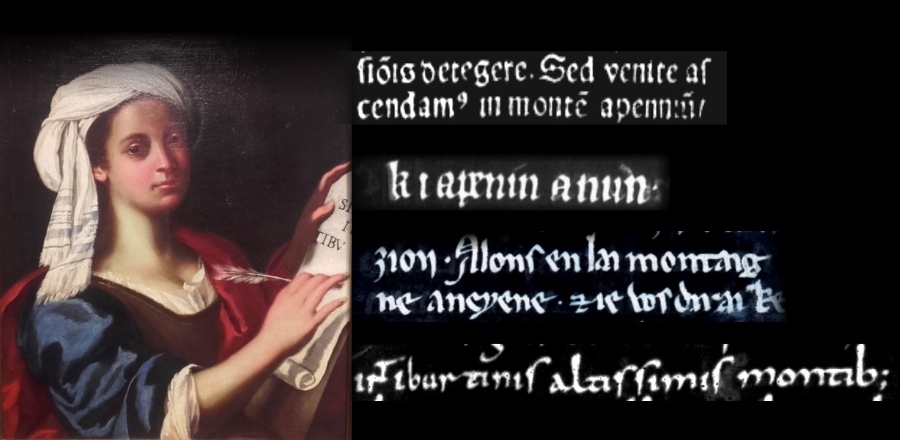

15 Apr 2017
The origin of the Apennine Sibyl: Cuma or Tivoli? (Part 1)
The Apennine Sibyl seems to have suddenly popped up in the fifteenth century, when she was mentioned for the first time ever in the romance “Guerrino the Wretch” and in De La Sale's “The Paradise of Queen Sibyl”. Did she appear from nothing? Or possibly, is she the heir of the classical Sibyls of the Roman age?
The latter is the right answer, and we may find at least two different ancestors for the Sibyl of the Apennines: both are Sibyls, and both are Italian.
A first lineage takes us back to the Cumaean Sibyl, the most illustrious Italian Sibyl in antiquity. Publius Vergilius Maro writes, in his Aeneid, that «Cumaea Sibylla - horrendas canit ambages antroque remugit - obscuris vera involvens»: terrific riddles she yells, as she sings in her cave, the truth enshrouded in darkness. The Sibilline Books containing the Cumaean Sibyl's prophecies were carefully preserved in a shrine at the Capitoline Hill in Rome.
But why the Cumaean Sibyl should have fled from her famous cave in Cuma to a remote Apennine peak?
Ancient lore reports two different reasons. According to one legendary tradition, the Cumaean prophetess had been a teacher and tutor of the young Holy Mary: in this role she had entertained the idea to take the place of the maiden and become herself the mother of the Son of God. Because of her vile, haughty desire she had been punished and sentenced amid the cliffs of the Apennine.
When Guerrino the Wretch meets the Sibyl, he questions her on this very topic: «O much wise Sibyl, the Divine Grace accorded to you the favour of being the teacher of that virgin who was the mother of the Saviour in his human flesh; how it happened you insanely did not succeed in saving your soul owing to the affliction that overwhelmed you when the deity did not incarnate in your womb?»
But she stops him abruptly and replies angrily that «I was no teacher to our lady. Sir Guerrino, I see you are not so smart as I thought; who ever told you such piece of infomation?». And she continues: «I want you to know my name. I was called 'Cumaean' by the Romans for I was born in a town in the countryside whose name is Cuma: before I was sentenced to this place I lived in the world one thousand two hundred years. When Aeneas came to Italy, I led him through the nether world: and I was seven hundred years old at that time».
Despite all her irritated replies, the Sibyl admits she has been “sentenced” to the craggy fastnesses of the Apennines. If not with relation to the Holy Mary, the reason for that may also be found in the persecutions carried out by early-Christian followers against the Greek and Roman deities, whose temples and shrines were ravaged after the fourth century A.D. Ludovico Ariosto, the author of 'Orlando Furioso', refers to this very lore when he writes «the Cumæan Sibyl [...] who fled, in antiquity, to a Cavern in the territory of Norcia, placed on a mountain-top amidst a gloomy forest, from the charming abode she used to live in at earlier times». A safe den, against the growing threat by the new emerging religion.
The Cumaean Sibyl and the Apennine Sibyl: we just saw that a close link existed between them, so much so that in ancient maps the Lakes of Pilatus, at the very core the Apennine Sibyl's kingdom, bore the same name as the Cumaean prophetess' magical lake: the Lake of Avernus.
Yet, this is not the only lineage up to an ancient Sibyl we can spot today. Another ancestral link does exist to another classical Italian Sibyl: the Tiburtine oracle.
L'origine della Sibilla Appenninica: Cuma o Tivoli? (Parte 1)
La Sibilla Appenninica sembra apparire all'improvviso, nel quindicesimo secolo, quando se ne fa menzione per la prima volta nel romanzo "Guerrin Meschino" e nell'opera di De La Sale "Il Paradiso della Regina Sibilla". Come è possibile che sia apparsa dal nulla? O forse, questa Sibilla è l'erede delle Sibille classiche di età romana?
La risposta giusta pare essere proprio questa, ed è possibile oggi individuare almeno due diverse ascendenze per la Sibilla degli Appennini: si tratta, in entrambi i casi, di Sibille, e di Sibille italiche.
Una prima linea di ricerca ci riporta fino alla Sibilla Cumana, la pià famosa sibilla italica dell'antichità. Publio Virgilio Marone scrive, nell'Eneide, che «Cumaea Sibylla - horrendas canit ambages antroque remugit - obscuris vera involvens»: enigmi paurosi essa canta mugghiando nell’antro, la verità avvolgendo di tenebra. Nell'antica Roma, i preziosi Libri Sibillini, contenenti le profezie della Sibilla Cumana, erano conservati presso il Campidoglio.
Ma perché la Sibilla Cumana avrebbe dovuto abbandonare il suo famoso antro di Cuma per rifugiarsi sulla cima di un isolato picco dell'Appennino?
Le antiche leggende ci raccontano di due diverse possibili cause. Secondo una specifica tradizione, la profetessa di Cuma sarebbe stata la tutrice ed insegnante della giovane Vergine Maria: in tale ruolo, la sacerdotessa avrebbe accarezzato l'idea di prendere il posto della fanciulla e diventare ella stessa la madre del Figlio di Dio. Per questo suo desiderio presuntuoso e indegno, la Sibilla sarebbe stata punita e condannata a trascorrere l'eternità tra le vette dell'Appennino.
Quando Guerrino il Meschino incontra la Sibilla, egli non manca di interrogarla proprio su questo particolare argomento: «O sapientissima Sibilla havendoti conceduta la divina providentia la gratia che tu fosti maestra de quela verzene in cui incarnò el Salvatore de la humana natura, coma p[er]destu el sen[n]o de non te salvare per ché te desperasti se la divinità non des[c]ese in te?»
A queste parole, la Sibilla lo interrompe bruscamente e gli risponde, con ira, di «non essere stata quella che insegna a nostra donna [...] Mis[s]ere Guerino, el tuo sen[n]o non è perfecto come credeva: chi è colui che mostra questo che tu hai dito?». Continua poi: «Io voglio che tu sapi el mio nome. Io fui chiamata da Romani chumana per che io naqui in una cità de campagna che ha nome chumana: e stete al mondo inanzi che io fosse iudicata in questa parte mille e ducento anni, che quando Enea vene i queste parte zoe i Italia, io lo menai per tuto lo inferno: e havea alhora sete cento anni».
Malgrado la risposta alquanto seccata, la Sibilla ammette di essere stata "iudicata", condannata alle remote montagne dell'Appennino. Se non a causa della Vergine Maria, le motivazioni di questa condanna possono essere rinvenute nelle persecuzioni condotte dai primi cristiani contro le divinità greche e romane dopo il IV sec. d.C. Ludovico Ariosto, l'autore dell'Orlando Furioso, sembra riferirsi proprio a questa possibilità quando scrive «la Sibilla Cumea, la qual ridotta / s’era in quei tempi a la Nursina grotta / su gli aspri monti in una selva folta / da i luoghi ameni, ove habitava prima». Un rifugio, dunque, contro le crescenti minacce provenienti dalla nuova religione emergente.
La Sibilla Cumana e la Sibilla Appenninica: abbiamo appena visto come tra di esse sussista uno stretto legame, tanto che nelle mappe antiche i Laghi di Pilato, posti nel cuore del regno della Sibilla Appenninica, sono identificati con il medesimo nome del magico lago della profetessa cumana: il Lago di Averno.
In ogni caso, non è questa l'unica ascendenza che possiamo rinvenire verso un'antica Sibilla. Esiste infatti un altro illustre legame, con un'altra Sibilla dell'Italia classica: la Sibilla Tiburtina.
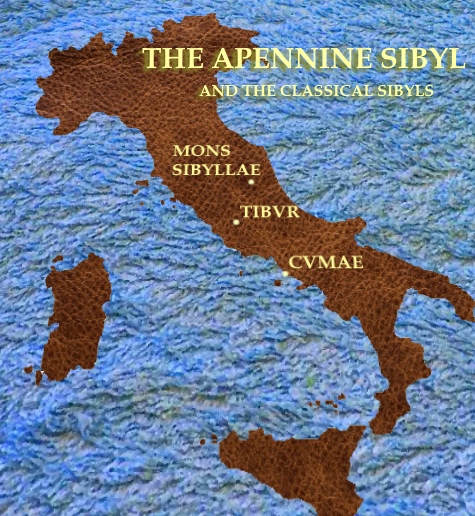

7 Jan 2017
An Apennine Sibyl from early Middle Ages?
The anglo-norman chronicle from Philippe de Thaun (“Le Livre de Sibile”, XII century) is not by no means the earliest mention of a Sibyl in the Apeninnes.
From the earliest centuries of Middle Ages and possibly ever since late Roman times, the Italian Apennines had been connected to Sibyls. Many manuscripts (e.g. Oxford Bodleian Library, manuscript Laud n. 633, XIII sec. - not available online), which report older versions of the “Prophecy of the Tiburtine Sibyl” in Latin, drawn from very ancient manuscripts now lost, speak clearly and plainly of the Apennine. Such older versions were collected in a later work, the “Mirabilis Liber” (1522), which states the following:
«Respondens Sibila dixit ad eos: Non est equum in loco stercoribus pleno, et diversis certaminatiationibus polluto, sacramentum huius visionis detegere. Sed venite ascendam in montem apennin, et ibi vobis pronunciabo que ventura sunt civibus Romanis, et fecerunt, ut dixit.»
(The Sibyl replied to them: it is not convenient, in this unclean place and so polluted by conflicts, to unveil the sacred secrets of this dream. You rather come with me, I will climb the Apennine mount, and there I will foretell to you the fate of Roman citizens; and the Romans did what she had asked them to).
So the Tiburtine Sibyl had spoken to the Roman senators: there was a mount among the Apennines, a special place where she could prophesize conveniently.
Could that place be what we know today as “Mount Sibyl”?
Una Sibilla Appenninica sin dall'Alto Medioevo?
La cronaca anglo-normanna di Philippe de Thaun (“Le Livre de Sibile”, XII sec.) non costituisce affatto la più antica menzione di una Sibilla tra gli Appennini.
Fin dai più remoti secoli dell'Alto Medioevo e probabilmente sin dalla tarda età romana, gli Appennini sono stati legati alle Sibille. Molti manoscritti (es. Oxford Bodleian Library, manoscritto Laud n. 633, XIII sec. - non disponibile online), i quali riportano versioni ancora più antiche della “Profezia della Sibilla Tiburtina” in lingua latina, tratte da manoscritti antichissimi oggi perduti, menzionano chiaramente e palesemente i monti Appennini. Queste antiche versioni furono successivamente raccolte nel “Mirabilis Liber” (1522), che così racconta la profezia della Sibilla:
«Respondens Sibila dixit ad eos: Non est equum in loco stercoribus pleno, et diversis certaminatiationibus polluto, sacramentum huius visionis detegere. Sed venite ascendam in montem apennin, et ibi vobis pronunciabo que ventura sunt civibus Romanis, et fecerunt, ut dixit.»
(Rispose loro la Sibilla: non è confacente, in questo loco impuro e così contaminato dalle lotte, che vengano svelati i sacri segreti di questa visione; piuttosto venite con me, salirò al monte appennino, e lì vi dirò i fati dei cittadini di Roma; ed essi fecero come ella aveva chiesto loro).
Così la Sibilla Tiburtina aveva parlato ai senatori Romani: c'era una montagna, negli Appennini, un luogo speciale dove lei avrebbe potuto pronunciare oracoli in modo confacente.
È possibile che questo luogo fosse ciò che oggi noi conosciamo sotto il nome di “Monte Sibilla”?
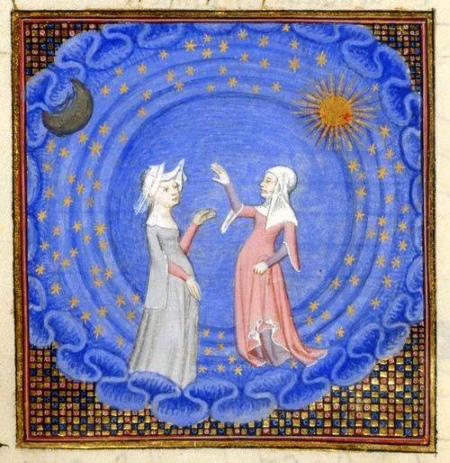

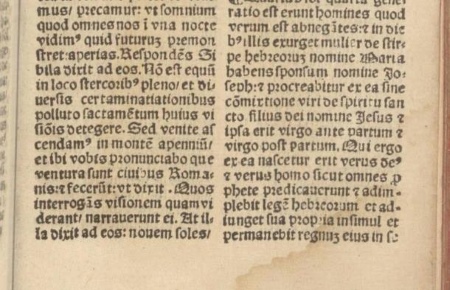

6 Jan 2017
The Sibyl and the Apennines in a most precious manuscript dating to the twelfth century
It is not so widely known that the connection between a Sibyl and the Apennine range has not been established in the fifteenth century with “Guerrino the Wretch” and Antoine de La Sale: the link dates back to more than two centuries earlier, as is attested in the valuable manuscript n. 25407 residing in the Bibliothèque Nationale of France.
The manuscript contains “Le Livre de Sibile” (The Book of the Sibyl), an ancient work attributed to Philippe de Thaon, an anglo-norman author of Middle-Age treatises on stones and animals.
In the account reported in “Le Livre de Sibile” (sheet 162), a tale is told about a hundred Roman senators who, during the same night, had the same inexplicable dream, featuring nine multi-coloured suns. The puzzled senators decided to summon the Tiburtine Sibyl to Rome and ask her the meaning of their dream.
But the “regine Sibille” (Queen Sibyl) refused to explain the dream right there in Rome, a place that was unclean; she invited the senators to move to another place more fit to the disclosure of an oracular response: in the anglo-norman text, “ki apenin anun”, all of them should move “to the apennines”.
Thus, here is a first amazing connection between a Sibyl and the Apennines. It is a link established around year 1120. The Apennines, as a proper place for magic and prophecies.
La Sibilla e l'Appennino in un preziosissimo manoscritto del XII secolo
Non tutti sanno che il legame tra la Sibilla e i monti dell'Appennino non risale al 1400 di “Guerrin Meschino” e di Antoine de La Sale, ma a ben due secoli prima, come si rileva nel prezioso manoscritto n. 25407 conservato presso la Bibliothèque Nationale de France.
Il manoscritto contiene “Le Livre de Sibile”, antichissima opera attribuita a Philippe de Thaon, nobile autore anglo-normanno di lapidarii e bestiarii medievali.
Nel racconto del “Livre de Sibile”, al foglio 162, si racconta di come, una notte, cento senatori dell'antica Roma sognassero lo stesso incomprensibile sogno, nel quale campeggiavano nove diversi soli multicolori. Perplessi, i senatori decisero di convocare a Roma la Sibilla Tiburtina, oracolo di avvenente bellezza, affinché spiegasse loro il significato del sogno.
Ma la “regine Sibille” si rifiutò di interpretare quel sogno in Roma, luogo impuro; e propose ai senatori di trasferirsi in un luogo adatto alla rivelazione del vaticinio: nel testo anglo-normanno, “ki apenin anun”, che si recassero dunque tutti “nell'appennino”.
Ed ecco un primo, straordinario legame tra una Sibilla e i monti dell'Appennino. Attestato già intorno al 1120. L'Appennino, come luogo congeniale alla magia e ai responsi oracolari.
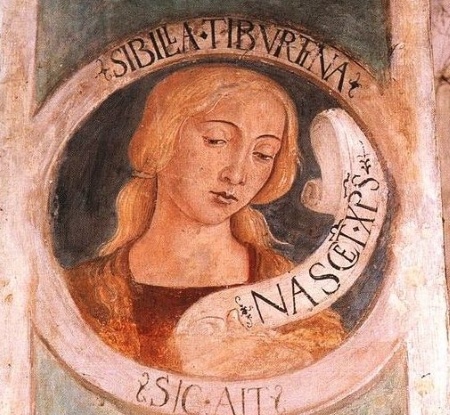
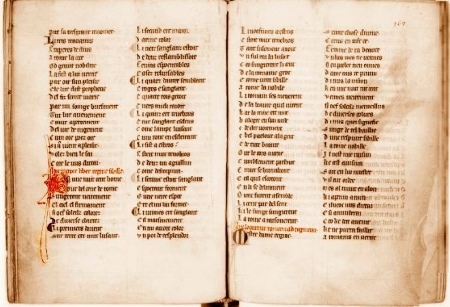
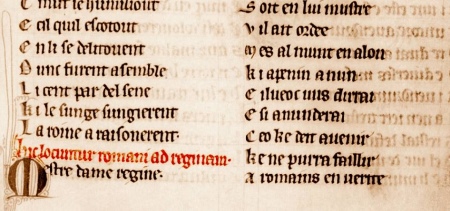


26 Dec 2016
Guerrino, the Sibyl and the Holy Mary
In the chivalric romance “Guerrino the Wretch” by Andrea da Barberino, a fifteenth-century work, another specific connection between the Apennine Sibyl and the Nativity is mentioned, with a peculiar overlapping between the pagan priestess and the Holy Mary. One of the men asked by Guerrino for information on the Sibyl so replies to him:
«I heard that the wise Sibyl was a virginal maid, so that she had hoped that God would enter into her when the Incarnation occurred in the Holy Mary. Because of that different choice she grieved and was then sentenced amid these mountainous ridges».
The Sibyl, a virgin like the Holy Mary, had aspired to be the chosen one to bear the Jesus in her womb. Yet, God's design was not hers: Mary was chosen and the Sibyl was punished for her overambitious wish and sent to a remote confinement among the Apeninnes.
Guerrino, la Sibilla e la Vergine Maria
Nel romanzo cavalleresco "Guerrin Meschino" di Andrea da Barberino, un'opera risalente al quindicesimo secolo, viene menzionata un'altra specifica connessione tra la Sibilla Appenninica e la Natività di Gesù, con una peculiare sovrapposizione tra la figura della sacerdotessa pagana e quella della Vergine Maria. Uno degli uomini ai quali Guerrino aveva chiesto informazioni a proposito della Sibilla, aveva infatti risposto in questo modo:
«Io ho udito dir che ze la savia Sibilla la quale si è vergene in lo mondo che la credea che dio scendesse i(n) lei qua(n)do incarnò in Maria vergine. E per questo lei desperò e fu ziudicata per questa casone in queste montagne».
La Sibilla, una vergine come Maria, aveva desiderato di essere lei la prescelta per concepire Gesù nel proprio grembo. La volontà di Dio, però, non fu quella di lei: la prescelta fu Maria, e la Sibilla venne punita per il suo ambizioso desiderio, venendo così confinata in un luogo solitario degli Appennini.
25 Dec 2016
The Sibyls who sung the Incarnation
In the fifth century AD, Augustine of Hippo, the great theologian and philosopher, included the Sibyls in the Christian theological system, conferring further life to their legend for the centuries to come. In Book XVIII, Chapter XXIII of his "The City of God" he wrote the following statements about the Sibyls:
«Of the Erythræan Sibyl, Who is Known to Have Sung Many Things About Christ More Plainly Than the Other Sibyls
This sibyl of Erythræ certainly wrote some things concerning Christ which are quite manifest, and we first read them in the Latin tongue in verses of bad Latin, and unrhythmical, through the unskillfulness, as we afterwards learned, of some interpreter unknown to me. For Flaccianus, a very famous man, who was also a proconsul, a man of most ready eloquence and much learning, when we were speaking about Christ, produced a Greek manuscript, saying that it was the prophecies of the Erythræan sibyl, in which he pointed out a certain passage which had the initial letters of the lines so arranged that these words could be read in them in Greek language "Jesus Christ the Son of God, the Saviour." […]
But this sibyl, whether she is the Erythræan, or, as some rather believe, the Cumæan, in her whole poem, of which this is a very small portion, not only has nothing that can relate to the worship of the false or feigned gods, but rather speaks against them and their worshippers in such a way that we might even think she ought to be reckoned among those who belong to the city of God.»
[in the original Latin text]
"Quod fuerit carmen Sibyllae Erythraeae.
Eodem tempore nonnulli Sibyllam Erythraeam vaticinatam ferunt. Sibyllas autem Varro prodit plures fuisse, non unam. Haec sane Erythraea Sibylla quaedam de Christo manifesta conscripsit; quod etiam nos prius in latina lingua versibus male latinis et non stantibus legimus per nescio cuius interpretis imperitiam, sicut post cognovimus. Nam vir clarissimus Flaccianus, qui etiam proconsul fuit, homo facillimae facundiae multaeque doctrinae, cum de Christo colloqueremur, graecum nobis codicem protulit, carmina esse dicens Sibyllae Erythraeae, ubi ostendit quodam loco in capitibus versuum ordinem litterarum ita se habentem, ut haec in eo verba legerentur: , quod est latine: Iesus Christus Dei Filius Salvator. […]
Haec autem Sibylla sive Erythraea sive, ut quidam magis credunt, Cumaea ita nihil habet in toto carmine suo, cuius exigua ista particula est, quod ad deorum falsorum sive factorum cultum pertineat, quin immo ita etiam contra eos et contra cultores eorum loquitur, ut in eorum numero deputanda videatur, qui pertinent ad civitatem Dei."
Le Sibille che cantarono l'Incarnazione
Nel quinto secolo, Agostino di Ippona, il grande teologo e filosofo, incluse le Sibille nel sistema teologico cristiano, conferendo così ulteriore vitalità alla loro leggenda per i secoli a venire. Nel Libro XVIII, Capitolo XXIII della sua opera "La città di Dio", egli così scrisse a proposito delle Sibille:
«Sulla Sibilla Eritrea, la quale è noto abbia cantato molte cose a proposito di Cristo più chiaramente delle altre Sibille.
La Sibilla Eritrea ha certamente e palesemente scritto molte cose concernenti il Cristo, e le possiamo leggere per la prima volta in Latino, in cattivi versi latini, molto dissonanti a causa della goffaggine, come in seguito abbiamo potuto apprendere, di un qualche copista a me ignoto. Perché Flacciano, un uomo molto famoso, che fu anche proconsole, personaggio di prontissima eloquenza e grande erudizione, un giorno che stavamo discutendo di Cristo, tirò fuori un manoscritto in greco, del quale affermava si trattasse delle profezie della Sibilla Eritrea, tra le quali egli evidenziò un certo brano nel quale le lettere iniziali dei versi andavano a formare le seguenti parole, facilmente leggibili, in greco, che significano, “Gesù Cristo figlio di Dio Salvatore.” […]
Ma la Sibilla, fosse essa l'Eritrea oppure, come molti piuttosto ritengono, la Cumana, nel suo poema, del quale quella citata è solo una minima porzione, non solo non contiene nulla che sia relativo al culto dei falsi dèi, ma anche si esprime apertamente contro di essi e i loro seguaci, in un modo tale che noi potremmo anche pensare che essa debba essere riconosciuta tra coloro che appartengono alla città di Dio.»
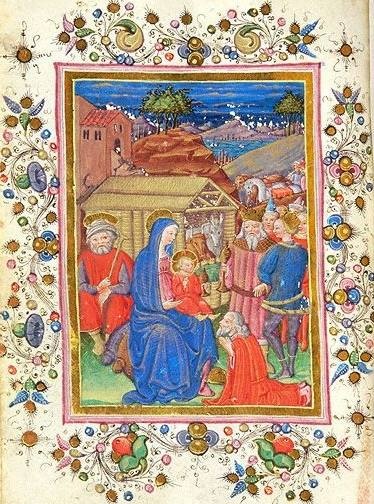
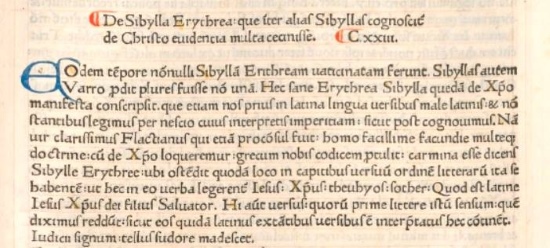

24 Dec 2016
The Christian Sibyls
In early Christianity, the Sibyls – pagans as they were – were considered as witnesses of the Incarnation. Owing to their vaticinating powers, early-Christian authors reported that the Sibyls had divined the coming of the Son of God, before the actual birth of Jesus in Betlehem. Isidore of Seville, who lived between the sixth and seventh century, wrote in his 'Etymologiae sive Originum' (Book VIII, Chapter 8) the following sentence about the Sibyls:
«Quarum omnium carmina efferuntur, in quibus de Deo et de Christo et gentibus multa scripsisse manifestissime conprobantur» («Songs by all of them are published in which they are attested to have written many things most clearly even for the pagans about God and Christ»)
And that's why the myth of the Sibyl has survived the coming of the new Christian era and the disappearance of the old gods: they were part of God's greater design for the salvation of the world.
Le Sibille cristiane
Tra i primi Cristiani, le Sibille - benché pagane - furono considerate come testimoni dell'Incarnazione. Grazie ai poteri oracolari ad esse attribuiti, gli antichi autori cristiani poterono scrivere che le Sibille avevano preannunciato la venuta del Figlio di Dio, prima dell'effettiva nascita di Gesù a Betlemme. Isidoro di Siviglia, vissuto tra il sesto e il settimo secolo, scrisse nelle sue 'Etymologiae sive Originum' (Libro VIII, Capitolo 8) la seguente frase a proposito delle Sibille:
«Quarum omnium carmina efferuntur, in quibus de Deo et de Christo et gentibus multa scripsisse manifestissime conprobantur» («Sono noti alcuni canti delle Sibille nelle quali esse scrissero molte cose a proposito di Dio e di Cristo, in modo che fossero comprensibili anche ai pagani»)
Ed ecco perché il mito delle Sibille è sopravvissuto all'inizio della nuova età cristiana e alla sparizione degli antichi dèi: esse erano infatti parte del grande disegno di Dio per la salvezza del mondo.
10 Oct 2015
The Sibyl's fairy tale
"Stories often described as fairy tales, be they told in the Caribbean, Scotland or France, can flow with the irrepressible energy of interdicted narrative and opinion among groups of people who have been muffed in the dominant, learned milieux.
The Sibyl, as the figure of a storyteller, bridges divisions in history as well as hierarchies of class. She offers the suggestion that sympathies can cross from different places and languages, different peoples of varied status. She also represents an imagined cultural survival from one era of belief to another. Sibilla exists as a Christian fantasy about a pagan presence from the past, and as such she fulfills a certain function in thinking about forbidden, forgotten, buried, even secret matters. `By my voice I shall be known': it is no bad epitaph for a storyteller."
Marina Warner, "From the Beast to the Blonde - On Fairy Tales and Their Tellers", 1994
La favola della Sibilla
«Storie spesso considerate come mere fiabe, che siano raccontate nei Caraibi, in Scozia o in Francia, possono scorrere con l'irresistibile energia del racconto proibito, circolante tra quei gruppi culturali minori che sono stati soffocati da un ambiente intellettualmente dominante. La Sibilla, come anche la figura del narratore orale, supera le divisioni storiche come anche le gerarchie di classe.
Si tratta di un'immagine che suggerisce come le affinità possano attraversare i valichi tra luoghi e linguaggi differenti, e gente diversa di differente estrazione. La Sibilla rappresenta anche un'immaginaria sopravvivenza culturale da un'era di fede ad un'altra. La Sibilla esiste come una fantasia cristiana che ricorda una presenza pagana proveniente dal passato, e come tale espleta una speciale funzione nel considerare argomenti proibiti, dimenticati, sepolti o anche segreti. “Per mezzo della mia voce io sarò riconosciuta”: non è un cattivo epitaffio per un narratore.»
Marina Warner, "From the Beast to the Blonde - On Fairy Tales and Their Tellers", 1994
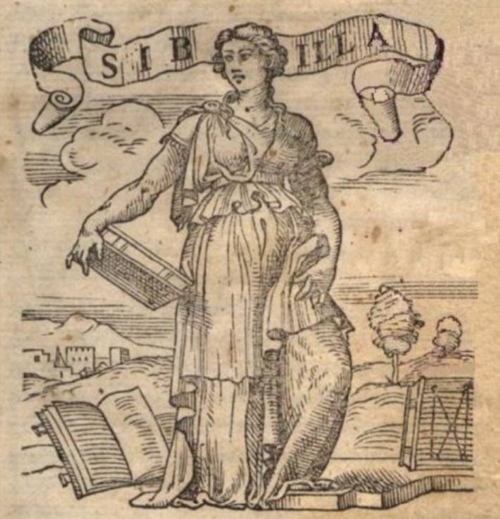

25 Sep 2015
A tradition from antiquity
What is a "Sibyl"? In the classical world, Sibyls were women bestowed with the gift of prophecy. They actually spoke on behalf and with the words of a god. Inspired by Apollo, the Sibyl of Delphi chanted the visions that seized her when asked for oracular responses. In Cuma, near Naples, another Sibyl had passed the wisdom contained in her books on to a Roman king, Tarquinius.
The Sibyls were generally considered as priestesses of Cybele, the Phrygian goddess worshipped as a life-giving mother to the earth, amidst the precipitous slopes and ravines of the mountains. The answers they provided were cryptic and easily misunderstood, as men liked to catch of their words just what they craved for within their soul.
Quoting from Varro, an ancient scholar whose work has gone lost, another renowned Latin author, Lactantius, reports that the Sibyls added up to ten. This is the classical list of Sibyls, including the Delphic, the Cumaean, the Tiburtine and others.
Early Christian writers, like Isidore of Seville, claimed that the Sibyls, pagans as they were, had anticipated the coming of Jesus on earth, by predicting the birth of the Son of God. That they would have achieved by using their foretelling faculties.
Yet something seems to be at variance with the classical list of oracular priestesses: in the fifteenth century, another Sibyl, apparently a new one, had made her appearance in a barren region of Central Italy.
That was the Apennine Sibyl. An enduring mystery whose spell is still alive in our present days.
Una tradizione risalente al mondo classico
Che cosa è una “Sibilla”? Nel mondo classico, le Sibille erano donne alle quali era stato conferito il dono della profezia. Esse parlavano nel nome e con le parole di un dio. Ispirata da Apollo, la Sibilla di Delfi cantava le visioni dalle quali era invasa quando richiesta di un responso oracolare. A Cuma, nelle vicinanze di Napoli, un'altra Sibilla aveva trasmesso la saggezza contenuta nei propri libri ad un re romano, Tarquinio.
Le Sibille erano generalmente considerate come sacerdotesse di Cibele, la divinità frigia celebrata come madre vivificatrice della terra, tra i pendii e i paurosi precipizi delle montagne. Le risposte da loro fornite erano enigmatiche ed equivoche, tanto che spesso gli uomini trovavano in esse semplicemente ciò che stavano già desiderando di ascoltare nel profondo del proprio animo.
Citando da Varro, un autore classico la cui opera è andata oggi perduta, un altro famoso autore latino, Lattanzio, racconta che le Sibille erano dieci. Si tratta della famosissima lista delle dieci Sibille classiche, che include la Delfica, la Cumana, la Tiburtina e altre.
Gli apologeti cristiani, come Isidoro di Siviglia, affermavano che le Sibille, benché pagane, avessero annunciato in anticipo l'arrivo del Cristo sulla terra, predicendo la nascita del Figlio di Dio. In ciò, esse avrebbero fatto uso delle loro capacità di preveggenza.
Qualcosa, però, sembra non trovare corrispondenza nella lista classica delle sacerdotesse oracolari: nel quindicesimo secolo, un'altra Sibilla, apparentemente una nuova Sibilla, aveva fatto la propria apparizione in una sperduta regione dell'Italia centrale.
Si trattava della Sibilla Appenninica. Un mistero che dura da secoli, e il cui incantesimo è ancora vivo ai nostri giorni.
